

ALA MOANA CENTER, 808 791 4000 ROYAL HAWAIIAN CENTER, 809 931 6900 HARRYWINSTON.COM

© 2019 Harry Winston SA. HARRY WINSTON EMERALD










 ALA MOANA CENTER ROYAL HAWAIIAN CENTER
ALA MOANA CENTER ROYAL HAWAIIAN CENTER


As active, creative, and progressive citizens, we are constantly inhabiting new and unique spaces. Some of these spaces we find as they are: A tranquil forest or isolated surf break require nothing of us. We are simply allowed to exist in them. Other spaces we create: A house has to be built with the necessary materials, and it takes time and memories before that house feels like a home. There are also intangible, unseen spaces: We re-enter the past through artifacts and historical knowledge. In the mundane moments of our day, we get lost in our imaginations.
Every day, we transit through multiple spaces. Many of these become familiar to us with routine, but every once in a while we travel to new cities and countries, resting our eyes on scenes previously unseen. With time, the spaces we find ourselves in change and we with it.
In this tenth issue of Palm, we wanted to visit and experience some of these spaces. Photographer Phil Jung takes us to the Honolulu Zoo where humans and animals cross paths. We tune our ears to the music of the Honolulu Symphony at Neal S. Blaisdell Center, a well-known gathering place for many occasions. In our conversation with interior designer and artist Nalani Sato, she gives advice on how to make a space your own. Flip to our “Escapes” section and explore Italy and Kure Atoll for a change in scenery.
As you learn about the spaces in this issue, we hope you’ll be more aware of the ones you encounter in your every day. Walk a little slower, take in the senses, dream of other spaces, and most importantly, leave things better than you found them.
活動的かつクリエイティブで進歩的な市民として、私たちは常に 新しく独創的な空間を求めています。静かな森やほかに誰もいな い海辺など、ただそこにあって私たちを迎えてくれる空間もあれ ば、私たちの手で創り出す空間もあります。たとえば家は資材を 集めて建てる必要があり、そこに住む人が長い時をかけて多くの 思い出を紡ぐことで「わが家」になっていきます。また、空間の中に は手で触れることも見ることもできないものもあります。遺物を 前にし、歴史の記憶をたどるとき、私たちの前には過去という空 間が広がりますし、日常の中でもふと想像の世界に遊んでいるの に気づくことがあります。
私たちは毎日、さまざまな種類の空間を旅しています。その 多くは見慣れたものですが、初めての都市や国を訪れるときには 見たことのない景色に目をみはります。どんな空間も、その中にい る私たちと共に時を経て変わっていくものです。
第10号を迎えた今号のPALMマガジンでは、そんな空間 をいくつかご紹介しています。フォトグラファーのフィル・ジャンさ んのレンズを通したホノルル動物園は、人と動物の視線が交差す る空間です。市民の集いの場であるニール・ブレイズデル・センタ ーではホノルル交響楽団の音楽に耳を傾け、インテリアデザイナ ーでアーティストのナラニ・サトーさんには、空間を自分のものに するためのアドバイスを伺いました。「エスケープ」のセクションで は、はるかなイタリアの街、そして太平洋の真ん中に浮かぶクレ 環礁を探検します。
今号の多彩な記事をお読み頂いた後で、毎日目にする空 間に新鮮な目を向けていただければ幸いです。いつもより少しゆ っくりと歩き、感覚を研ぎ澄ませて、まだ見ぬ空間に思いを馳せ てみてはいかがでしょう。これから訪れる空間を、さらにより良い ものにしていくために。
14 LETTER From the Developer











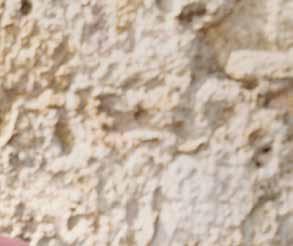

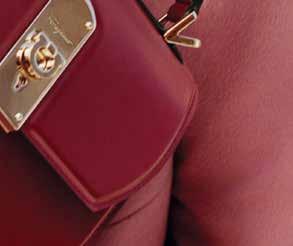

ALA MOANA CENTER FERRAGAMO.COM
CEO & PUBLISHER
Jason Cutinella
CREATIVE DIRECTOR
Ara Laylo
EDITORIAL DIRECTOR
Matthew Dekneef
MANAGING EDITOR
Lauren McNally
SENIOR EDITORS
Anna Harmon
Rae Sojot
PHOTOGRAPHY DIRECTOR
John Hook
PHOTOGRAPHY EDITORS
Samantha Hook
Chris Rohrer
TRANSLATIONS
Japanese Yuzuwords
Korean AT Marketing
PUBLISHED BY: NMG Network
36 N. Hotel St. Ste. A Honolulu, HI 96817
CREATIVE SERVICES
Tammy Uy VP Creative Development
Shannon Fujimoto Creative Services Manager
Gerard Elmore
Lead Producer
Shaneika Aguilar
Kyle Kosaki
Rena Shishido Filmmakers
Michelle Ganeku
Skye Yonamine Designers
Aja Toscano Creative Producer
Kimi Lung Web Designer & Developer
ADVERTISING
Mike Wiley VP Sales mike@nmgnetwork.com
Phil LeRoy National Sales Director
Chelsea Tsuchida Key Accounts & Marketing Manager
Helen Chang Marketing & Advertising Executive
Kylee Takata Sales Assistant
OPERATIONS
Joe V. Bock Chief Revenue Officer
Francine Naoko Beppu Network Strategy Director
Gary Payne VP Accounting
Courtney Miyashiro Operations Administrator
PALM is published exclusively for: The MacNaughton Group & Kobayashi Group © 2019 by Nella Media Group, LLC. All rights reserved. No part of this publication may be reprinted without the written consent of the publisher. Opinions are solely those of the contributors and are not necessarily endorsed by NMG Network.
16
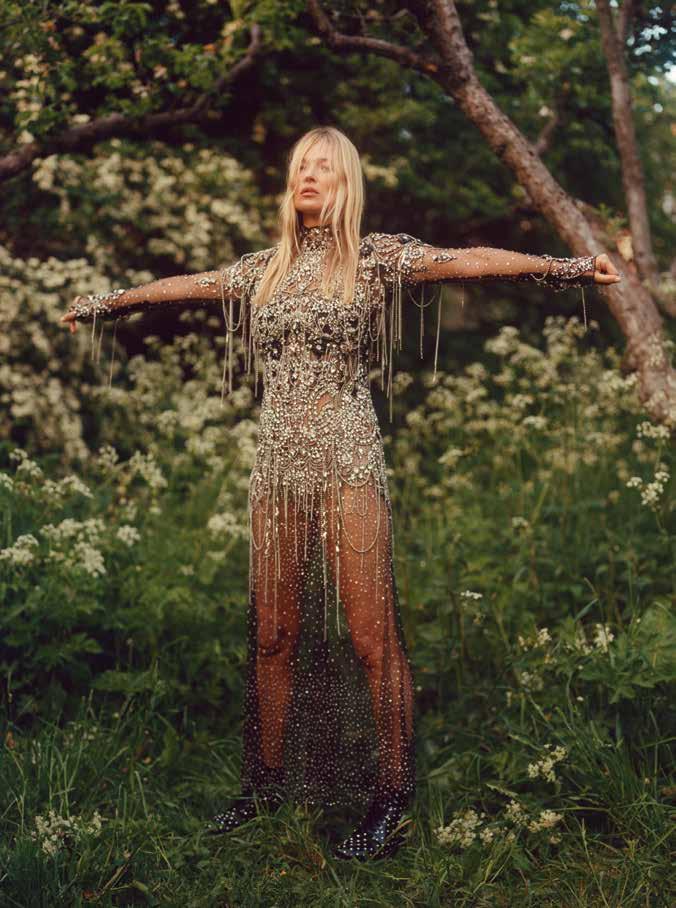


18 TABLE OF CONTENTS ARTS 24 Stoked Sculptures 34 Through the Looking Glass BUSINESS 48 Opening Night CULTURE 62 The Guardians 74 A Timeless Gown DESIGN 84 Designing Women 98 Artist in Residence 112 In the Heights ESCAPES 130 Italy in Inverno 140 Restoring Kure 130 98 ON THE COVER
Jyoti Mau is photographed by Bailey Rebecca Roberts in Pacific Heights on O‘ahu.





































































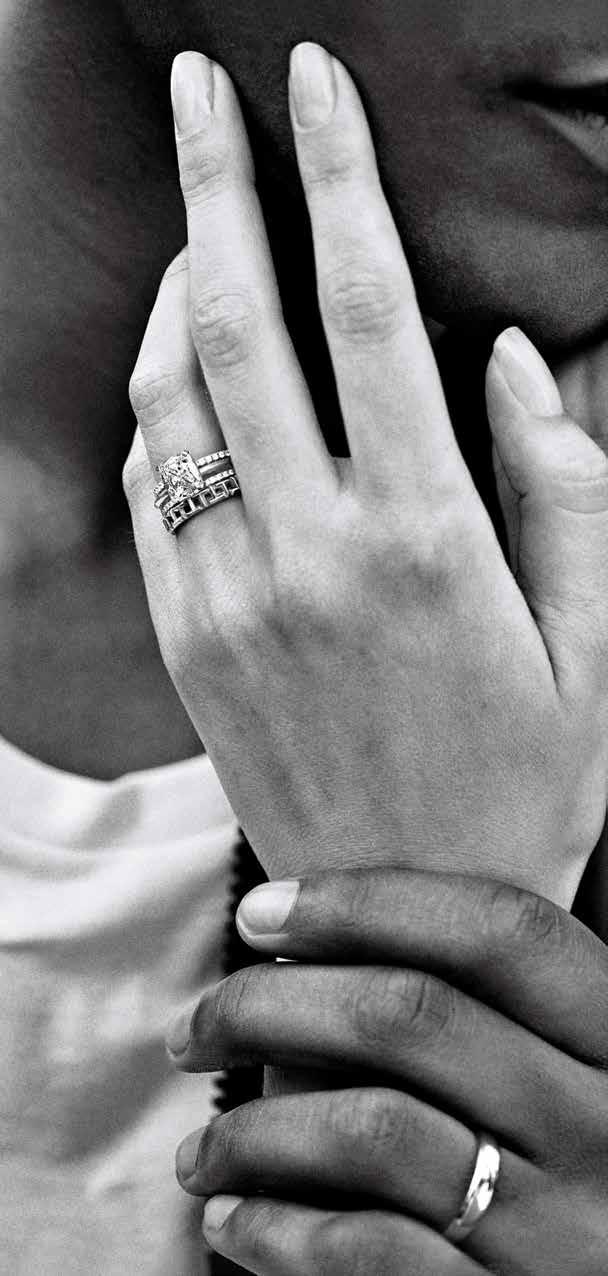



20 84 112 目次 アート 24 レガシーと彫刻 34 鏡の国の風景 ビジネス 48 オープニングナイト 文化 62 水の守護者 74 時を超えるガウン デザイン 84 デザインの女性旗手たち 98 アーティストの家 112 高所で エスケープ 130 インヴェルノ —
140 クレ環礁の自然を復元する
冬のイタリア
表紙 TKハワイ島ワイ
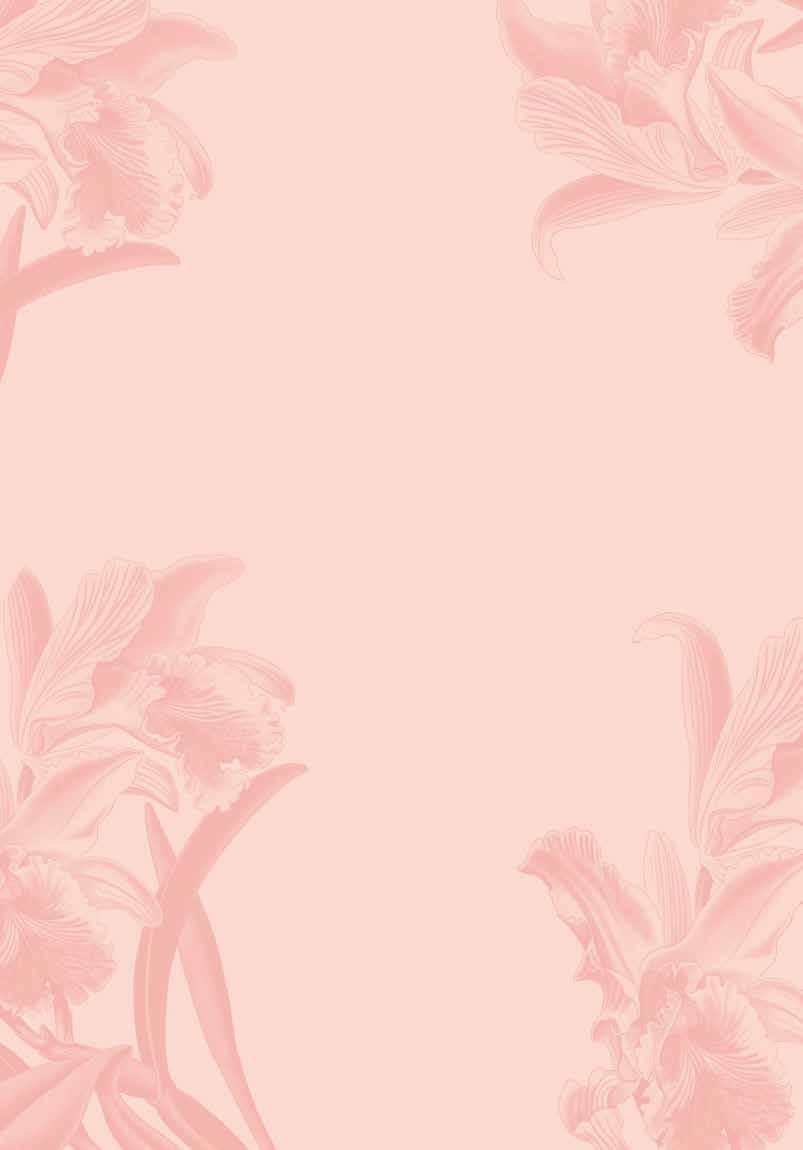

PERFECT
Introducing Cattleya — Halekulani's elevated but easygoing wine bar where good conversation is one of the best partners for your wine. COMPLIMENTARY PARKING | 8 55 . 73 8. 49 66 | 2199 KALIA ROAD, HONOLULU | WWW.HALEKULANI.COM
PAIRING
notions
AR TS
that amplify
A PALM アート
Visual
TU RE
the soul of the city
PALM PALM A
23
CUL
of place that A sense fosters the human spirit
Stoked Sculptures
Text by Christian Cook
Images by Joey Trisolini and courtesy of the Gagosian Gallery and Herbie Fletcher


24 A ARTS Herbie Fletcher PALM
レガシーと彫刻
ン・ギャラリーおよびアーティスト提供
文 = クリスチャン・クック 写真 = ジョーイ・トリソリーニ撮影、ガゴシア


Artist and surf magnate Herbie Fletcher has always found an outlet in turning high-performance surfing into artworks.
アーティストでありサーフィン界の重鎮でもあるハービー・フレッチャーさんは、ハイパフォーマンスサーフィ ンをアート作品に変えることに情熱を見出してきました。
예술가이자 서핑 대기업 인 Herbie Fletcher
는 항상 고성능 서핑을 예술 작품으로 바꾸는
혁신적인 아이디어를 찾았습니다. Fletcher
는 60 년에 걸친 경력을 통해 오아후 노스
쇼어에서 끊임없는 영감을 받았습니다.

Herbie Fletcher’s textured sculptures and colorful paintings reflect the viewpoint of a young surfer arriving on O‘ahu’s legendary North Shore for the first time: palm trees framing backlit silhouettes of surfers on waves at Pipeline, Sunset, Waimea, Rockies, always with the backdrop of a deep-orange sunset. Throughout his career, which has spanned six decades, Fletcher has drawn constant inspiration from the North Shore. Since moving to Hawai‘i in 1964 at age 16, he’s created films, photographs, surf brands, paintings, and surfing technology. Through his art, Fletcher communicates his dreams, memories of tripping on acid, and hazy golden-hour surf sessions in a visceral fashion. These experiences reemerge in chromatic forms on canvas, colorfully hued and with a sense of depth, pigments imbued within layers of resin. For one of his sculpture series, “Wrecktangle,” Fletcher salvaged
ハービー・フレッチャーさんの質感に富んだ彫刻や色彩豊かな絵画には、オアフ 島のサーフィンの聖地であるノースショアに初めてやって来た若きサーファーの 目にうつる世界が反映されている。パイプライン、サンセット、ワイメアやロッキー といった有名ポイントの波に乗るサーファーたちの姿が逆光に浮かびあがり、そ の光景をヤシの木が囲む。そして背景にはいつも深いオレンジ色の夕日が輝いて いる、そんな世界だ。
フレッチャーさんは60年にわたるキャリアを通して、常にノースショアから インスピーションを得てきた。1964年に16歳でハワイに移住して以来、フレッチ ャーさんは映画、写真、サーフブランド、絵画、そして広く普及することになったサ ーフ技術を生み出し、アートを通じて自分の夢や、LSDによる幻覚体験の記憶、 おぼろに霞む夕暮れ時のサーフセッションなどを体感的に表現してきた。そうし た体験は、色彩に富んだいろいろな形となってキャンバスの上で蘇り、幾層にも 重ねられたカラフルな樹脂が深みを感じさせる。彫刻シリーズの中の『Wrecktangle』という作品には、パイプラインにある例の有名なVolcomハウスの庭か
PALM
26 A ARTS
Herbie Fletcher



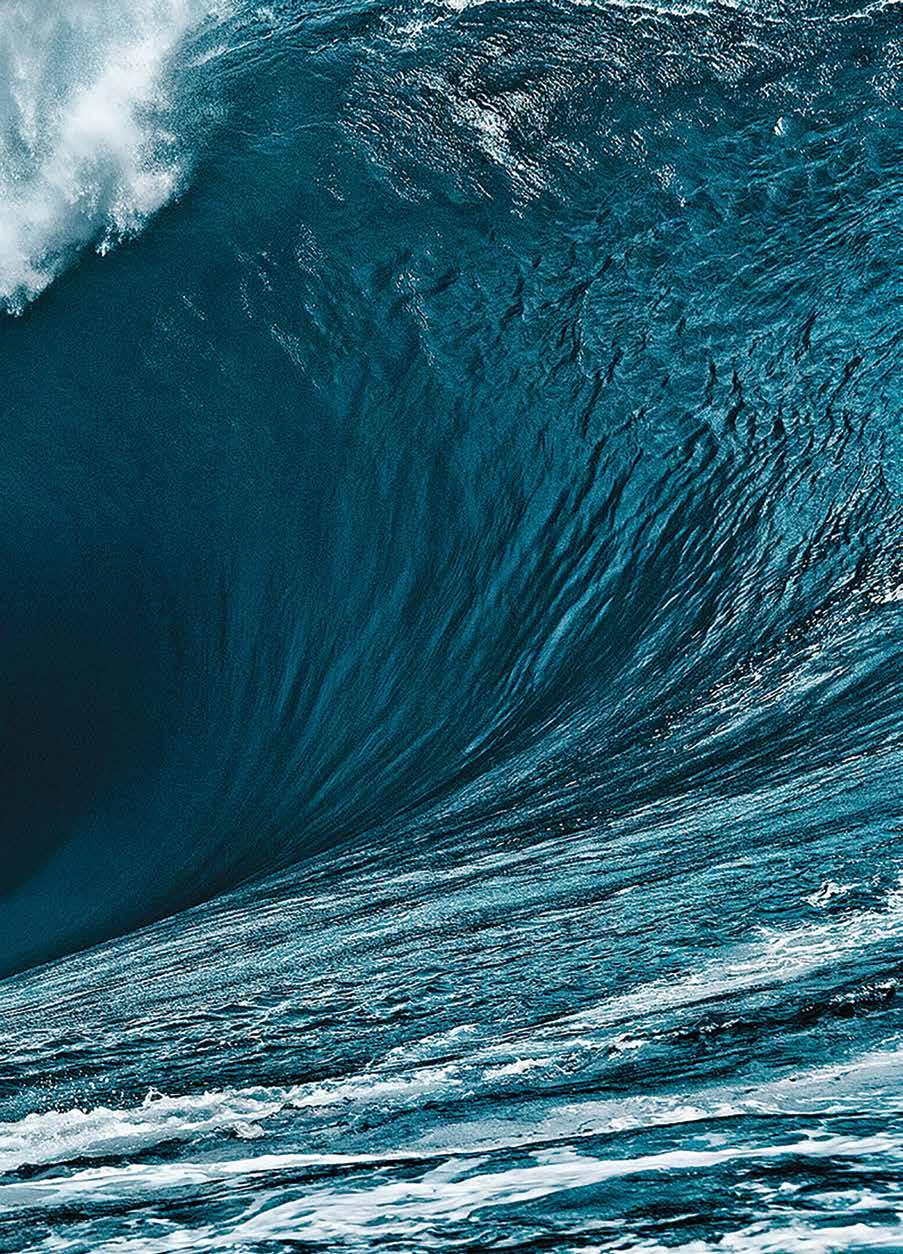


Throughout his 60-year spanning career, Herbie Fletcher has drawn constant inspiration from the North Shore.
graffitied and decal-laden boards from the yard of the notorious Pipeline House. By combining discarded pieces of broken surfcraft he has collected over decades, Fletcher has also created artworks that reference his own influences on the sport.
Already shaping surfboards as a teenager in California, Fletcher began experimenting with the craft’s component materials in his artwork, creating his first resinbased painting in 1966. A year later, Fletcher befriended a fellow young surfer and artist from Brooklyn, Julian Schnabel, at a contest in Padre Island, Texas. Schnabel would go on to be a world-famous painter and filmmaker. Neither of them realized it at the time, but their burgeoning friendship would set a life trajectory for both men. Inspired by each other’s attitudes and skills, Fletcher would teach Schnabel how to surf better, and Schnabel in turn would teach Fletcher how to be a better artist.
Fletcher’s technical contributions to surfing culture are paramount. Constantly inspired since moving to O’ahu as a teenager looking for the best surf in the world, his ideas have remained current in the ever evolving sport. He was one of the pioneers of big-wave tow-in surfing, he ushered in a longboard surfing renaissance after the 3-finned “thruster” shortboard became the norm for pros, and he popularized Astrodeck, a polyurethane foam pad to be glued onto surfboards. These pads introduced a new level of traction to the sport at a time when surfers could only rely on wax to stick them to their boards. The textured stomp pad
ら拾ってきた、落書きだらけでステッカーがべたべ たと貼られたボードが使われている。
フレッチャーさんが過去数十年間に集めてき た、壊れて捨てられていたサーフボードの破片を組 み合わせて作る作品には、サーフィンというスポー ツに自分が残してきた影響が描き出されている。す でに10代の頃カリフォルニアでサーフボードシェイ パーだったフレッチャーさんは、ボードの構成材料 をいろいろ使ってみる実験を始め、1966年に最初 の樹脂を使った絵画を制作した。その1年後、テキ サス州パードレ島でのサーフィン大会で、サーファー でありブルックリン出身のアーティストだったジュリ アン・シュナーベルさんと知り合い、友人になった。 シュナーベルさんはその後、世界的に有名な画家兼 映画監督になる。当時2人は知る由もなかったが、 急速に深まった友情が双方の人生の道筋を決める ことになった。フレッチャーさんはシュナーベルさん にサーフィン技術を教え、シュナーベルさんはフレッ チャーさんにアーティストとしての向上の仕方を教 えた。
世界最高の波を求めて1964年にオアフ島に 移住して以来、フレッチャーさんはサーフィン文化に 傑出した技術的貢献をしてきた。トーインサーフィン でビッグウェーブに挑んだ先駆者のひとりであり、 プロの間で「スラスター」と呼ばれるフィン3本のシ ョートボードが一般化した後でロングボードサーフ ィンを復興させ、さらにサーフボードに接着剤で貼 るポリウレタンフォームパッド「アストロデッキ」を普 及させた功労者でもある。このパッドは、サーファー たちがワックスに頼るしかなかった時代に、新たな レベルのグリップをもたらした。「ストンプ(踏みつけ る)パッド」と呼ばれるこのテクスチャー加工された パッドは、ボードのテールに貼られ、その上にサーフ ァーが足を乗せて体重をかけることで、力強くカー ビングやポンピングができる。このイノベーションの おかげで、サーファーたちはスケートボードのトリッ
PALM
30 A ARTS Herbie Fletcher


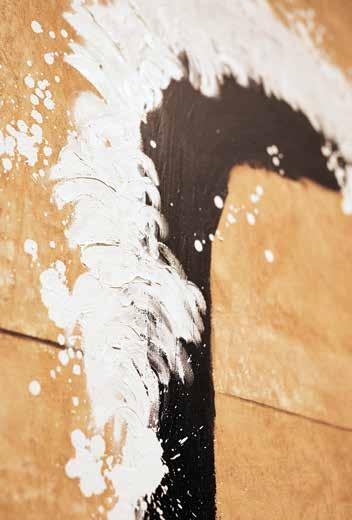
Since moving to Hawai’i in 1964 at age 16, he has created films, photographs, paintings, and innovations in surfing technology.
sits on the tail of the board, an area where surfers can stomp (hence the name) with force to carve and pump through sections of surf. The innovation allows surfers to bring skateboarding tricks into wave riding: 360 airs and ollies that would’ve been near impossible without the leverage offered by these surfboard accessories. Astrodeck pads appear in nearly ever surfer’s quiver, and are a hallmark in Fletcher’s “Wrecktangles,” tying this commercial product to its creator’s artistic endeavors.
Fletcher has made works that capture a modern perspective on surfing, relating the past to the present and commenting on the future of surfing culture. Fueled by passion, Fletcher has built a legacy that will live on in the toes that grip tight to stomp pads, in the whiteknuckled grips of surfers being towed into impossibly large waves at Pe‘ahi. It will continue in every grom trying their first air at ‘Ehukai, pumping down the line towards the Volcom Pipeline house, where you can still find him and friends watching the surf. In his paintings and sculptures, Fletcher will continue to communicate a hyperkinetic, well-lived life, documented in photographs, movies, in sculptures and in paintings.
クを波乗りに応用できるようになった。こうしたサー フボードアクセサリーが提供するレバレッジなくし て、サーフィンで「オーリー」や「360エアー」を実現 するのは不可能だっただろう。アストロデッキパッド をつけたボードは今やサーファーならほとんど誰で も持っているというくらいに普及しており、フレッチ ャーさんの作品『Wrecktangles』の主役にもなっ ている。
フレッチャーさんがこれまでに作った作品は、 サーフィンに対する現代的な視点を表現し、過去と 現在を結んで、サーフィン文化の未来についても語 りかけている。彼のアートの源泉は、自身が送ってき た充実した人生だ。それはこれからも彼の写真、映 画、彫刻、そして絵画の中で生き続ける。情熱に導か れてレッチャーさんが築いてきたレガシーは、足指 でストンプパッドをしっかりとつかむサーファーたち や、ペアヒの巨大な波にトーインされてゆくビッグウ ェーブサーファーたち、そしてエフカイで初めてのエ アーに挑戦し、フレッチャーさんと彼の友人たちが 波を眺めているVolcomハウスの方に向かってライ ンをポンピングしていくすべてのグロム(子どもサー ファー)たちが受け継いでいくに違いない。
PALM
32 A ARTS Herbie Fletcher

鏡の国の風景
Through the Looking Glass
文 = ナザレス・カワカミ
Artwork courtesy of Phil Jung and images by Chris Rohrer
写真 = クリス・ローラー、及びフィル・ジャン提供
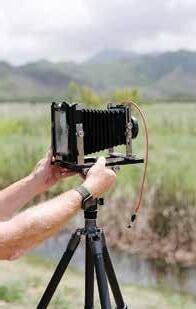
In Phil Jung's work, the photographer focuses on hidden subjects in their environment.

PALM
34 A
Text by Naz Kawakami
ARTS Phil Jung
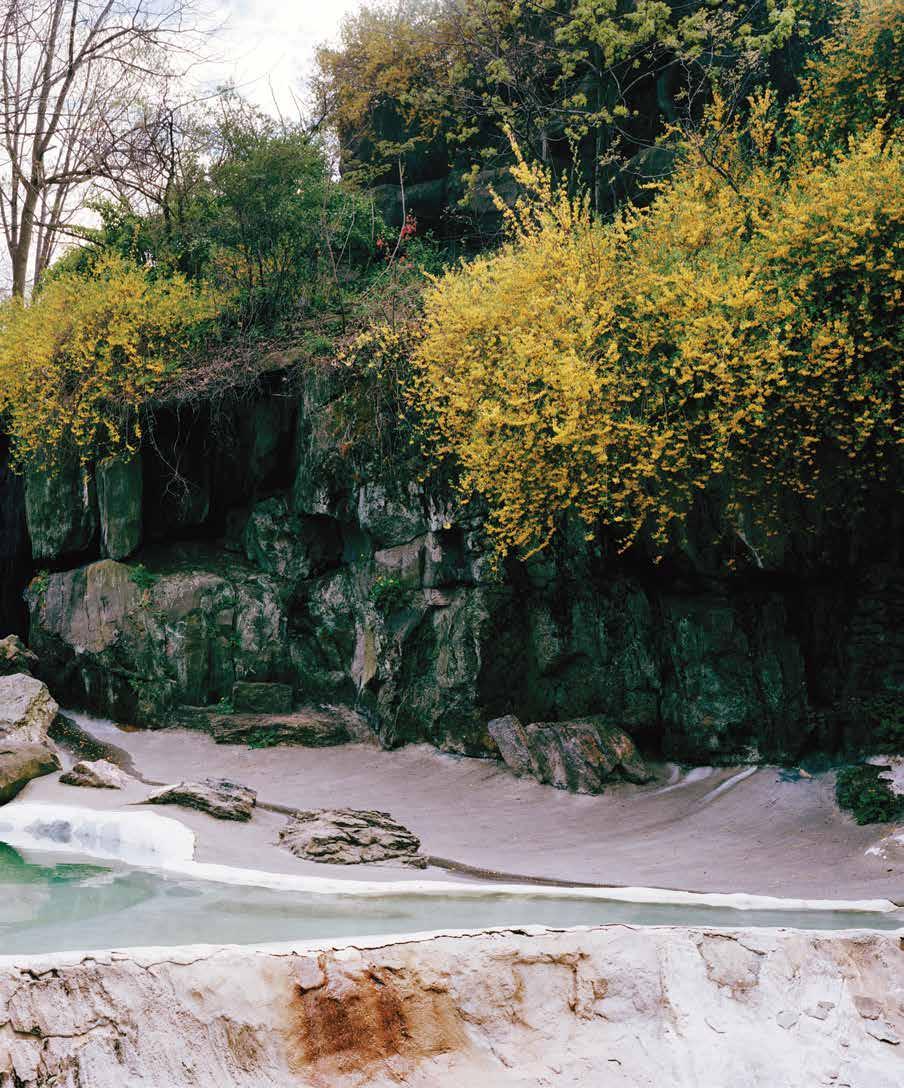
Phil Jung’s curious photographs peer into the personal spaces of everyone from city dwellers to zoo animals.
フィル・ジャンさんの写真には、都市生活者や動物園の動物たちのパー ソナルな空間のなかに覗き見た奇妙な世界が描かれています。
Phil Jung의 호기심 많은 사진은 도시인들부터 동물
원 동물에 이르기까지 모든 개인 공간을 들여다 봅니 다. "저의 일은 피사체없이 인물 사진을 만드는 것과 같습니다."그의 작품에 대해 구입한 분이 그 공간에
어떻게 공존하는지 궁금해했습니다."

For his film photography series Windscreen, photographer Phil Jung peered through the windows and windshields of vehicles across the United States. For more than a decade, he photographed what he thought to be the drivers’ most personal effects: photos of presumed loved ones on the dash, lotto tickets stashed in the side pocket, rosary beads scattered among spare change.
フォトグラファー、フィル・ジャンさんのフィルム写真シリーズ「Windscreen」 は、米国各地でフロントガラスや窓越しに自動車の車内を撮影した作品群だ。 大切な人の写真を飾ったダッシュボード。サイドポケットに突っ込まれた宝く じ。小銭と一緒に散らばるロザリオの数珠。10年以上にわたって制作したこの シリーズで、ジャンさんは、その車のドライバーたちにとってきわめてパーソナル な光景をカメラにおさめてきた。
PALM
36 A ARTS Phil Jung
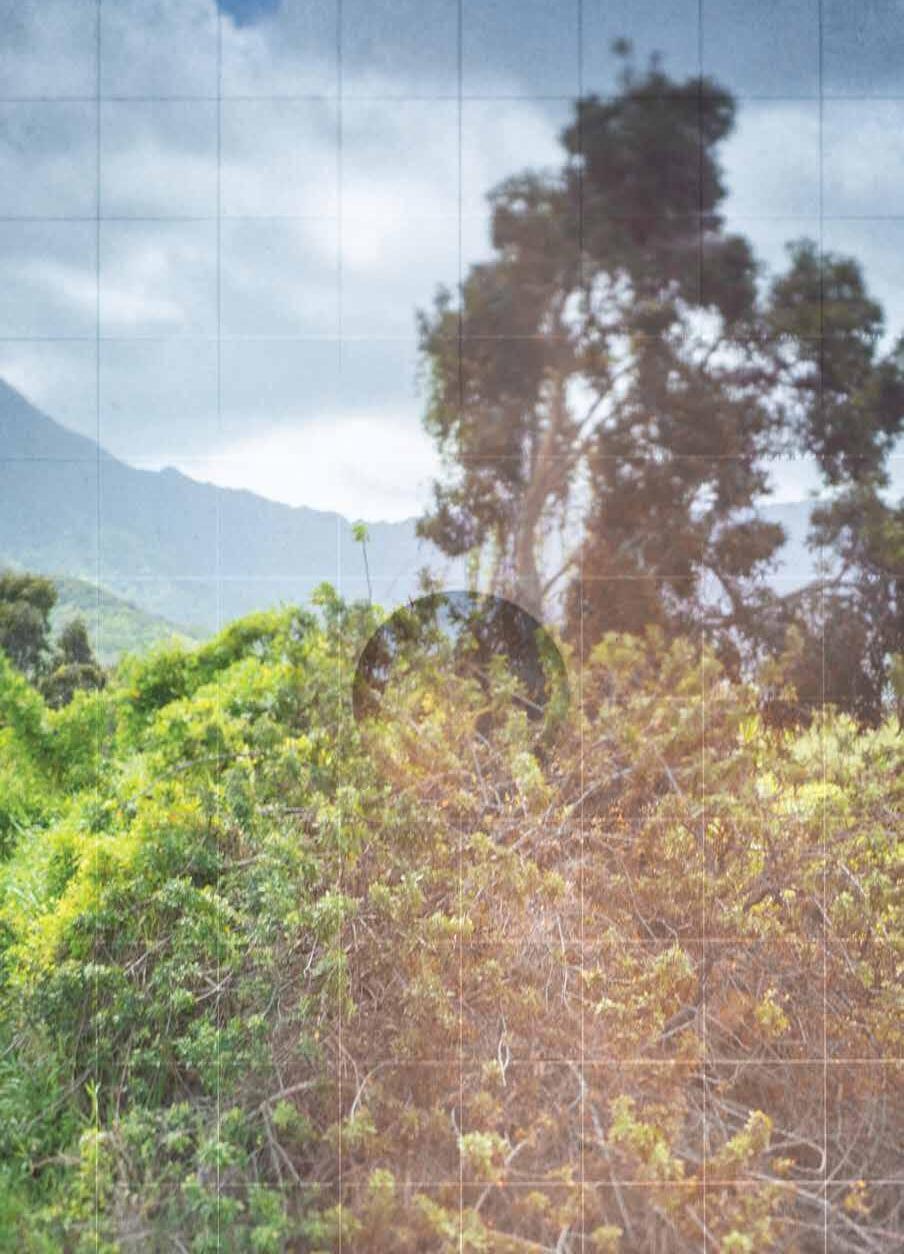



“It’s like creating a portrait without the subject,” Jung said of the series, “having a viewer wonder about that space and about what sort of person might inhabit it.”
Another of Jung’s ongoing projects, A Different Nature, applies the same inquisitive lens to the worlds created by zoos for the animals they house, emphasizing the eerie voyeurism of each exhibit. Jung’s photographs shift the focus away from the animals, concentrating on the artificial, replicated comfort of the environments that cage them. Take for example, a photo from A Different Nature, “Indoor Giant Panda Exhibit,” in which the enclosure’s three-dimensional rock wall collides with the two-dimensional wall painting, providing an illusion of the wall’s continuance into misty mountains. This photo captures a major theme of the series: the inherent conflict between nature and human attempts to replicate it. The spaces “blur the line between fact and fiction,” Jung wrote in his description of the series. “In many ways, they offer proof of our distorted and disconnected views of the natural world.”
Jung discovered his passion by chance through a photography elective he enrolled in for credits at the San Francisco Art Institute, from which he went on to earn a BFA. Since Jung received his MFA in photography from the Massachusetts College of Art and Design in 2009, his work has been featured in publications including the Boston Globe and Incandescent and presented in shows and galleries across the country.
Both Windscreen and A Different Nature are shot on 4-inch-by-5-inch color film negatives with an imposingly large Ebony camera, which allows Jung to capture the fine detail and complex color shifting throughout the exhibits. The antique camera, used by photographers of the 1960s rather than the iPhone-wielding picturetakers of today, has garnered Jung some strange looks. In a meta turn of events, Jung becomes just as much of a spectacle as the exhibits he photographs.
“People go from pointing their cameras at the animal, to pointing them at me, and then to whatever I’m photographing,” Jung said.
In 2014, Jung relocated to Honolulu to instruct photography students at the University of Hawai‘i at Mānoa. In the islands, he has continued to capture lives
「これは被写体のないポートレイトのようなものです。見る人はその空間 について思いをめぐらし、どんな人がそこにいたのか想像するんです」とジャン さんは説明する。
ジャンさんの別のシリーズ「A Different Nature」では、動物が居心地よく 過ごせるように工夫された動物園の囲いにレンズを向け、それぞれの囲いが持 つ不気味な覗き見趣味を強調している。写真の焦点を、動物そのものから、動 物のために人工的に再現された環境にシフトしているのだ。たとえば「ジャイア ントパンダの室内展示場」という作品は、岩の壁の隣に壁画が組み合されて、 壁が霧深い山々につながっているかのように見える囲いを撮影したもので、自 然と、それを再現しようとする人間の間の宿命的な行き違いという、このシリー ズの主題をよく捉えている。ジャンさんは自らのウェブサイトで、こうした空間は 「事実と虚構の境界線を曖昧にするもの」と解説している。「こういう空間は、 いろいろな意味で、我々の自然界に対する視点が歪み、つながりを失っている ことを証明しているのです」。
ジャンさんは、サンフランシスコ・アート・インスティチュートの美術学部に 在籍していた時にたまたま履修した授業がきっかけで、写真への情熱を見出し た。2009年にマサチューセッツ・カレッジ・オブ・アート・アンド・デザインで写 真の美術学修士号を取得した後、彼の作品は『ボストン・グローブ』紙や『イン カンデセント』誌で紹介され、米国各地の展覧会やギャラリーで展示されてき た。TMC+Kodak国際フィルム・グラントをはじめ、受賞経験も多い。
「Windscreen」も「A Different Nature」も、大判のエボニー・トラック 社のカメラを使い、4x5インチのカラーネガフィルムで撮影することで、作品全 体を通して精細なディテールと複雑な色味を出している。誰もがiPhoneで写 真を撮るのが日常となった昨今、1960年代に使われていたこのビンテージカ メラを構えるジャンさんには好奇の目が向けられる。カメラを持つジャンさん自 身が、作品と同じくらいに見ごたえのある存在なのだ。
「動物にカメラを向けていた人たちが、僕にカメラを向けて、さらには僕が 撮ってるものを撮り始めるんです」とジャンさん。
2014年にハワイ大学で写真を教えるためにホノルルに移住したジャンさ んは、引き続き、人々が生活する世界の精細なディテールをボストン時代以来 の覗き趣味的な視点を強調した撮影方法で捉えている。「Windscreen」も「A Different Nature」も、そこにいた誰かの影響が残る空間を描写しているが、 ガラス越しに(実際にも、またメタファーとしても)撮影された作品はいずれも
PALM
40 A ARTS Phil Jung
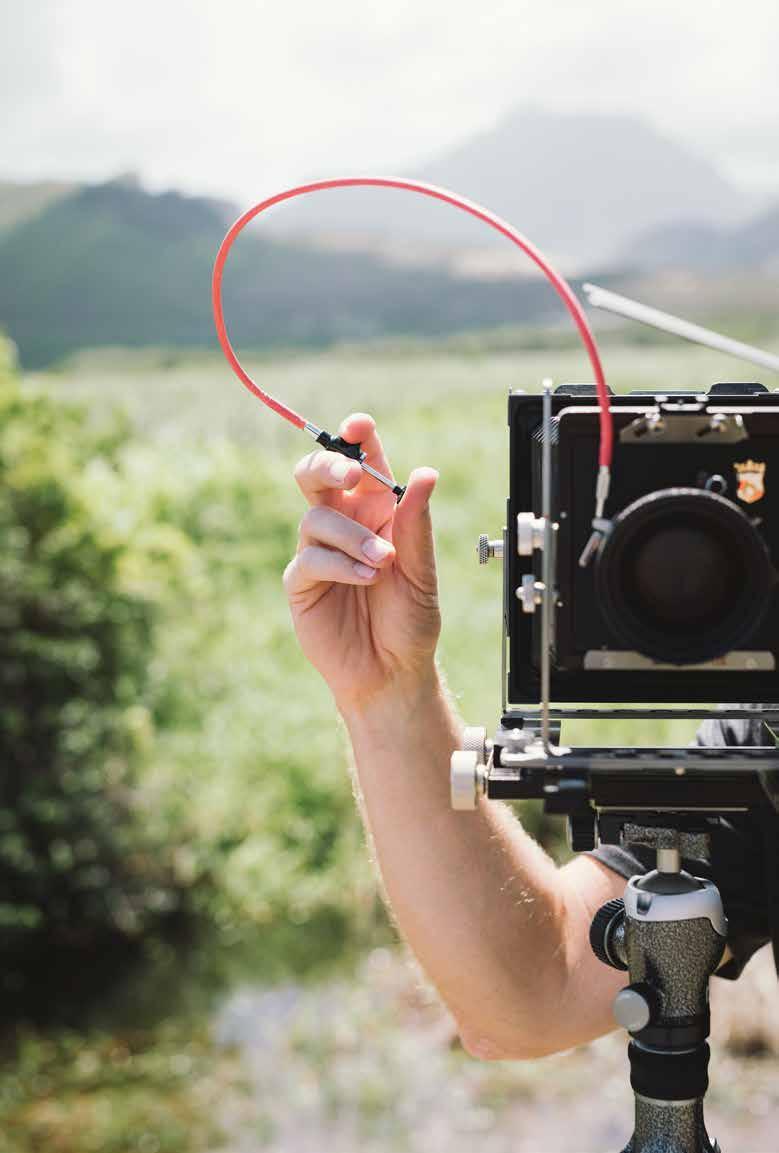

through details of the world within which they exist using the voyeuristic approach to shooting his subjects he began in Boston. Windscreen, as well as A Different Nature, depict spaces affected by those who inhabit them, but the photographs have a sterile quality, having been positioned from behind metaphorical and literal glass. “A lot has happened in these spaces, and the space has been altered,” Jung says. “There is a residue of human-animal existence, and I’m trying to capture that.”
This stylistic thread continues in his more recent work photographed in Hawai‘i, including City of Refuge, an exploration of the textured topography of rock surfaces, and
見る人に不毛な印象を与える。「そこでいろんなこ とが起き、その場所は変わったのです。そこには、人 や動物の存在の名残りがある。僕はそれを捉えた いんです」
ジャンさんの洗練された作風は最新シリーズに も引き継がれている。「Hawai‘i, City of Refuge」 シリーズでは岩の表面の質感を探求し、「Oahu」シ リーズでは観光業界が宣伝する理想像とは違うハ ワイの社会や文化の日常の姿を描く。
PALM
42 A ARTS Phil Jung
From Jung’s series, A Different Nature


his series Oahu, which is comprised of vignettes of island life and representations of Hawai‘i’s social and cultural norms that differ from the idealism of the tourism industry.
At a Honolulu reception for A Different Nature (or “my zoo work,” as Jung sometimes refers to the series), a viewer told Jung that his photograph of an indoor giant panda enclosure was “beautifully sad,” with its fluorescent lights and a mountain-scape painted on its walls. The photographer was struck by the comment. The melancholic appeal of the project was an unintended by-product, one that Jung has only recently come to recognize.
ジャンさんが「動物園の仕事」と呼ぶ「A
Different Nature」のレセプションがホノルルで 開催されたとき、鑑賞していた人の一人がジャンさ んに、壁に山の風景が描かれ、蛍光灯に照らされた パンダの室内展示場の写真は「美しくも悲しい」と 言ったそうだ。それを聞いたジャンさんは衝撃を受 けたという。このシリーズが持つメランコリックな 魅力は意図しなかった副産物で、それに気づいた のはごく最近なのだそうだ。
PALM
44 A ARTS Phil Jung

“It’s like creating a portrait without the subject,” Jung said of the series, “having a viewer wonder about that space and about what sort of person might inhabit it.”
Trends
BU SIN ESS
B PALM ビジネス
that drive
the economy
PALM PALM B 47
Opening Night
オープニングナイト
48 B BUSINESS Symphony PALM
Text by Greta Beigel オープニングナイト
Images by Marie Eriel Hobro オープニングナイト
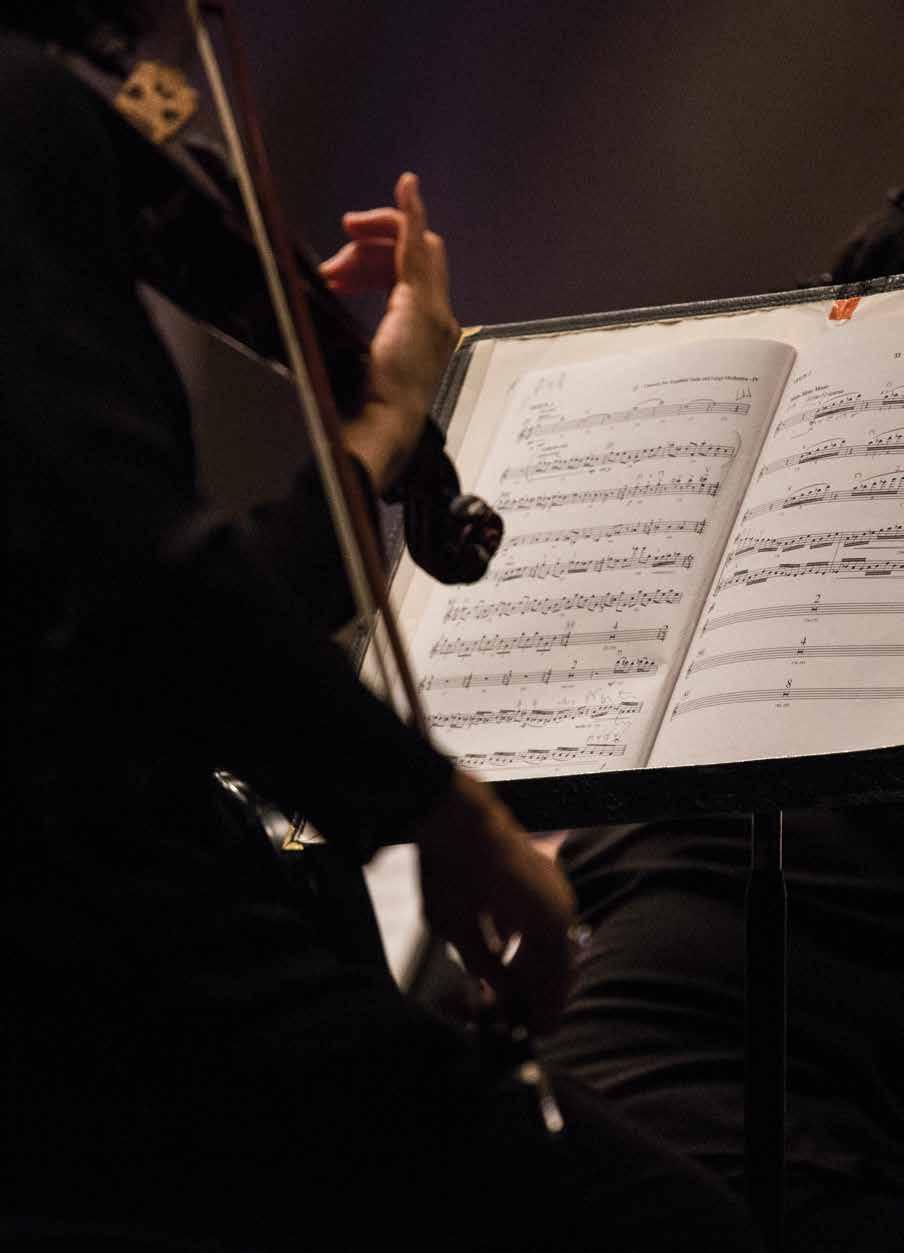
Get a glimpse at the inner workings of Hawai‘i Symphony Orchestra. う」とパリッシュさん。「もちろん、新たなオ ーディエンスを獲得する可能性だってある のですが」
2019-2020 시즌 오프닝
나이트에서 하와이 심포니
오케스트라의 내부
공연을 엿볼 수 있습니다.
무대 뒤에서 모든 일이 일어나도록하는 헌신적인 사람들을 만나십시오.
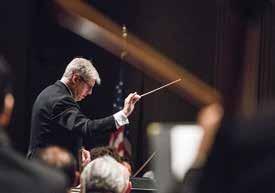
This is the plea of conductor, writer, and Hawai‘i Symphony Orchestra artistic advisor JoAnn Falletta in her poem “To the audience”: “Look at us as we play / We need witnesses to our music / We need witnesses to our lives / To tell us that they matter.”
Falletta, who is in her eighth season as the symphony’s artistic advisor and has been at the helm of the Buffalo Philharmonic since 1999, spends about three weeks in Hawai‘i, overseeing all auditions and hires, selecting repertory, and engaging soloists and conductors.
“We are very careful to get maximum return for our artistic budget,” says executive director Jonathan Parrish. “Sometimes young artists starting out require less of an investment; other times, we have some established fabulous artists. It is all about balance. So is choosing repertory, balancing the familiar and known with something new.”
With an annual operating budget of about $4.6 million, Hawai‘i Symphony Orchestra schedules 11 classical Halekulani Masterworks programs each season and offers diverse performances such as Holiday Pops, the Music of John Denver, and ever-popular Harry Potter nights. Sunday afternoon classics attract up to 1,400 patrons.
Yet while series subscriptions are increasing, Saturday night ticket stubs reveal 50 percent less occupancy than the popular Sunday performances. Major challenges also loom. In November 2020, the 22-acre Neil S. Blaisdell Center, where the symphony usually performs, is closing for redevelopment, a project expected to take about three years. During this time, the symphony will use alternative venues. “Some people may follow us wherever we are, others might not,” Parrish says. “Who knows, we could build new audiences.”
Marketing director Heather Arias de Cordoba remains ready to sign up new subscribers. At symphony concerts, she commands a table in the lobby stacked with colorful T-shirts she designed and registers assorted customer complaints, compliments, and inquiries. “We are doing patron outreach as we can,” she says.
With the advent of Hawai‘i Symphony Orchestra’s 2019-2020 concert season, Palm ventured behind the scenes to meet devotees responsible for making it all happen.
1999年からバッファロー・フィルハーモニー管弦楽団の音楽監 督を務めるファレッタさんは、数々のアルバム、ワールドプレミア の指揮やそれまでの常識を覆す公演プログラムなどで国際的に 高い評価を得ている。ホノルル交響楽団の芸術顧問に迎えられ て8年。ファレッタさんは毎年約3週間をハワイで過ごし、楽団の オーディションと採用をすべて監督するほか、レパートリーの選 曲、そして客演の指揮者やソリストとのやりとりもこなす。
楽団のエグゼクティブディレクター、ジョナサン・パリッシュ さんはこう語る。「芸術予算を最大限に活かすために、慎重に検 討します。あまり大きな投資を必要としないデビューしたての若 い演奏家を迎えることもあれば、著名なベテラン演奏家を迎え ることもあります。バランスが肝心なのです。選曲も同様です。よ く知られているものと、目新しいものをバランスよく選びます」
楽団の年間予算は460万ドル。年11回の「マスターワーク ス」公演に加えて、「ホリデーポップス」「ビリー・ジョエルの音楽」 「ジョン・デンバーの音楽」そして大人気の「ハリー・ポッター・イ ン・コンサート」といったプログラムもある。
日曜午後のコンサートは最大1,400名の観客を集める。で も、シリーズ公演の定期会員数は増えているにもかかわらず、土 曜夜のコンサートはキャパシティの半分しか集客できていない。
大きな課題も待ち受けている。約9ヘクタールの敷地を持つ ブレイズデルキャンパスは、2020年11月から約3年間、再開発 のため閉鎖される。楽団は工事期間中に公演できるホールを探 しているが、この間に客足が遠のく可能性もある。「どこに行こう とついて来てくださるお客様もいれば、そうではない方もいるで しょう」とパリッシュさん。「もちろん、新たなオーディエンスを獲 得する可能性だってあるのですが」
マーケティングディレクターのヘザー・アリアス・デ・コルド バさんは、新しい定期会員を常に待ち受けている。
コンサート ではいつもロビーに設置したテーブルに、楽団のロゴをあしらっ て自らデザインしたカラフルなTシャツを並べ、観客の称賛や苦 情、質問を受けつける。「できる限りお客様の声に耳を傾けてい ます。公演を楽しんでいただけたときにも、そうでないときにも、 私がその窓口になります」とデ・コルドバさん。
2019/2020年のシーズン開幕を迎えたハワイ交響楽団の 舞台裏を訪ね、公演を支える立役者たちに話を聞いた。
50 B BUSINESS Symphony
— JoAnn Falletta, "To the audience" “
Look at us as we play We need witnesses to our music We need witnesses to our lives To tell us that they matter ”

JONATHAN PARRISH
In 2013, Jonathan Parrish, a French horn player with substantial administrative experience in the arts was appointed executive director of the Hawai‘i Symphony Orchestra. In the ensuing years, he has emerged as a familiar figure, welcoming audiences to the concert hall from the stage.
Parrish is departing the Hawai‘i Symphony Orchestra in December to take up a similar post as executive director of the Maryland Symphony Orchestra but he has guided the orchestra in the start of its 2019-2020 season.
Credited with initiating the Hawai‘i Symphony Orchestra’s successful Music that Rocks series, Parrish says he’s banking on the lure of yet another creation, Films in Concert, to draw more audience members. In this new series, the orchestra will accompany screen favorites. This season, it is a Harry Potter venture.
“Films we choose have to have wide and broad appeal,” Parris says. He laughs. “They also must have a good score.”
ジョナサン・パリッシュ
フレンチホルン奏者であり、音楽分野の運営にも深くたずさわってきたジョナ サン・パリッシュさんは、2013年にハワイ交響楽団のエグゼクティブディレク ターに就任した。以来、コンサートホールを訪れた観客にも、舞台から歓迎の 挨拶をするパリッシュさんの姿はすっかりおなじみとなっていた。
しかし、2019/2020年のシーズン幕開け直前に、ショッキングなニュース が発表された。パリッシュさんが今年12月2日からメリーランド交響楽団のエ グゼクティブディレクターに就任することとなり、まもなく楽団を去るというの だ。
パリッシュさんは、ワシントンDCのケネディーセンター・オペラハウスでホ ルン副首席奏者を4シーズン務め、メリーランド交響楽団では首席奏者を務め た。1998年にホノルル交響楽団に入団した後、チェンバーミュージック・ハワ イのゼネラルマネージャーに指名され、以降11年間その任に就いてきた。
実業家や音楽家、そしてハワイ交響楽団の理事らが現在、パリッシュさん の後任を探している。
ハワイ交響楽団の大ヒットプログラム「ミュージック・ザット・ロックス」の仕掛 け人でもあるパリッシュさんは、『ハリー・ポッター』をはじめとする人気映画の 音楽を取り上げる「フィルムズ・イン・コンサート」という新しいプログラムも観 客を惹きつけるだろうと見込んでいる。
「幅広い観客層にアピールする映画を厳選しています」とパリッシュさん は言い、笑ってつけ加えた。「もちろん、音楽が優れている作品に限りますよ」
52 B BUSINESS Symphony
 IGNACE “IGGY” JANG
IGNACE “IGGY” JANG
One hour before the conductor is due to give the downbeat to the Hawai‘i Symphony Orchestra, a far more casual collaboration begins to unfold on stage.
Concertmaster Ignace “Iggy” Jang, eschewing his customary tux and tails in favor of jeans and a shirt, emerges from the wings to assume his secondary role emceeing the orchestra’s pre-concert conversations. As is the custom, visiting soloist and conductor join him for the question-and-answer session.
Welcome to the Iggy half-hour, a time to tap the zeitgeist, probe the artist psyche, and with luck, resolve any angst du jour. Always self-deprecating, Jang cheerfully mocks his own occasional mispronunciation, even malapropism, while engaging his guests. “I try not to be too scripted,” he says. “I don’t consider myself a professional host. I have always considered myself an introvert, be it at home or with family or friends. For a long time, public speaking terrified me.”
His breakthrough came when he became involved in educational programs, largely with the Hawaii Youth Symphony, and felt compelled to converse with parents and audiences. Now, as happy host, he enjoys helping emerging young artists articulate a personal vision.
“Our show is a mixture of enlightenment, instruction, and entertainment,” Jang concludes. “We do not take ourselves too seriously.”
イグナス・(「イギー」)・ジャン
ハワイ交響楽団の公演1時間前。舞台では、本番の演奏よりもぐっとくだけ たセッションがはじまる。
コンサートマスターの「イギー」・ジャンさんは、演奏会用の燕尾服姿で はなくジーンズにシャツといった出で立ちでステージに登場する。「コンサ ート・カンバセーション」の司会という、彼のもう一つの役割を務めるため だ。このプログラムは客演のソリストや指揮者が登場する質疑応答セッショ ンで、開演前の恒例となっている。
イギーさんが時流に応じたトピックを取り上げ、演奏家たちの内面を探 る半時間ほどの「カンバセーション」は、演奏家の緊張をほぐし、懸念を解 消することもある。いつも謙虚なイギーさんは、ゲストとのやりとりの中で名 前の発音を間違えたり、言葉を誤用したりしたことを屈託なく笑いながら 打ち明けた。「台本はなるべく使わないようにしています。僕はプロの司会じ ゃありません。自宅でも、家族や友人たちといる時でも、自分はむしろ引っ込 み思案な性格だと考えていました。長いあいだ、人前で話すのは大の苦手 だったんです」とイギーさん。
そんな彼が殻を破ることになったのは、ハワイ・ユース・シンフォニーを 中心とする教育プログラムにかかわるようになり、親たちや観客と対話をす る必要に迫られてのことだった。今では司会の役割を楽しみながら、新進の 若い演奏家たちが音楽のビジョンを言葉で表現するのを手伝うのが楽し いそうだ。
「啓蒙活動、コンサートの説明、そしてエンターテインメントを兼ねた プログラムです」とイギーさん。「肩に力を入れすぎないようにしているんで す」
HEATHER ARIAS DE CORDOBA
As director of marketing for the Hawai‘i Symphony Orchestra, Heather Arias de Cordoba is a virtual polymath. She creates radio and television advertisements, helps design season brochures and flyers, and puts together silent auction packages.
A maven of social media, de Cordoba handles all online postings, and she boasts of attracting more than 10,000 followers to the orchestra’s Facebook page. She also thrills that a $500 investment in announcing the upcoming Harry Potter concerts translated into 1,900 tickets sold.
Mostly, her position mandates fostering brand awareness, such as the catchphrase “music builds community.” “Our musicians perform in Chamber Music Hawaii, Hawaii Opera Theatre, also Ballet Hawaii,” de Cordoba says. “The symphony draws many entities together and gives them life. There is a big community here, with the [symphony] at the center of it all.”
ヘザー・アリアス
ハワイ交響楽団のマーケティング担当ディレクター、ヘザー・アリアス・デ・コルドバ さんは、八面六臂の活躍ぶりだ。ラジオやテレビの広告を作成し、定期演奏会のパ ンフレットやチラシのデザインを手伝い、サイレントオークションの賞品取りまとめ もこなす。
ソーシャルメディアの達人で、インターネット上の投稿を一手に引き受ける彼女 は、楽団のFacebookページに1万人以上のフォロワーを獲得したという。今シー ズンの『ハリー・ポッター』コンサートの告知に投資したのはわずか500ドルだが、 その効果でなんとチケットが1,900枚も売れたそうだ。
デ・コルドバさんの主な使命はブランド認知の促進。「『音楽がコミュニティを築 く』が、現在の楽団のスローガンです。楽団員たちは、チェンバーミュージック・ハワ イやハワイ・オペラシアター、それにバレエ・ハワイでも演奏しています。ハワイ交響 楽団は、多くの団体をまとめて息を吹き込む存在です。ハワイ交響楽団を中心とし た大きなコミュニティがあるのです」
MERLE BRATLIE
When Merle Bratlie first visited Hawai‘i in 1990, he attended a performance by the Honolulu Symphony. “I was so impressed, especially with intermission,” says Bratlie, who for 25 years worked in artist services for the Houston Symphony. “When the side doors opened, and all the ladies in mu‘umu‘u walked out onto the lawns, I thought, ‘Oh, how beautiful.’ In Houston, if you go outside the hall into the heat, it means you are probably leaving.”
Four years ago, Bratlie was hired as general manager of the resurrected Hawai‘i Symphony Orchestra. While Bratlie participates in season planning, his focus includes meet-and-greets at the airport, where he presents artists with welcome packages from the Symphony’s board that include chocolates, personal schedules, invites, and, most valued of all, orchestral scores supplied by the music librarian for immediate use. Bratlie whisks classical musicians directly to rehearsal or accommodations at Halekulani; he drops pop and rock performers off at Sheraton Waikiki.
“A long time ago, I realized I have the easy job. I don’t have to go out on stage and perform,” Bratlie says. “I am so heartened by what this organization can do. The orchestra has such an important place in this community. We are not just a beach community. We have a lot of people who have musical and intellectual pursuits.”
マーレ・ブラットリー
マーレ・ブラットリーさんは初めてハワイを訪れた1990年にハワイ交響楽団の公 演を聴きに出かけた。ヒューストン交響楽団で25年間、演奏家接遇のキャリアを積 んだブラットリーさんは、「特に印象深かったのは休憩時間でした」と打ち明ける。「 ホール横の扉が開け放たれ、ムウムウに身を包んだ女性たちが芝生の庭に出て行く のを見て、なんて素晴らしい、と思いました。ヒューストンでは、コンサートホールか ら外の暑さの中に出て行くのは、帰る人だけですからね」
4年前に新生ハワイ交響楽団のゼネラルマネージャーに就任したブラットリー さんは、シーズンの企画立案にも加わるが、もっとも大切な仕事は客演の指揮者や ソリストの空港での出迎えだ。楽団の理事会から演奏家に贈るウェルカムパケット の中には、チョコレートや個別の日程表、招待状などをそろえる。なかでも最も大切 で、すぐに必要とされるのは、楽団のライブラリアンが用意した譜面だ。空港からは リハーサルに直行する場合もあるし、そうでなければクラシックの演奏家はハレク ラニ、ポップスやロックのパフォーマーはシェラトンワイキキに送り届ける。
「私の仕事なんて楽なものだと、ずい分前に気づきましたよ。ステージに上がっ て演奏しなくても良いのですからね」とブラットリーさん。「楽団が持つ影響力を考 えると嬉しくなります。ここハワイで、この楽団はとても大切な存在なのです。ハワイ にあるのはビーチだけではありません。音楽の世界や、知的好奇心を追い求める人 もたくさんいるのです」
54 B BUSINESS Symphony PALM
 ANDREA SNYDER
ANDREA SNYDER
“When people come to a concert, they are so excited,” says longtime Hawai‘i Symphony Orchestra Associates member Andrea Snyder. “Our job is to help them have a personal connection to the orchestra.”
Dues-paying associates members distribute flyers, greet concertgoers at an outreach table, and generally assist the marketing team. The group also sets ups booths at senior expos and farmer’s markets and assists with an annual Thanksgiving dinner for musicians and families. Benefits of membership may include free concert tickets as well as invites to rehearsals and receptions.
After lunching at an open-air restaurant at Halekulani, more than 30 associates, including Snyder, amble along a path to a nearby conference room at the hotel. They have come to be congratulated for getting the word out about the orchestra’s classical, pop, and rock offerings. Mostly, volunteers anticipate a cheery talk about upcoming programs from JoAnn Falletta.
Snyder, who volunteers for numerous organizations, traces her yen for service to a childhood spent pitching in at the family business, a small department store in Dover, Delaware. “I feel as though the [Hawai‘i Symphony Orchestra] is a kind of family concern,” Snyder says. “I love music, and it is so rewarding to share something I am passionate about. With the associates, there is a chance to feel connected to the community. There is a nice camaraderie.”
「コンサートに来る人たちは、みなワクワクした楽しい気持ちでやって 来ます」と語るのは、ハワイ交響楽団アソシエイトとして長年ボランティ ア活動を続けるアンドレア・スナイダーさん。「私たちの役割は、そうした 観客と楽団の絆を深めることです」
アソシエイトは、チラシを配ったり、コンサート会場のロビーで観客 を出迎えたり、マーケティングチームの業務全般をサポートするほか、 シニアエキスポやファーマーズマーケットなどにブースを出したり、毎年 恒例の楽員と家族のための感謝祭ディナーの準備も手伝う。アソシエイ トメンバーの特典は、無料のコンサートチケットや、リハーサルやレセプ ションへの招待などだ。
ある午後、ハレクラニの屋外レストランでの昼食の後、30名ほどの アソシエイトが三々五々、ホテルの会議室へと向かった。クラシック、ポッ プス、ロックなどの公演で告知を手伝ったメンバーたちをねぎらう集い だ。メンバーたちは、指揮者のジョアン・ファレッタさんがおもしろおかし く語る今後のプログラムの話を楽しみにしている。
これまでいくつもの団体でボランティア活動をしてきたスナイダーさ んは、デラウェア州ドーバーの出身。小さい時から家業である小さな百 貨店の手伝いをしてきた経験が、人の役に立ちたいという気持ちを育て たと語る。「ハワイ交響楽団はまるで家族のようです。私は音楽が大好き だし、情熱を皆と分かち合えることにやりがいを感じます。アソシエイト を通じて、地域社会とのつながりも実感できます。メンバーは皆、強い友 情で結ばれているんですよ」
アンドレア・スナイダー
56 B PALM BUSINESS Symphony
 JoAnn Falletta, Hawai‘i Symphony Orchestra artistic advisor. Image by AJ Feducia.
JoAnn Falletta, Hawai‘i Symphony Orchestra artistic advisor. Image by AJ Feducia.
 PAUL KOSASA
PAUL KOSASA
Prior to his appointment as chairman of Hawai‘i Symphony Orchestra’s board of directors, businessman and philanthropist Paul Kosasa had rarely attended an orchestral concert. But these days, Kosasa, who is president and CEO of ABC Stores, rates a constant presence at Blaisdell Concert Hall, schmoozing with patrons in the lobby or draping a lei over some unsuspecting, delighted artist at the grand finale. “My role is as a working chair,” Kosasa says. “I go to performances to greet visiting artists and to thank the musicians. I think my presence helps morale.”
Kosasa, who oversees 76 ABC stores worldwide, also devotes considerable energy to fundraising. “In Hawai‘i, resources are finite,” he says. “It’s hard for all performing arts organizations.”
Following the bankruptcy and dissolution of the Honolulu Symphony, Kosasa’s family foundation purchased all the orchestra’s assets at a public auction for about $230,000, including the music library. The collection, which includes “rare and older Hawaiian scores,” remains housed in the Hawai‘i Symphony Orchestra’s offices in Kaimukī, which are provided rent-free courtesy of Kosasa.
“Musicians tell me that thanks to the orchestra, they can live here,” he says. “They know they have a concert season, and they like it.”
ポール・コササ ABCストアの社長兼CEOであり慈善家であるポ ール・コササさんは、ハワイ交響楽団の理事長に就 任するまで、オーケストラの公演に足を運ぶことは あまりなかったそうだ。
ロビーで観客とおしゃべりに興じたり、グラン ドフィナーレでは演奏者にサプライズのレイをか けて感激させたりと、今やコササさんはブレイズデ ル・コンサートホールにいるのがあたりまえの存在 になっている。「理事長として現場に出るのが私の 役目です。公演に出かけて客演のアーティストに挨 拶し、楽員に感謝を述べる。私がいることで士気が 上がると思うのです」
世界各地に76店舗あるABCストアを統括する コササさんは、資金集めにも精力的だ。「ハワイでは リソースは限られています。舞台芸術にかかわる団 体はどこも苦労をしています」
数年前、ハワイ交響楽団が一度破産し、解散し た時、ミュージックライブラリも含めて競売にかけ られた楽団の全資産を、コササ家の財団が23万ド ルで買い上げた。貴重な古いハワイアンの楽譜も 含むライブラリは、コササさんが賃料無料で提供し ているカイムキの楽団事務所に保管されている。
「楽団があるからこそハワイに住んでいられ る、と音楽家たちに言われます。ハワイにもコンサ ートシーズンがあって良かった、と感じてくれている んです」
58 B PALM
BUSINESS Symphony

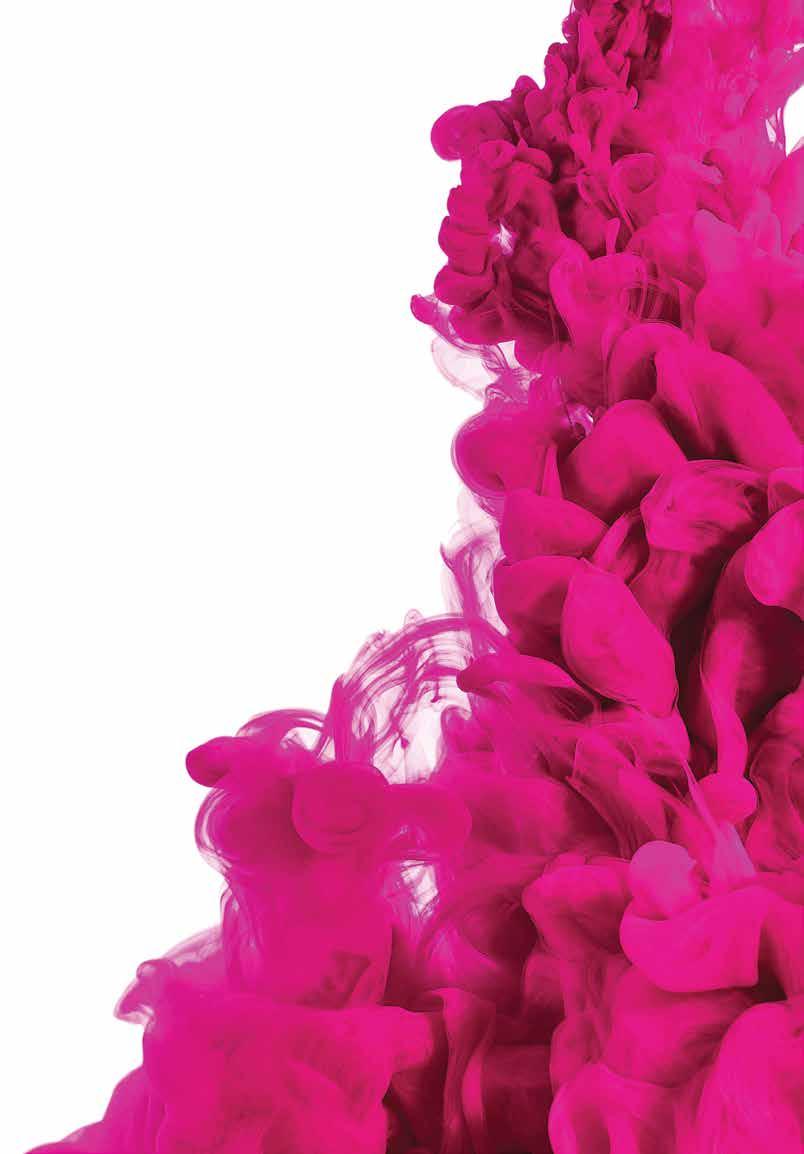

For more information, visit HiSymphony.org/DateNight. We invite you to experience the rich tapestry of our new season, brimming with sonic delights that will color your world with music. Choose from any Saturday Masterworks and receive the following for $150: 2 Concert tickets 2 Pre-Concert Reception Tickets SATURDAY AT THE SYMPHONY AT THE HONOLULU CLUB includes 2 cocktails each, upscale pupus and entertainment A Small Box of Chocolates Saturday at the Symphony
CUL
RE
C PALM 文化
TU
of place that A sense
PALM C
61
fosters the human spirit
Guardians of the Wai
Legendary stories of mo‘o, or lizards, have passed down through generations and persist at water sources around communities across the Hawaiian Islands.
何世代にもわたってハワイの島々で語り継がれてきた、巨大なトカゲの物語。
Text by Christine Hitt Images by Dino Morrow
文 = クリスティン・ヒット
写真 = ディノ・モロー
水の守護者
Mo‘o 또는 도마뱀에 대한 전설적인 이
야기는 여러 세대를 거쳐 하와이 제도
의 수원에서 지속됩니다. 무서울지라도
무어는 자연 자원에 대한 치열한 수호
자이며, 이는 삶의 주요 필요성입니다.
이런 식으로 mo'o의 이야기는 환경 수
업으로 사용될 수 있습니다.

The dreaded mo‘o, or gigantic lizards, are the shapeshifters of Hawaiian legend. They are described as lizards, or a reptile of any kind and size that could be a dragon, a serpent, or a water spirit. Guardians of streams, waterfalls or lakes, they were most times female, and in some instances, take the form of a beautiful woman. An exception being Pana‘ewa, a reptile-man, who ruled the tropical forests of Hilo.
ハワイの伝説に登場する「モオ」は、ミステリアスで恐ろしい、変幻自在のト カゲだ。伝説では、龍、蛇、または水に棲む妖怪など、さまざまな大きさや種 類の爬虫類として描写されてきた。モオは河川や滝、湖の守護者であり、た いていは女性で、時には美女の姿で現れることもある。
62 C CULTURE Mo‘o
PALM


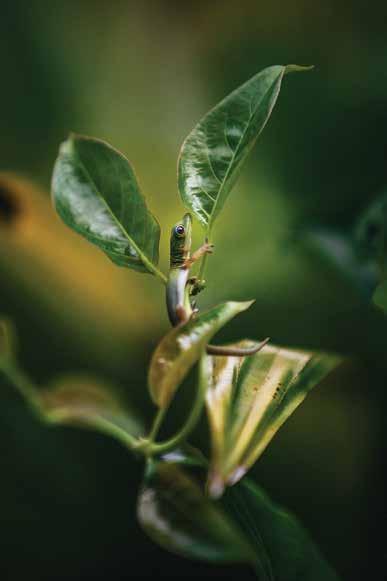


Hawai‘i’s geckos today are non-native and not the ones referred to in Hawaiian lore.
Nonetheless, legendary stories of mo‘o have passed down through generations and persist at water sources, and in Hawaiian, mo‘o translates to “lizard, reptile of any kind.”
In one of the most famous legends of Hawai‘i, Hi‘iaka, the youngest sister of Pele, goddess of volcanoes, battled Pana‘ewa on her journey to Kaua‘i to fetch Lohi‘au, the man of Pele’s dreams. Hi‘iaka wanted to defeat mo‘o along the way as a way to help the maka‘āinana who feared them. When she arrived to the Hilo forest, Pana‘ewa blinded Hi‘iaka with his fog-arms, wrapped her in heavy mists, and shrouded her in freezing rain, until lightning storms were brought down on him and defeated him. As the story continues, Hi‘iaka would go on to meet other legendary mo‘o on the island of Hawai‘i, including Maka‘ukiu, a ferocious monster with a great mouth and strong tail; Pili and Noho, two dragons that look like logs in the Wailuku River near Hilo; and Mo‘olau, a dragon in Kohala with powerful jaws.
The mystery of the mo‘o lies in the fact that there are no native reptiles to the Hawaiian Islands, nor any bones of an extinct species to prove that one existed. The numerous species of geckos seen in Hawai‘i’s houses and backyards today are non-native and not the ones referred to in Hawaiian mythology. Nevertheless, legendary stories of mo‘o have passed down through generations and persist at water sources around communities across the Islands. Sometimes, they’re visualized through natural land formations, such as at Mo‘oula Falls in Moloka‘i’s Hālawa Valley, where rocks at the top of the waterfall look like the head of a giant lizard. Mokoli‘i, also known as Chinaman’s Hat, is said to be the tail of a giant lizard slayed by Hi‘iaka. And Molokini off Maui—another lizard head, cut off by Pele—are other examples.
ただし例外もある。ヒロの熱帯雨林を支配し ていたと言い伝えられている「パナエヴァ」という名 のトカゲ男だ。ハワイで最も有名な伝説の一つに、 火山の女神ペレの末の妹、ヒイアカの物語がある。 この物語の中でヒイアカは、カウアイ島からペレの 夢の恋人ロヒアウを連れてくる旅の途中でパナエ ヴァに出くわし、マカアイナナ(村人たち)を助ける ために戦ってうち勝つ。ヒイアカは、旅の途中でハ ワイ島のそのほかの有名なモオにも出会った。巨 大な顎と力強い尾を持つマカウキウ。ヒロに近いワ イルク川で丸太のような姿を見せていた2匹の竜、 ピリとノホ。強大な顎を持ったコハラの竜、モオハ ウ。
不思議なことに、ハワイ島には原生の爬虫類 がまったくおらず、過去に絶滅した爬虫類の種がい たという痕跡も見つかっていないのだ。ハワイの家 や裏庭でよく見かける8種類のゲッコー(ヤモリ) はすべて外来種であり、ハワイの神話には出て来 ない。それなのに、モオの伝説は何世代にもわたっ て、特にハワイの島々の水源を取り巻くコミュニテ ィで語り継がれてきた。時には、モオの姿が自然の 地形の中になぞらえられることもある。モロカイ島 のハラワ渓谷にあるモオウラ滝は、滝の上にある岩 が巨大トカゲの頭に似ているといわれているし、オ アフ島の「チャイナマンズ・ハット」として知られてい るモコリイ島は、ヒイアカに倒された巨大トカゲの 尾だという伝説がある。マウイ島のモロキニ島も、 伝説によればペレに切り落とされた大トカゲの頭 だという。
PALM
66 C CULTURE Mo‘o
 In myth, Mokoli‘i Island, also known as Chinaman's Hat, is said to be the tail of a slain lizard.
Image by John Hook.
In myth, Mokoli‘i Island, also known as Chinaman's Hat, is said to be the tail of a slain lizard.
Image by John Hook.
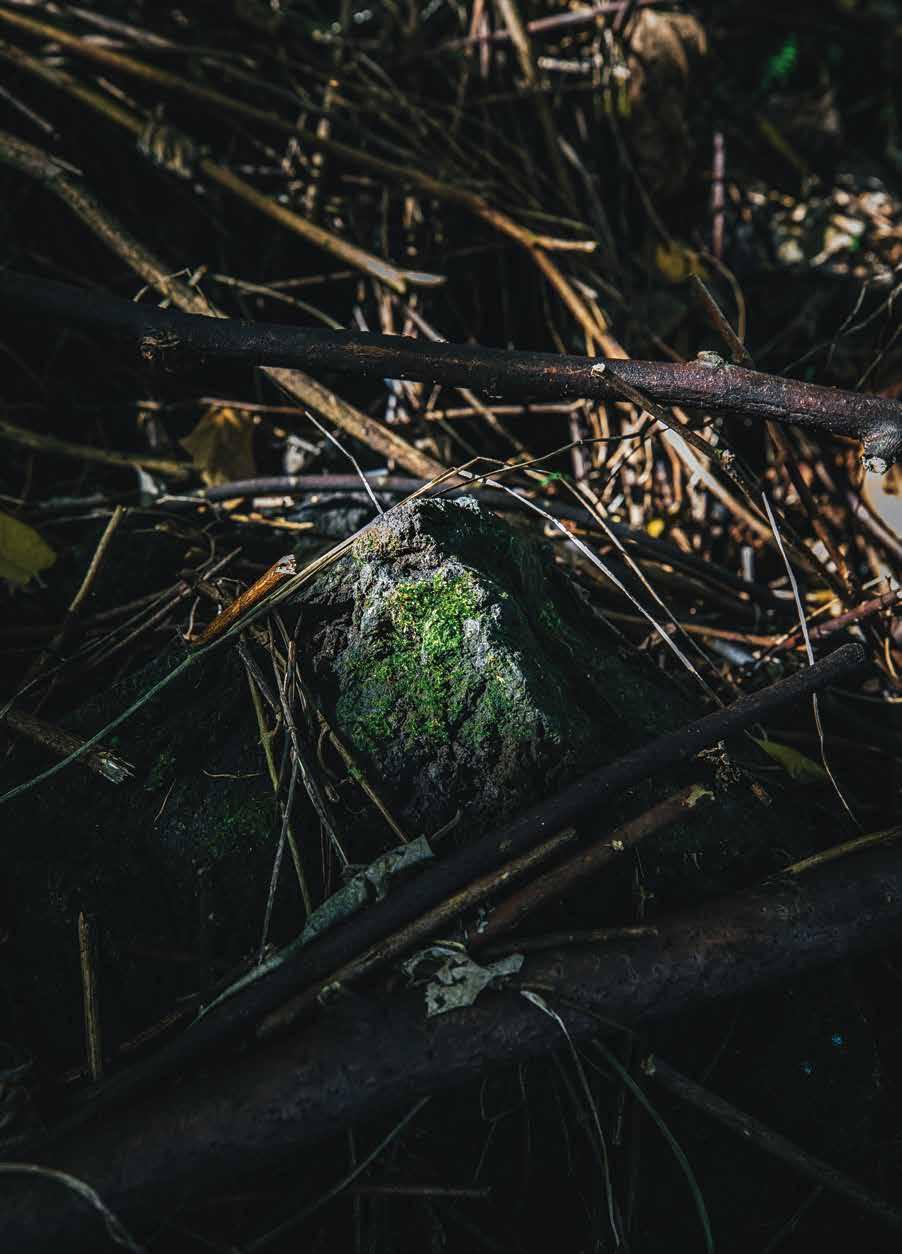

Mo‘o are so deeply embedded in the culture that they’re even mentioned in Hawai‘i’s Kumulipo, A Hawaiian Creation Chant : The night gives birth to sluggish-moving mo‘o; Slippery is the night with sleek-skinned mo‘o. This means they’re already in existence at the time of Papa, earth mother, and Wākea, sky father.
Marques Marzan, Bishop Museum’s cultural advisor, explains that the legend of mo‘o were created from ancestral memories from when the Pacific people left the coast of Asia. It’s perhaps a memory of crocodiles and snakes from those ancient homelands.
“The idea and the story of mo‘o being connected to water and having these kind of reptile, lizard-like qualities stems from that ancestral memory of those places,” he says. “Those stories were so strong that they were able to persist all the way into the middle of the Pacific across generations of time. I think it’s that mythological story that is perpetuated through chants and songs and genealogies, but also that actual memory [of reptiles] that was able to persist that gets attached to those stories as well.”
Though feared, mo‘o were fierce guardians of water, which is a primary necessity for life. They weren’t just bad spirts; they protected those places, until death if they had to. In this way, the stories of mo‘o can be used as an environmental lesson.
“When we hear about mo‘o, there’s always that perception of fear that’s involved just because of the intensity and strength that these figures have in memory and stories and in all those different forms,” says Marzan. “I think that’s one of the takeaways that, for me anyway, they’ve represented that strength in caring for and preserving place, especially water. So to be this protector of water in that way, the giver of life where everything comes from, I think that’s a beautiful story.”
モオはハワイ文化に深く浸透し、ハワイの創世神話を語るチャ ント(詠唱)、クムリポにも、「夜が、ぞろりぞろりと動くモオを生み出し た。つるりとした夜とともに、なめらかな皮膚のモオがいる」と歌われ ている。つまり、大地の母神「パパ」と空の父神「ワケア」が島々を創造 する以前に、すでにモオは存在していたことになる。
バーニス・パウアヒ・ビショップ博物館の文化アドバイザー、マ ルケス・マルザンさんは、モオの神話は祖先から受け継いだ記憶にも とづいて作られたのだろう、と説明する。祖先たちが海を越えて太平 洋の島々へと移住する前に住んでいたアジア沿岸地域にいた、おそ らくワニやヘビといった動物の記憶だ。そのような神話は、チャントや 歌、家系の物語などの形で伝えられた。恐ろしい爬虫類の記憶はあま りにも強烈だったので、「何十世代も後になって、太平洋の真ん中で までも記憶に刻まれ続けたのでしょう」とマルザンさんは語る。「モオ の話は、必ず恐ろしいものとして語られます。さまざまな形で記憶や 物語に刻まれた爬虫類の姿がそれだけ強烈だったからです」
恐れられる一方で、モオは、命をつなぐ上でなくてはならない 水を守護する者でもある。単なる悪霊ではなく、大切な水源を、とき には命をかけても守る存在なのだ。その意味でモオの物語は環境に ついて大切なことを教えてくれる。
マルザンさんはこう語る。「モオの物語に見られるのは、土地や 水を守る力をモオが代弁しているということです。少なくとも私はそ う思います。水の守護者であり、すべての源となる命を与える者。モオ の物語は、とても美しい話だと思うのです」
PALM
70 C CULTURE Mo‘o


He mo‘o, he pili pōhaku, he pili lā‘au a he pili lepo.
It is a lizard, for it clings to rocks, clings to trees, clings to the earth.
PALM 72 C CULTURE Mo‘o
‘Olelo No‘eau: Hawaiian Proverbs & Poetical Sayings by Mary Kawena Pukui


702 SOUTH BERETANIA STREET, HONOLULU, HI 808.543.5388 | CSWOANDSONS.COM
A Timeless Gown
時を超えるガウン
Text by Kylie Yamauchi
文 = カイリー・ヤマウチ
Images by John Hook and artwork courtesy of ‘Iolani Palace
写真 = ジョン・フック
74 B CULTURE Queen Kapi‘olani PALM

Native Hawaiian designer
Kini Zamora recreates the long lost coronation gown of Queen Kapi‘olani.
ネイティブハワイアンのデザイナー、キニ・ジモラさんは、カピオラニ 女王が戴冠式で着用した歴史的ガウンを再現しました。
하와이 원주민 디자이너 키니 자모라 (Kini Zamora)는 카피 올라 니 (Kapi'olani) 여왕의 가장 오래된 대관식 가운을 재 현합니다. 완성 된 대관식 가운은‘2019 년 9 월에 이올 라니 궁전 (Iolani Palace)``으로 이어졌으며, 이제 '이올 라니 궁전 (Iolani Palace)'의 왕좌에 전시됩니다.

On February 12, 1883, jubilant throngs of spectators flowed onto the grounds of ‘Iolani Palace for Hawai‘i’s first official coronation ceremony. It was anything but a usual Monday; people had taken off work for the public event and arrived in their best attire. In reserved areas, government dignitaries puffed out the royal insignia on their chests, as their wives sat with perfect composure in tightly laced gowns. Kingdom subjects filled the seats of the temporary amphitheater, the wāhine gliding in their best mu‘umu‘u and the kāne striding tall in their suits. As the procession began, journalists readied their pens, eyes straining to catch every detail. From the sea of craning necks, King David Kalākaua and Queen Kapi‘olani emerged, both dressed in royal attire able to match that of England’s monarchs. But it was the original Euro-Hawaiian gown
1883年2月12日、ハワイ初の公式な戴冠式を見ようと、歓喜に顔を輝かせた 群衆がイオラニ宮殿の敷地に続々と流れ込んだ。それはいつもの月曜日とはま ったく違う一日だった。人々はこの公式行事のために仕事を休み、精いっぱい に着飾って宮殿に詰めかけた。貴賓席には王家の紋章を着けて胸を張った政 府のお歴々が並び、そのかたわらにはぴったりと身体にそったレースのガウン をまとって取り澄ました夫人たちの姿があった。王国の臣民たちもこの日のた めに設けられた観覧席を埋めた。手持ちの中で一番上等のムウムウを着たワヒ ネ(女性)たちは地面を滑るように進み、スーツ姿のカネ(男性)たちは背筋をぴ んと伸ばして堂々と歩く。行進が始まると、記者たちは手に手にペンを構えてど んなディテールも見逃すまいと目をみはる。やがて、いっせいに首を伸ばして見 守る群衆の前に、英国君主にもひけを取らない正装に身を包んだデヴィッド・ カラカウア王とカピオラニ女王が姿をあらわした。このとき、記者や着飾った人
PALM
76 C CULTURE Queen
Kapi‘olani
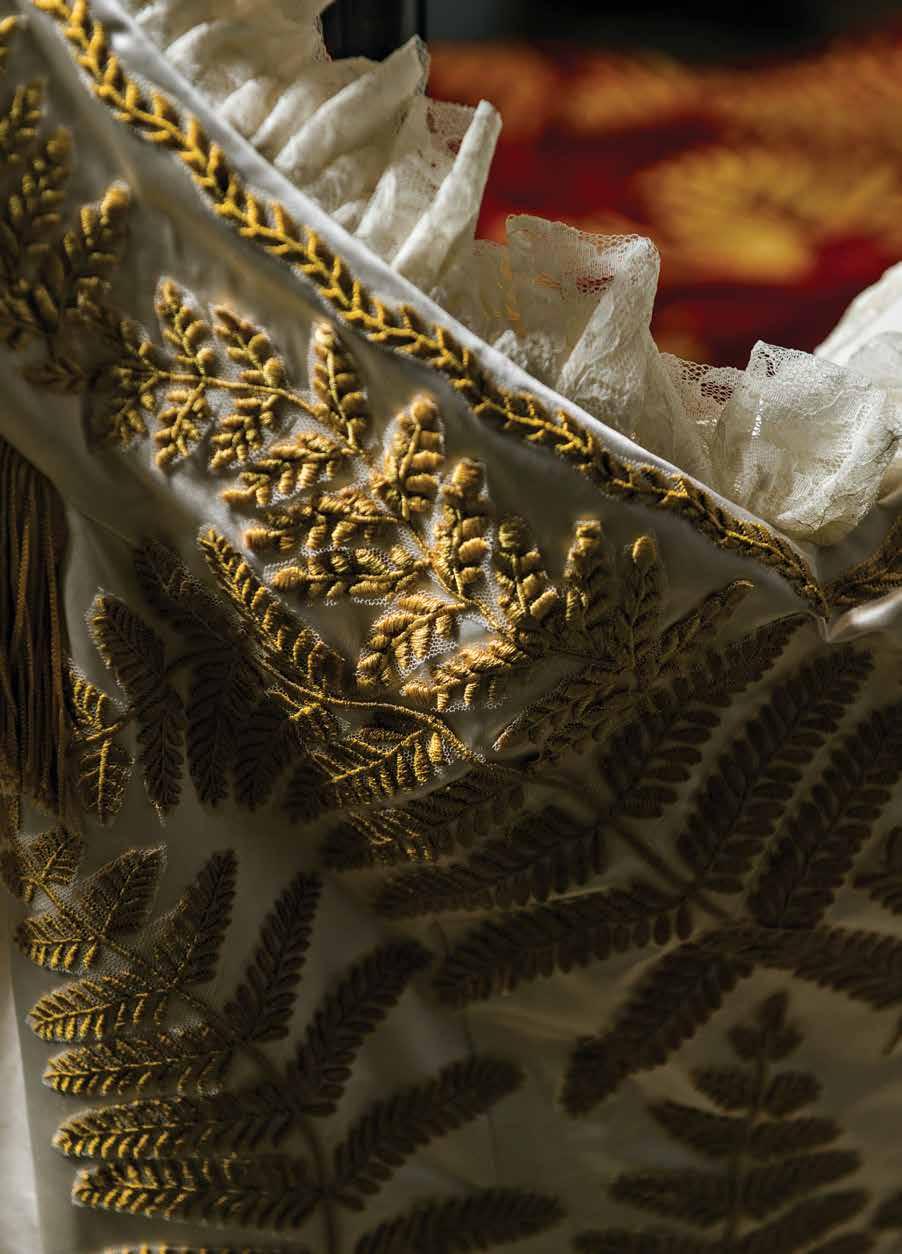
that Kapi‘olani wore that captivated journalists and the couture crowd, as well as historians today.
The Victorian gown was made of white satin and embroidered with golden palapalai fern leaves from her chest to her ankles. A deep turquoise sash draped across her right shoulder down to her left hip. In true English royal fashion, a heavy crimson red robe with erminefur trim rested on the queen’s shoulders, where the ferns continued to fall down her back. A delicate fringe danced on the sleeves and hem of the gown with each step she took toward the pavilion.
The queen reappeared in the coronation gown in 1887 at a different sort of palace: the White House. President Grover Cleveland threw a ceremonial dinner for Queen Kapi‘olani and Princess Liliu‘okalani, who had stopped in the United States on their way to attend Queen Victoria’s Golden Jubilee in England. Kapi‘olani was honored and received much attention for being the first queen to visit the young country. In a story published the following day, The New York Times called the gown “a Court dress of Hawai‘i,” rather than attributing it to English fashion.
After 1887, there was no mention of the gown again. Today its whereabouts are unknown. According to ‘Iolani Palace historian Zita Cup Choy, the ali‘i were just like regular people; they gave away unused clothes to relatives and sometimes auctioned them off when they were in need of money. The only remaining evidence of it are a handful of newspaper clippings, a few blackand-white photos, and a detailed painting of the queen sitting in her gown. These sources were all that Native Hawaiian fashion designer Kiniokahokuloa Zamora had to work with in recreating the queen’s gown for ‘Iolani Palace.
Fortunately, Zamora was no stranger to design challenges. In 2014, he starred in season 13 of the hit TV show Project Runway, competing against 17 designers from across the United States. In each episode, the contestants competed to create outfits based off quirky themes ranging from futuristic societies to American Girl dolls. The Kalihi local finished third, and in 2016, he returned for the show’s spinoff, in which he was runner-up.
When ‘Iolani Palace announced in January 2019 that it would commission Zamora and his small team to expand its ali‘i garment reproduction project, he was prepared to work under pressure and with limited resources. For the project, designer Iris Viacrusis had already recreated two gowns of Kapi‘olani and two gowns of Lili‘uokalani, which are on display at the palace. Like Viacrusis, Zamora entered the project with knowledge of Victorian fashion, having created the costumes for Ballet Hawaii’s production of The Nutcracker
々の目をもっとも惹きつけ、のちに現代の歴史学者たちも注目させることにな るのは、カピオラニ女王がまとっていた、ヨーロッパとハワイの要素を両方とも 取り入れたオリジナルデザインのガウンだった。
それは白のサテンで作られた正統派ヴィクトリア朝様式のガウンで、胸から足 首の位置にかけて金色のパラパライシダの葉の模様が刺繍されていた。右肩 から腰の左側には深いトルコブルーのサッシュ。女王の肩からかけられた重 厚な真紅のローブは英国王室の伝統にのっとってアーミンの毛皮でふち取ら れており、背面には腰から裾までシダの刺繍が施されていた。女王がパビリオ ンに向かって一歩ずつ踏み出すたびに、ガウンの袖とすそで繊細な房飾りが 揺れた。
1887年、女王は再びこの戴冠式ガウンをまとってもうひとつの宮殿に登 場した。ホワイトハウスである。英国でのヴィクトリア女王の在位50周年記念 式典に出席する旅の途上、米国本土に寄港したカピオラニ女王とリリウオカラ ニ王女のために、グローバー・クリーブランド大統領が公式晩餐会を主催した のだ。カピオラニ女王はこの若い国を訪問した最初の女王として丁重にもてな され、大いに注目された。ニューヨーク・タイムズ紙は晩餐会の翌日の記事の中 で、女王のガウンを英国ファッションではなく「ハワイの宮廷服」と呼んだ。 しかし1887年以降そのガウンに関する記述はぷつりと途絶え、現在もその行 方は不明だ。イオラニ宮殿の歴史学者であるジータ・カップ・チョイさんによれ ば、ハワイの王族は平民と同じように、不要になった服を親戚にあげたり、資 金が必要なときには競売にかけたりしていたそうだ。ガウンについての残され た資料は、いくつかの新聞記事の切り抜きと数枚の白黒写真、ガウンを着て座 っている女王を仔細に描いた一葉の肖像画だけである。ネイティブハワイアン のファッションデザイナーであるキニオカホクロア・ザモラさんがイオラニ宮 殿の依頼を受けて女王のガウンを再現した際に参考にできたのもこれらの資 料だけだった。
幸い、ザモラさんはデザイン上の困難な課題に挑戦することには慣れてい た。オアフ島カリヒ出身のザモラさんは、2014年にテレビ番組『プロジェクト・ ランウェイ』のシーズン13に登場し、アメリカ各地から集まった17人のデザイ ナーと腕を競った実績の持ち主である。番組では出場者たちは毎回、未来社 会や「アメリカン・ガール」シリーズの人形といった、奇妙なテーマにもとづいて 服を競作した。ザモラさんの最終成績は3位で、2016年にはこの番組のスピ ンオフ番組に再び出場して2位を獲得した。
2019年1月、イオラニ宮殿がアリイ(王族)の衣服再現プロジェクト拡大 のため、ザモラさんと彼が率いる少数精鋭のチームに制作を委託すると発表し た時、ザモラさんは重圧のもとで限られたリソースだけを頼りに作業を進める 覚悟をかためた。このプロジェクトでは、すでにデザイナーのアイリス・ヴィアク ルシスさんの手でカピオラニ女王とリリウオカラニ女王のガウンが2着ずつ再 現されており、宮殿に展示されている。ヴィアクルシスさん同様、ザモラさんもバ レエ・ハワイの『くるみ割り人形』の衣装制作で培ったヴィクトリア朝ファッショ ンの知識を携えてプロジェクトに着手した。
PALM 78 C CULTURE Queen Kapi‘olani

“We wanted to create reproductions of the historic dresses to bring the ali‘i’s lives to the palace in a different matter,” said director of curation and education Teresa Valenica. While much can be said about the ali‘i through the furnishings displayed in ‘Iolani Palace, garments show their personal tastes and the ways they acknowledged certain trends. The ali‘i aimed to be fashion-forward like other global leaders, and the dresses they wore typically came from New York, London, and Paris.
The commission required Zamora to create an exact representation of Kapi‘olani’s gown. Through six months of research with the help of the palace and Bernice Pauahi Bishop Museum, the designer reimagined the lost creation. “If I wasn’t on a deadline, I’d want to take a whole year or more to keep researching,” Zamora said. “I still have to pinch myself some days that I’m doing this project.”
In the process, he learned that the designer of the gown, Charles Furneaux, was also the artist who painted Kapi‘olani wearing it. The painting became a main reference in the design process, particularly when determining the color of the fabrics; according to Zamora, the fabric for the deep turquoise grosgrain moir sash was incredibly hard to find. For the utmost accuracy, Zamora’s graphic artist, Alexander Propios, digitized the palapalai in the painting to reproduce the palapalai embroidery.
Wanting to share this project with his lāhui, Zamora invited community members to come to his studio and sew the embroidery onto the robe by hand. But this was no easy task. The palace insisted that the leaves fall in exactly the same pattern as seen in a blackand-white photo. Considering the photo only shows half of the robe, the team had to scrutinize the photo and guess the rest of the placement as best they could.
Designing a Victorian-era gown in modern times came with unavoidable accommodations. Midway through the project, I‘olani Palace found a piece of ermine fur in its archives that it believed to be from the coronation gown, confirming the trim’s material, but Zamora chose faux fur to stay within budget and be animal-conscious. He purchased materials from New York, as would have been done in the queen’s day, but the white satin he chose had more of a modern-day, Vera Wang feel, Zamora said with a laugh.
The completed coronation gown made its way to Iolani Palace in September 2019, where it is now displayed in the throne room beside Furneaux’s painting. “These gowns used to be made in London and New York,” Zamora said, beaming. “Now Hawai‘i can say, we can make them too.”
宮殿でキュレーションと教育担当のディレクターを務めるテレサ・バレンシ アさんは、「私たちは、宮殿の中で今までとは違う角度からアリイたちの生活を 紹介するために、歴史的ドレスの複製を作りたかったのです」と語る。往時のア リイの生活のようすはイオラニ宮殿に展示されている家具調度からもうかがえ るが、衣服は個人的な好みや、彼らがどのように当時の流行を捉えていたかを 表す。アリイたちは他国のリーダーたちのように流行に敏感になろうと目指し ていて、ドレスをニューヨークやロンドン、パリで作らせることが多かった。 宮殿からの委託でカピオラニ女王のガウンを正確に再現することを要求され たザモラさんは、宮殿とバーニス・パウアヒ・ビショップ博物館の協力を得て、6 か月間をかけたリサーチの結果、失われたガウンを再構成した。「期限が定め られていなかったら、リサーチに丸1年かそれ以上かけたかったですね」とザモ ラさんは言う。「いまだに自分をつねって、自分が現実にこのプロジェクトに関 わったんだと確かめなくちゃならないことがあるんですよ」
リサーチの過程でザモラさんは、ガウンをデザインしたチャールズ・フルノ ーがそのガウンを着たカピオラニ女王の肖像画を描いた人物でもあることを 知った。その肖像画はデザインプロセスでのメイン資料となり、布地の色を決 める際に特に参考になった。ザモラさんによると、深いトルコブルーのグログラ ンモアレで作られたサッシュを再現するための生地を見つけるのは信じられな いほど大変だったそうだ。できる限り正確に再現するため、ザモラさんが雇っ たグラフィック・アーティストのアレグザンダー・プロピオスさんは、女王の肖像 画に描かれていたガウンのパラパライの模様をデジタル化した。 ザモラさんはこのプロジェクトを自分のラフイ(コミュニティ)と共有したいと考 えていたので、地元の人たちを自分のスタジオに招き、シダの刺繍をローブに 手で縫いつけてもらった。しかし、それは簡単な作業ではなかった。宮殿は、あ くまでも写真に記録されているのと完全に同じパターンにシダの葉を配置する よう要求した。写真ではローブが半分しか見えないため、チームは写真を綿密 に調べて残りの刺繍がどのように配置されていたかを推測するしかなかった。 ヴィクトリア朝時代のガウンを今の時代にデザインするときには、多少の間に 合わせは避けられない。プロジェクトもなかばに達した頃、イオラニ宮殿の資 料保管庫の中で戴冠式のガウンに使われていたと思われるアーミンの毛皮が 見つかり、ふち取りの素材が裏づけられたのだが、ザモラさんは費用を予算内 におさめるためと動物愛護の見地からフェイクファーを使用することを選ん だ。素材は女王の時代と同じくニューヨークから調達したが、自分が選んだ白 のサテンはどちらかといえば現代的で、ヴェラ・ウォンのウエディングドレスのよ うな雰囲気なんですよ、とザモラさんは笑いながら語る。
完成した戴冠式ガウンは2019年9月にイオラニ宮殿に届けられ、現在は 玉座の間のフルノーが描いた女王の肖像画の隣に展示されている。ザモラさん は、「こういったガウンはかつてロンドンやニューヨークで作られていましたが、 今ではハワイも『私たちだって作れる』と言えるようになりました」と満面の笑 みを浮かべて語った。
PALM
80 C CULTURE Queen Kapi‘olani
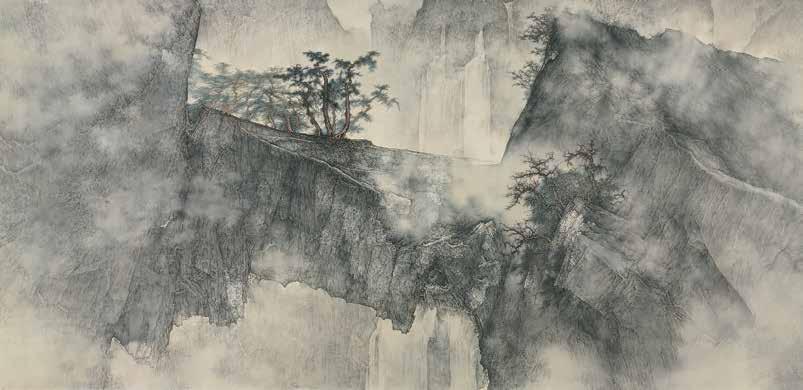
MUSEUMS • CAFÉS • THEATER • SHOPS
900 S Beretania St • 808.532.8700 honolulumuseum.org
Li Huayi, Autumn Mountain /At the Edge of the Sky, 2007 Ink and color on paper. Yiqingzhai Collection (L2016-67.01)
ON VIEW THROUGH JAN 5, 2020
THIS EXHIBITION IS MADE POSSIBLE WITH GENEROUS SUPPORT BY the E. Rhodes and Leona B. Carpenter Foundation, Maurice and Joanna Sullivan Family Foundation, Dr. Diane Chen Koch-Weser, Dr. Gene and Cecilia Doo, Donald and Laura Goo, Drs. Ernest and Letah
Lee, Fred Sheng and Robert Oaks, Drs. William and Margaret Won and two anonymous donors.
MEDIA SPONSOR
HOTEL SPONSOR
Classical. Contemporary. Cool.
SI GN
D デザイン flourishing The of
DE
PALM D PALM
83
creative facilities
Designing Women
デザインの女性旗手たち
Text by Natalie Schack and Rae Sojot
文 = ナタリー・シャック&レイ・ソジョット
Images by Chris Rohrer and courtesy of the designers
文 = ナタリー・シャック&レイ・ソジョット
84 D DESIGN Interiors PALM

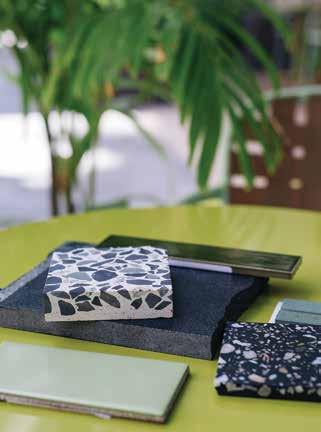
새로운 세대의 하와이 인테리어 디자인을위한 토대를 마련하는 3 가지 광고 소재 (Michelle Jaime, Nalani Sato 및 Amy Rivo)의 공간과 감성을 느껴보십시오.
MICHELLE JAIME
Michelle Jaime gets by with a little help from her friends. Luckily, she has some creative friends. As president and co-founder of The Vanguard Theory, a Honolulu-based interior design firm, Jaime’s got her fair share of the creative gift. Her firm’s high-profile design projects, like crafting the interior aesthetic and vibe of Surfjack Hotel and Swim Club and Hotel Renew have set a hip new tone for the next generation of Waikīkī hotels.
Yet for Jaime, what really makes the firm’s work sing is being part of a collective story, when she enlists a crew of creatives who come together to make something meaningful. “I think as a creative person, you’re always wanting to learn new things and experiment with new things. Collaborating with artists, that’s the best way,” she says, pointing to the Surfjack project, in which they invited more than a dozen artists to participate.
As a designer, she tends to be more calculated, needing to anticipate elements like budgets, timelines, and clients. Artists, however, “have this passion and this way they can express themselves that I find myself gravitating towards,” she says. If not artists, Jaime taps other creatives in local food, crafts, or artisan goods. At Hotel Renew, which was designed around a wellness theme, she recruited Blue Tree Cafe, known for its healthy foods and juice cleanses, to run the bar. “It couldn’t be artists, because we didn’t have the landscape for it,” she says. “But we took that idea of looking local first.”
文 = ナタリー・シャック&レイ・ソジョット ミシェル・ハイメさんは、自分の事業は友人たちに助け られて回っている、と語る。幸運にもクリエイティブな 友人たちに恵まれているというが、もちろん、ホノルル のインテリアデザイン会社「ザ・ヴァンガード・セオリ ー」の社長であり共同設立者でもあるハイメさん自身も 創造的才能の持ち主だ。サーフジャック・ホテル&スイ ム・クラブ、そして最近ではホテル・リニューなど、彼女 の会社がインテリアを担当し、空間の美的方向性を決 めて雰囲気づくりを手がけた注目のプロジェクトは、ワ イキキの新世代ホテルにおけるヒップな新しいデザイ ンの潮流を創り出してきた。
しかし、ハイメさんにとって仕事を真に輝かせるの は、意味ある何かを協力して作り出すためにクリエイテ ィブな人材を集め、自分もその共同体が紡ぎだす物語 の一部となるときだそうだ。10数人のアーティストが 参加したサーフジャックでのプロジェクトを例に挙げ、 ハイメさんはこう語る。「クリエイティブな人なら、常に 新しいことを学び、新しいものを使って実験してみたい と思っているはずです。アーティストたちとコラボレー ションすること、それが最善の方法です」
デザイナーとしての彼女自身は、予算、タイムライ ン、クライアントといった要素を前もって考える必要が あるため、どちらかといえば計算に重きをおく傾向があ る。一方でアーティストたちは「情熱を原動力に、それ ぞれが描く構想を表現することができる。私はその力 に惹かれます」とハイメさん。アーティストだけでなく、 地元の食品や工芸などの分野で活躍する人たちに協 力を求めることもある。ウェルネスをテーマにデザイン されたホテル・リニューでは、ヘルシーな料理やジュー スクレンズで知られるブルー・ツリー・カフェにバーを 運営してもらうことにした。「アーティストにバーの運営 は頼めませんからね。そういう体制がありませんから。 でも、まず地元で人材を探す方針は同じです」とハイメ さんは言う。
PALM
86 D DESIGN Interiors
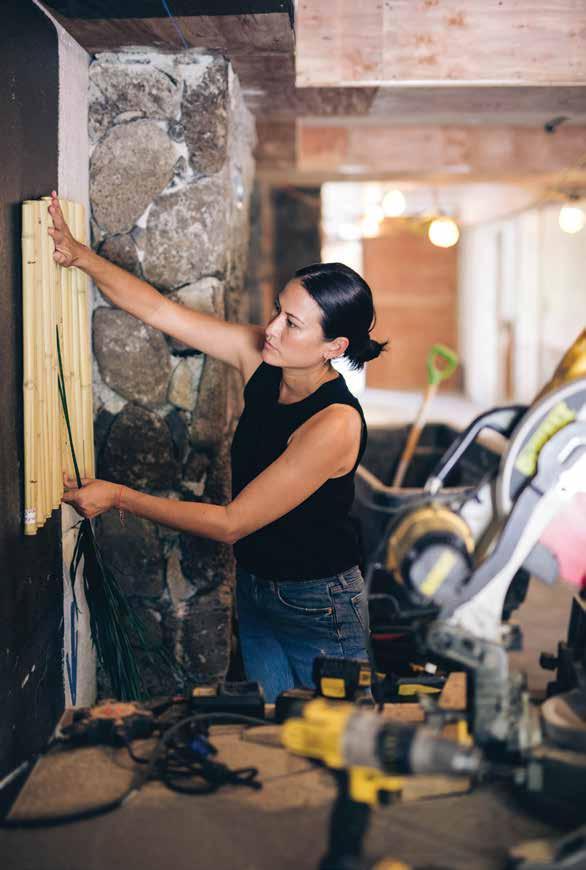
Jamie co-founded The Vanguard Theory with former partner Judy Andrade a decade ago, right in the middle of the recession. The two had been laid off, so they seized the chance to be their own bosses. The challenge? In that economic climate, opportunities were drying up, so “we had to create our own,” Jamie says.
The recession ended up working to their advantage. Through contacts they had fostered in the industry, they hopped on as contractors for projects helmed by larger, more established companies that were understaffed as a result of recession layoffs. Right out of the gate, the pair was able to work on significant projects that fledgling firms would not normally have the opportunity to do. By the time the economy had recovered, The Vanguard Theory had come into its own.
Despite being a small studio, The Vanguard Theory is making big waves in the narrative of Hawai‘i design, combining fresh, outside-the-box thinking with hip, outside-the-studio input. When they designed the pool at Surfjack, for example, they envisioned an eye-catching, stand-out mural at the bottom of it. By collaborating with branding agency Wall-to-Wall Studios and Matthew Tapia, the artist behind the hotel’s now-iconic “Wish You Were Here” pool lettering, the firm made this vision a reality.
From prints on guest room walls to products in hotel shops, Jaime and her team get down to the minutiae, gathering the goods, materials, and products that will create just the right experience.
One of their latest projects was a Hawai‘i-themed bar—in Nashville, Tennessee. “We did a bar which the client really liked at the Surfjack, and they really wanted to make a Hawai‘i-themed bar. They called it B1281 Surf Club, which is funny in Nashville,” she laughs. Again, they tapped their network of creatives, bringing in letterer Jeff Gress and Wooden Wave artists Matthew and Roxanne Ortiz to contribute.
“If we did the same thing by ourselves, working in a silo every single day, we would be off point,” she says. “When we collaborate with other people, it always keeps it fresh.” — N.S.
ハイメさんは10年前、ちょうど不況の最中に、当時パートナーだったジュデ ィ・アンドレードさんと共同でザ・ヴァンガード・セオリーを設立した。2人とも 勤務先から解雇され、それをきっかけに起業のチャンスをつかむことにしたの だ。当時は不景気で仕事の機会がますます減っていた。「自分たちで機会を創 出しなければなりませんでした」とハイメさんは語る。
不況は結果的に2人にとって有利に働いた。大規模で実績のある会社は不 況によるレイオフで人手が足りなくなっていたので、そういった会社が率いる プロジェクトに、業界で築いたつながりを通して下請け業者として参加するこ とができた。設立当初から、普通なら開業したての会社にはとてもかかわるチ ャンスがないような大規模プロジェクトで働くことができたのだ。景気が回復 した頃にはザ・ヴァンバード・セオリーは一本立ちできるようになっていた。
小規模なスタジオながら、ザ・ヴァンガード・セオリーはハワイにおけるデザ イン界の潮流に大きな変化を起こしている。新鮮で型にはまらない考え方と、 スタジオ外アーティストによるヒップなインプットとの組み合わせが功を奏し た。たとえば、サーフジャックのプールをデザインした時には、プールの底に目 立つ絵を配置しようと構想し、ブランディング会社「ウォール・トゥ・ウォール」 とマシュー・タピアさんとのコラボレーションでそれを実現させた。タピアさん は、プールの底に描かれて今や有名になった「Wish You Were Here」(あな たもここにいたらいいのに)というレタリングを制作したアーティストだ。
ハイメさんと彼女のチームはごく細かな点にまで気を配り、客室の壁にか ける版画からホテルのショップに置く商品にいたるまで、構想どおりのエクスペ リエンスを作り出すための素材やグッズを集めた。
最近手がけたプロジェクトのひとつに、ハワイをテーマにしたバーがある。 場所はテネシー州ナッシュビル。「サーフジャックで私たちがデザインしたバー を気に入ってくださったクライアントが、どうしてもハワイをテーマにしたバー を作りたいと希望したんです。バーの名前は『B1281サーフクラブ』でした。ナ ッシュビルという土地柄には奇妙ですよね」とハイメさんは笑う。このプロジェ クトでもクリエイティブなネットワークの力を借り、レタラーのジェフ・グレスさ んと「ウッドゥン・ウェイブ」のアーティスト、マシュー&ロクサンヌ・オルティス 夫妻に作品を制作してもらった。
ひと目でハワイがテーマとわかるプロジェクトである場合もそうでない場 合も、場所がハワイの中でも外でも、ハイメさんのプロセスには常に変わらない 要素がひとつある。「自分たちだけで毎日同じことを続け、外からの刺激が入ら ない環境で働いていたら、世の人たちが良いと思うものとはズレてしまいます。 他の人たちと協力することによって常に新鮮な仕事ができるのですよ」とハイメ さんは語る。– N.S.
PALM
88 D DESIGN Interiors

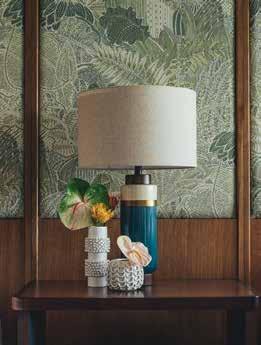
 Designs by Vanguard Theory.
NALANI SATO
Designs by Vanguard Theory.
NALANI SATO
Nalani Sato’s home contains a smorgasbord of patterns and textures. Stacked in corners and on tables, rolled up and piled on shelves and above cupboards, there are swatches of geometric fabric in everything from handsome burgundy to mid-century periwinkle; chunks of wood in walnut or ash; cork accented with dramatic swaths of gold.
Sato drifts gracefully through the halls and muses over rolls and rolls of fabric that are heaped to the rafters in every room of the house. She is like a librarian of tactile tomes, drinking in the collection’s elements with her eager eyes and hands.
“Isn’t this gorgeous?” she asks, pulling down a roll of woven fiber from Japan. It’s a subdued selection: clean, organic, natural. It’s redolent with a scent like fresh grass, outdoor breezes, and bamboo. It feels like stillness in a garden. Simplicity. Peace. She sweeps her fingers over it admiringly.
Within this house of innumerable materials are innumerable possibilities. Sato is a dealer in the oftoverlooked arena of wallcoverings, from wood to tile to vinyl to linen. The potential impacts that such decor can have on a room—whether it be a luxurious suite at Halekulani or the festive shave ice stand of Uncle Clay’s House of Pure Aloha—are subtle yet myriad and powerful. “It’s a way for a designer to tap in subliminally to the guest or the customer,” she says. “To almost manipulate them into thinking that they are in a safe, natural space.” Products from her work life have poured into her home as she transitions from Waihona Surfaces, which she cofounded, to starting her own business, SUMO, an acronym for Surface Mode of Operation.
Sato’s history with the world of surface textiles and wallcoverings is a long one. Her foray into it began with the family business, Architectural Services, which was founded by her father and served as a purveyor of highquality wallcoverings for designers and architects. After working luxury events in New York City and going to school for fine arts, Sato came back to the islands in 2001, joining her father’s team a few years later as a sample coordinator, which meant managing the catalog of product samples. In this role, she discovered her unexpected knack and love for
ナラニ・サトー
ナラニ・サトーさんの自宅は、種々雑多なパターンやテクスチャーであふれてい る。端麗な赤ワイン色からミッドセンチュリー風の明るい青紫色までさまざま な色をした幾何学模様の布地見本、クルミ材やトネリコ材、ドラマチックな金 色のアクセントが塗られたコルクなどが、部屋の隅やテーブルの上、棚の中、食 器棚の上にもうず高く積み重ねられている。
廊下を優雅な足どりで歩きながら、サトーさんはどの部屋にも山と積まれ ている布地を前に思案する。集めた素材のさまざまな要素をひたむきな目と手 で読み取る彼女は、まるで、触覚で読む長大な書物をおさめた図書館の司書の ようだ。
日本から取り寄せたという布のひと巻きを引き出して「これ、素敵でしょ う?」と言う。クリーンで有機的でナチュラルな、落ち着いた色の織物だ。新鮮 な草、戸外のそよ風、そして竹を思わせる芳しい香りがする。連想するのは、静 かな庭、シンプリシティ、平安。サトーさんはうっとりと織物に指をすべらせた。
家の中に集められた数えきれないほどの素材には、無数の可能性が眠って いる。サトーさんは木材からタイル、ビニール、リネンまで扱う装飾壁材のディ ーラーだ。ともすると見過ごされがちな分野だが、ハレクラニの豪華なスイート から活気あるシェイブアイスの店、アンクル・クレイズ・ハウス・オブ・ピュア・ア ロハまで、壁材が空間に与える効果は捉えがたいほどかすかながら実に多様 でパワフルだ。「デザイナーにとって壁材は、宿泊客や利用客の潜在意識に働 きかける手段なのです。ある意味、安全で自然な空間にいると感じてもらうよう に、お客さんの心を操るのに近いかもしれません」とサトーさんは説明する。家 が商品見本でいっぱいなのは、共同で設立した会社「ワイホナ・サーフェセズ」 から自分の会社である「SUMO(サーフェス・モード・オブ・オペレーション)」に 事業を移行中で、仕事で扱う素材が自宅に流れ込んできているからだそうだ。 サーフェス・テキスタイルと装飾壁材の業界でのサトーさんの職歴は長い。 業界への第一歩は、実家が経営していた会社「アーキテクチュラル・サービシ ズ」からだった。サトーさんの父が設立したこの会社は、デザイナーや建築家向 けに高品質の内装用装飾壁材を供給していた。ニューヨークシティでラグジュ アリーイベントの仕事をし、学校で美術を学んだ後、サトーさんは2001年に ハワイに戻り、その数年後、父の会社にサンプル・コーディネーターとして入社 し、商品見本のカタログ管理を担当した。この仕事をするうちに、自分が意外 にもショールームの整理や帳簿の扱いといった日常的なタスクをこなすのが 上手く、好きでもあることに気づいたという。2017年に退職してワイホナ・サー フェセズを共同設立、2019年にはSUMOを開業した。会社名は好きな相撲 にちなんで名づけたそうだ。
PALM
90 D DESIGN Interiors


Nalani Sato’s latest business venture is SUMO, an acronym for Surface Mode of Operation.
day-to-day tasks like organizing the showroom and handling the books. In 2017, she left to co-found Waihona Surfaces, and in 2019 she debuted SUMO, as she likes to call it, a name inspired by her love of sumo wrestling.
It’s a dream job for a creative like her. “I love to paint. I appreciate many different styles of everything,” she says. “I think with all artists, when one is strictly in the creative sense, one can lose their mind quite easily. I’ve been there. Getting into the business side of things just really sparked something within me where I felt a balance within myself for the first time in years.”
One of Sato’s favorite aspects of being a small-business leader curating quality materials for designers is supporting local visionaries, catering to their artistic needs, and empowering them to create without limits. That means sourcing a wide selection of high-quality options to fit any of the spaces they could dream up, providing access to far-reaching materials and brands, and keeping a robust supply of samples on hand to cut down on arduous shipping times.
It’s all a part of Sato’s passion for the local design scene and her staunch belief in the unique creativity and singular style that characterizes it. “I just want to see these creatives here treated fairly. I want to see them treated the same way they would be treated in New York City or Los Angeles or Chicago or Houston,” she says. “The design style here is so poetic, just like the language.” — N.S.
今の仕事は、クリエイティブな彼女にとっては 夢のような職業。「絵を描くことが大好きで、いろい ろなスタイルにそれぞれの良さがあると思っていま す。どんなアーティストであっても、クリエイティブ な面だけを追求していると心のバランスを失いや すくなります。私もそうなったことがありました。ビ ジネス面に取り組んだことで私の中にあった何か が目覚め、本当に何年ぶりかで、自分の中のバラン スがとれたと感じられるようになったのです」とサ トーさんは語る。
デザイナーのために上質な素材を厳選して集 める小規模企業の経営者として、自分の仕事で一 番気に入っているのは、地元のビジョナリーたちの アーティスティックなニーズに応え、彼らが制約な しに創作に打ち込めるよう応援できることだとい う。そのためにはデザイナーたちが思い描くどんな 空間にも合うよう、幅広く質の高いセレクションを 調達し、遠く離れた国や地域の素材やブランドへ のアクセスを提供せねばならない。ハワイに見本を 送ってもらうには長い日数がかかるので、すぐに手 に取って見られるよう、見本の数も充実させておく 必要がある。
サトーさんは地元のデザイン界への情熱を持 ち、ハワイのデザイナーたちの個性的な創造力と独 自のスタイルを深く信頼している。「ハワイのクリエ イティブな人たちが正当な評価を受けるようにな ってほしいのです。ニューヨークやロサンゼルス、シ カゴやヒューストンで彼らの同業者が得ているの と同様の評価と待遇を得るのを見たいと思います。 ハワイのデザインスタイルは、ここの言語と同じよ うに、とても詩的ですから」とサトーさんは熱く語っ た。– N.S.
PALM
92 D DESIGN Interiors
 AMY RIVO
AMY RIVO
Running with the wolves: a metaphoric declaration of freedom, but for O‘ahu-based interior designer Amy Rivo, a literal snapshot of her childhood. Growing up on a 25-acre wolf sanctuary in the “middle of nowhere,” as she calls it, in Washington, the young Rivo learned much from the wild animals. “A lot of my social skills came from interacting with beings that operate instinctually,” she says. “Humans are really good at mucking things up, but with wolves, it’s pretty simple: If you smell and act and say things the same way, we can continue on. If you say and smell one way but act differently, we know something’s not aligning.”
As Rivo learned the art of observation from beasts, she also learned an appreciation for interior design. When her parents built their family home on the property, not far from the wolf dens, the two-year endeavor sparked in Rivo an interest in the purpose of spaces—both place and feel. By 8-years-old, Rivo was creating architectural drawings, including a re-imagining of the family home’s front exterior to include a scalloped bird bath. (Three decades later, Rivo laughs when she looks at the rendition, saying she now wouldn’t include such an ornamental fixture.) Years later, after graduating from high school, Rivo moved to O‘ahu to study design at Chaminade University. There, she honed her passion into a profession, cultivating a design ethos at the crucial intersect of scene and sentiment. “With design, I’m working with an overall picture of an experience,” Rivo says. “There’s emotion and function to any space.”
Today, Rivo’s keen instincts, heightened observation skills, and inquisitive nature translate well to working with clients including Revolusun and American Savings Bank. Like in any relationship—whether between client and interior designer or human and animal—trust is paramount, Rivo believes. She strives for in-depth conversations and interactions with clients, knowing that sometimes, it’s what goes unspoken that conveys the most. If, for example, a client says she wants a simple, monochromatic look for a space but is drawn to bold,
エイミー・リヴォ
オオカミと走る、というのは、自由を宣言するメタファーだが、オアフ島を拠点 に活躍するインテリアデザイナーのエイミー・リヴォさんにとって、それは子ど も時代を文字通り描写する言葉である。ワシントン州の「人里離れた何もない 所」にある10ヘクタールのオオカミ保護区で育ったリヴォさんは、野生動物か ら多くを学んだという。「私の社交術の大部分は、本能的にふるまう生き物たち とのふれあいから学んだものです。人間は関係をいたずらにややこしくするの が得意ですが、オオカミとの関係はシンプルです。相手の匂いと行動と発言が 一致していれば、つき合いを続けられます。匂いと行動が一致していないと、何 かがおかしいと分かるのです」
獣たちから観察眼を習得するのと時を同じくして、リヴォさんはインテリア デザインの魅力も学んだ。両親が、保護区の中のオオカミたちの巣穴の近所に 家族で住むための家を建てたとき、その2年がかりの大事業がリヴォさんの空 間に対する関心に火をつけた。空間の使い方と、空間がもたらす感覚の両面に 関心を惹かれたという。8歳の頃には建築ドローイングを描くようになり、たと えば、ふちが波形になった小鳥の水浴び用水盤を取りつけた自宅の改築予想 図なども描いていた。(30年後の今、リヴォさんはその図を見て、今ならこんな に装飾的な設備はつけませんけどね、と笑う。)高校卒業後、リヴォさんはオア フ島のシャミナード大学でデザインを学び、情熱を磨いて職業へとつなげてい った。場所と、人がその場所に感じることがらの接点に注目し、それを中心に置 くデザイン精神を培ったのだ。「デザインするときには、その空間で生じること になる体験の全体像を頭に描いて取り組みます。どんな空間にも感情と機能 の両面がありますから」とリヴォさんは言う。
リヴォさんの鋭敏な本能と研ぎ澄まされた観察眼、好奇心の強さは、レボ リューサンやアメリカン・セイビングズ・バンクをはじめとするクライアントとの 仕事に活かされている。クライアントとインテリアデザイナー、人間と動物。ど んな関係にも、信頼こそが最も重要だとリヴォさんは信じている。クライアント と深い話し合いと交流をするように心がけており、往々にして最も大事なメッ セージは言葉によらない方法で伝わることがあると理解している。たとえば、ク ライアントが空間をシンプルでモノクロなデザインにしてほしいと言っていて も、大胆で色彩豊かなデザインに惹かれているのがわかった場合、リヴォさん はそのギャップを埋めようと努力する。「私はまず、クライアントがどのように地 図を読む人なのかをつかんで、それからその地図を作るのです」とリヴォさんは 説明する。デザイナーの中には独特の美的感覚を前面に押し出したデザイン
PALM
94 D DESIGN Interiors


“With design, I’m working with an overall picture of an experience,” Rivo says. “There’s emotion and function to any space.”
colorful designs, Rivo works to bridge the gap. “I first figure out how a client reads a map,” she says. “Then I create that map.” While some designers are known for signature aesthetics, Rivo actively works to remove any sign of personal influence. “I don’t want the executed design to give away the designer,” she says. “This isn’t about me, it’s the client.”
Rivo considers herself to have a “primal” approach to her craft. Once a client’s vision is established, Rivo is fierce in its execution and not afraid to get dirty. During preliminary stages of project installation, she leaves the work gloves wayside, believing that unnecessary layers of protection would prevent her from understanding what she is working with. Last winter, when Revolusun’s showroom lighting display was being built, Rivo spent hours handling pendants and LED strip lights, fixtures and switches alongside the electricians and installation crew. “I have been told I learn things sorta like an animal would—I have to physically handle it or carry it or smell it or put it in my mouth or work barefoot around it,” Rivo admits with a wry smile. “I like to make contact.” R.S.
で知られる人もいるが、リヴォさんは自分の影響を感じさせるものは極力 取り除くようにつとめている。「施工されたデザインでデザイナーが知れる ようであってほしくないのです。私のプロジェクトではなく、あくまでもクラ イアントのプロジェクトなのですから」とリヴォさん。
リヴォさんは、自分の仕事に対するアプローチは「原始的」だという。ク ライアントのビジョンが明確になったら、リヴォさんは施工まで猪突猛進 して、手が汚れるのも気にしない。プロジェクトの施工予備段階では、不必 要な防護具は作業対象を理解する妨げになると信じているので、作業手 袋はつけない。昨冬、レボリューサンのショウルームに照明を施工した際、 リヴォさんは電気工や作業員たちと一緒に何時間もかけてペンダントライ ト、LEDテープ、設備品やスイッチなどを取り扱った。リヴォさんは苦笑しな がら言う。「私はものごとを、動物みたいなやりかたで学んでいると言われ たことがあります。何でも実際に手に取ったり、持ち運んでみたり、匂いを嗅 いだり、口に入れたり、裸足で周りを歩き回ってみたりしないと気がすまな いのです。とにかく直接触れることが好きなんですね」– R.S.
PALM
96 D DESIGN Interiors


Ala Moana Center features
Mon–Sat 9:30am to 9pm • Sun 10am to 7pm 808.955.9517 • FREE WI-FI • AlaMoanaCenter.com 1450 Ala Moana Blvd., Honolulu, HI 96814 Download the Ala Moana Center App from the App Store for iPhone
largest open-air
center is home to over 350 stores, including more than 160 dining options.
one of the best collections of luxury brands
Winston,
many more.
Ala Moana Center, the world’s
shopping
in the world including Cartier, Chanel, Dior, Gucci, Harry
Hermès, LOUIS VUITTON, Prada, TIFFANY & CO. &
Artist in Residence

PALM
アーティストの家
Text by Eunica Escalante
文 = ユニカ・エスカランテ 写真 = ジョン・フック、クリス・ローラー 98 D DESIGN Charlot House
Images by John Hook and Chris Rohrer
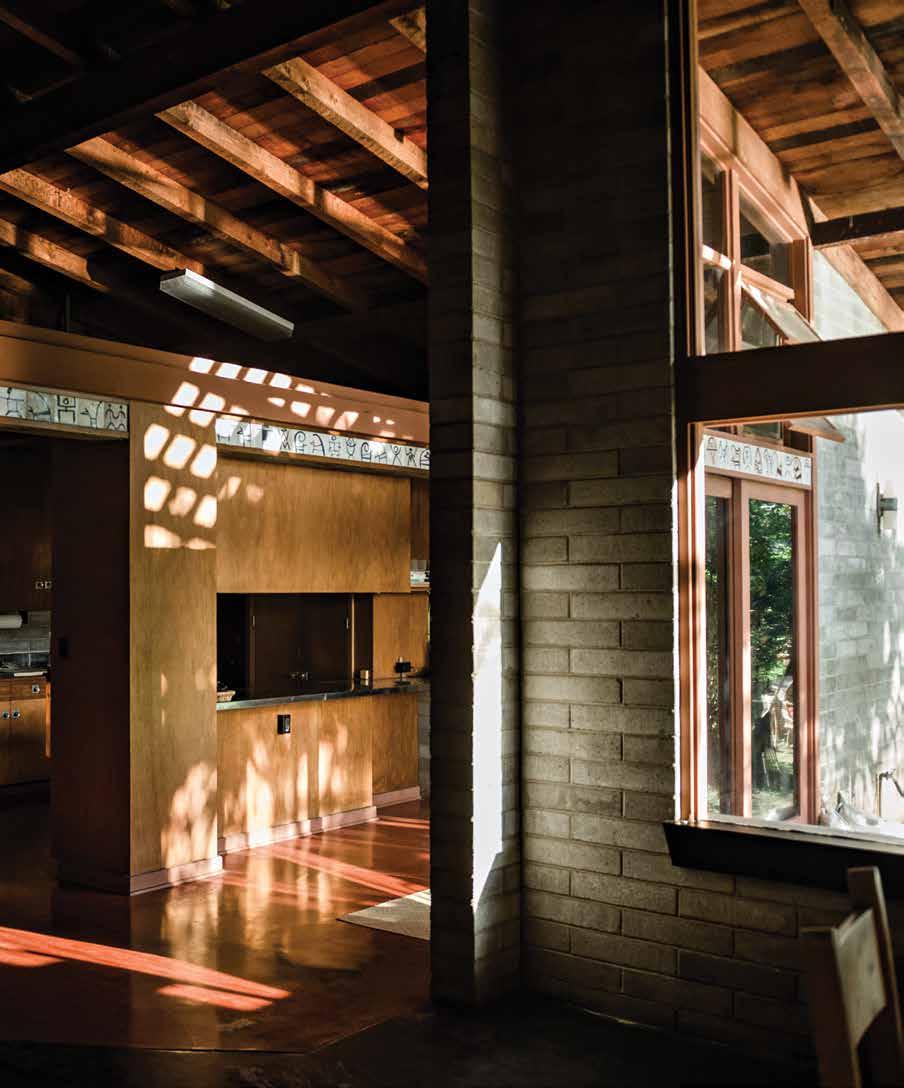
In his modernist Kāhala home, the ever-present artist Jean Charlot’s presence cannot be ignored.
壁画家ジャン・シャルローが住んだカハラの家には、今も彼の個性が 色濃く息づいています。
Jean Charlot의 모더니스트 인 Kahala의 집
에서는 작가의 현존을 무시할 수 없습니다.
그의 작품에서와 같이 자연과 인간의 관계에
대한 Charlot의 주제 적 관심은 가정 디자인
전반에 걸쳐 분명합니다

Remnants of the artist Jean Charlot still haunt the home. Past a series of cantilevered steps within what was once his studio are pinprick indentations along a curved cork wall, which Charlot made when he pinned up drafts of his famed murals. Ambling through the historic property, I stumble upon tiles of handpainted petroglyphs inlaid in the floors, walls, and beams like Easter eggs of artwork hidden throughout the structure. Then there is the home’s pièce de résistance: Above a set of sliding glass doors that lead to the lānai is a fresco spanning the length of the living room. Native flora and tropical plants painted in the Aubusson style, a
その家には、画家ジャン・シャルローの気配がまだ色濃く漂っている。片持ち階 段の横を通り、彼のアトリエだった部屋に入ると、コルク素材のカーブを描い た壁に小さな鋲の跡がたくさん残っている。シャルローが壁画の下描きを壁に 貼った名残りだ。家のなかを見てまわるうちに、ペトログリフをモチーフにした 手描きのタイルが床や壁、天井の梁にも嵌め込まれているのが目に入る。まる で子どもたちのために隠されたイースターエッグのように、建物のあちこちに 芸術作品が身をひそめている。
中でも最も目を惹くのは、リビングからラナイへ続くガラス引き戸の上の スペースをいっぱいに使った壁画だ。ハワイ原生種をはじめ熱帯植物が豊かに
PALM
100 D DESIGN Charlot House
 The split-level ranch style home is a blend of Jean Charlot’s French and Mexican backgrounds.
The split-level ranch style home is a blend of Jean Charlot’s French and Mexican backgrounds.


burst of thick foliage in verdant shades of green, fill the scene. It was completed by Charlot with the assistance of renowned Hawai‘i artist Juliette May Fraser, making it the first artwork to decorate the home—and the last. In the years since the home’s vacancy, when most of the art and books and personal memorabilia have been emptied out, this is among the final to remain.
From its completion in 1958 to Charlot’s death in 1979, this home in the quiet O‘ahu suburb of Kāhala was where the celebrated artist lived, played, and worked. He first conceptualized the property in 1957, when a commission from the University of Hawai‘i at Mānoa for a fresco turned into a full-time teaching position in the university’s art department. He contracted noted Hawai‘i architect George J. “Pete” Wimberly to design it, but blueprints Charlot drafted in his sketchbook also show how involved he was in the design process.
There is a story that Bronwen Solyom, the former curator of UH Mānoa’s Jean Charlot collection, likes to tell. To design the color scheme of the stained-glass façade that would surround the entryway, Charlot drew a template. As if an instructor handing out homework, he disseminated it to friends and family to color in. In the end, Solyom says, Charlot settled on his own color scheme of cerulean, jade, and amber. Yet the idea was very much of Charlot’s nature as a nurturer of creativity, especially in others.
The split-level ranch style home is a blend of Charlot’s French and Mexican backgrounds. Its vertical emphasis evokes the French rural architecture of his childhood. The brick floors and spacious back courtyard are reminiscent of the Mexican homes that Charlot, who was of Aztec descent, inhabited in his early adulthood as an artist working among the likes of Diego Rivera and Fernando Leal.
Yet the home is still uniquely of the Hawaiian Islands, reflecting the sense of place that Charlot often emphasized in his work. There is the wrap-around lānai, a quintessential Hawai‘i design. Natural materials, many of them native, texturize the home, such as the slab wall separating the dining and living rooms which is made entirely of hāpu‘u, the Hawaiian tree fern. It seems like an ordinary wall until a sliver of sunlight streams in, illuminating the countless sprigs crisscrossing its surface. “I don’t think I’ve seen this feature in any other home,” says Daniel Friedman, former dean of the UH Mānoa School of Architecture. “It truly is unique.”
繁る緑の世界が、オービュッソン織りを思わせる様式で描かれている。ハワイ の著名な画家、ジュリエット・メイ・フレイザーの手を借りてシャルローがこの 家のために手がけた最初で最後の装飾画だ。この家が主を失って長い年月が 過ぎ、シャルローの作品や書物、そして個人的な遺品のほとんどが運び出され た後に残った数少ない形見の一つでもある。
オアフ島の閑静な郊外だったカハラにこの家が完成した1958年から最晩年 の1979年まで、シャルローはこの家で暮らし、遊び、仕事をした。シャルローが 家の構想を練りはじめたのは1957年。この年、ハワイ大学マノア校のキャンパ スにフレスコ画を描きに来たシャルローは、ハワイ大芸術学部で教鞭をとるこ とになった。家の設計はハワイの著名建築家ジョージ・J.「ピート」・ウィンベリ ーに依頼したが、シャルローのスケッチブックに残された設計図の数々は、彼 がいかに深く設計プロセスにかわっていたかを物語っている。
ハワイ大学マノア校でジャン・シャルロー・コレクションのキュレーターを務め たブロンウェン・ソリオムさんが、この家の設計にまつわる逸話を紹介してくれ た。エントランスのファサードを飾るステンドグラスの色を決めるにあたって、 シャルローはまずテンプレートを描いた。そして、宿題を生徒に配るようにそ れを友人たちや家族に配り、好きな色を塗らせたという。結局は自分が選ん だセルリアンブルー、ジェイドグリーン、アンバーという配色に落ち着いたのだ が、創造性、特にほかの人の創造性を育むのが得意だったシャルローらしい 逸話だ。
段差のあるスキップフロア構造の牧場風の建物には、フランスとメキシコの血 をひくシャルローの文化的背景が融合している。垂直のラインを強調したデザ インは、彼が子ども時代を過ごしたフランスの田園地帯の建築を思わせ、煉瓦 の床と広びろとした裏庭は、青年時代を過ごしたメキシコの家々に似ている。
シャルローはアステカ族の子孫でもあり、若い頃はディエゴ・リヴェラやフェル ナンド・リールといった画家たちとともに活動していた。
この家にはまた、ハワイならではの個性も備わっている。シャルローは常に自分 の作品の中でその土地らしい感覚を強調していたが、それがこの家にも反映 されているのだ。たとえば家をぐるりと取り巻くラナイはハワイの典型的なデザ インだし、ハワイの原生植物をはじめとする天然素材も家に独特の趣きを添え ている。ダイニングとリビングを仕切る壁の素材は、ハワイ原生の樹木シダ、ハ プウだ。一見ごく普通の壁だが、陽の光があたると無数に交差しあう枝が浮か びあがる。「この素材を使った家屋はほかには見たことがありません」と語るの は、ハワイ大学マノア校建築学部の元学部長、ダニエル・フリードマンさん。「ま ったく独自の素材です」。
PALM
104 D DESIGN Charlot House


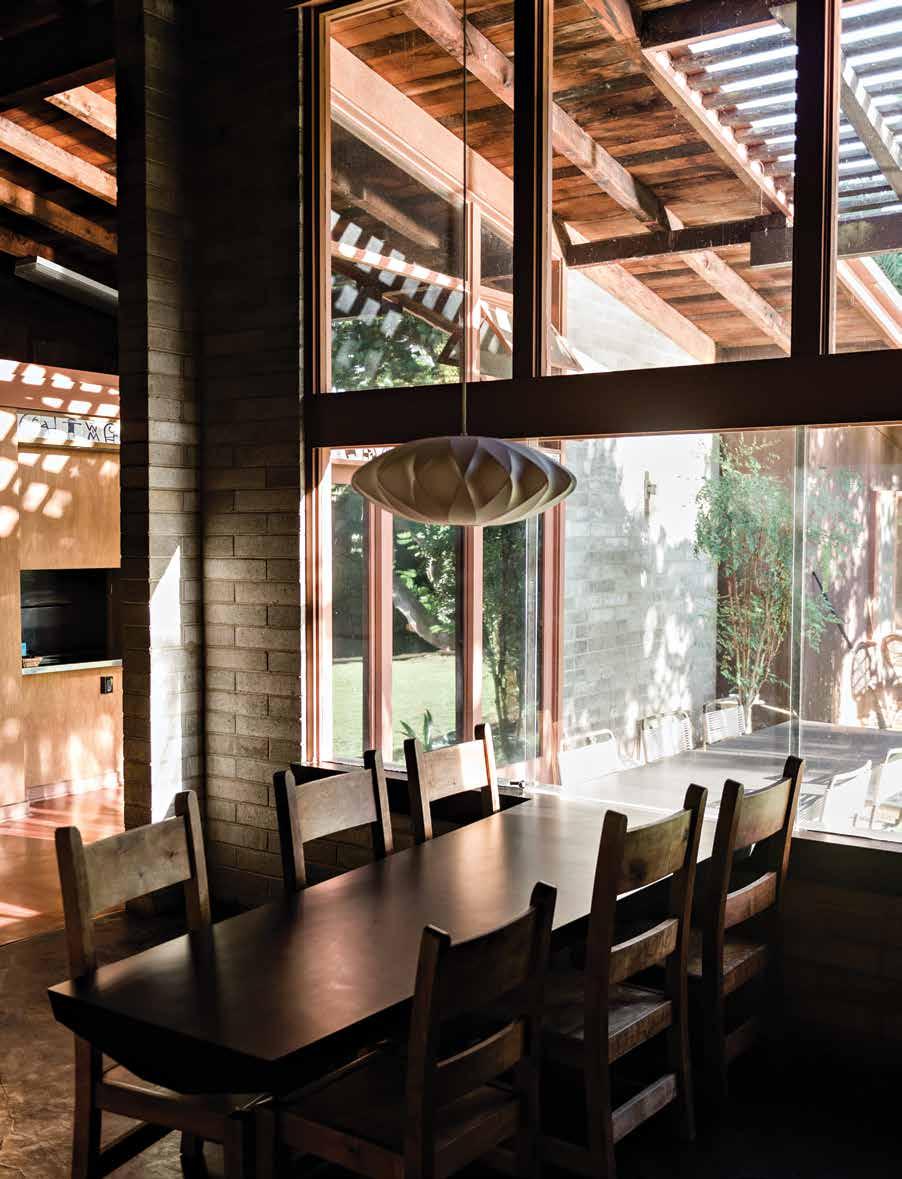

The home reflects the Hawaiian sense of place that the artist often emphasized in his work.
Contrary to his earlier works, which centered human subjects, Charlot’s Hawai‘i phase was stirred by the verdant landscape that surrounded him and inspired by the way Native Hawaiian art symbolically merged man and nature. “Mexico focused on human beings, who carried the main message of an artwork; Hawai‘i focused on an all-encompassing nature,” his son, John Charlot, wrote in an essay examining his father’s relationship to Hawaiian culture. “Rather than the environment and the human community being separate, in Charlot’s mural they form a coherent whole, all bathed in the beautiful local light.”
This coherence of nature and man is evident throughout the home’s design, which blurs the interior and exterior. Floor-to-ceiling glass doors create the illusion of a home with no walls, while natural materials like hāpu‘u and ‘ōhi‘a wood bring the outdoors in. The dining table is the paragon of this philosophy. Designed by Charlot himself, the table branches out from the exterior wall, one half in and the other out, the delineation made by sliding glass windows that meet on top of the table’s middle. During
ハワイに移住する前、シャルローの壁画の題材は人物が多かったが、ハワ イ時代にはそれが鬱蒼とした緑の風景や、人と自然環境を象徴的に融合す るネイティブハワイアンの芸術の影響を受けたものへと変化していった。「 メキシコの芸術は人間が中心で、描かれた人物が画家のメッセージを代弁 するが、ハワイの芸術は、すべてを内包する自然を中心としている」。シャル ローの息子、ジョン・シャルローさんはエッセイの中で父の芸術とハワイ文 化について書いている。「彼の壁画の中では、環境と人間社会は切り離され たものではなく、ともにハワイの美しい光を浴び、つながりあう一つのもの として存在しているのだ」
人と自然との一体感は、屋外と屋内の境界があいまいなこの家の設計にも 顕著に表れている。床から天井まで届くガラスの扉がまるで壁がないかの ような錯覚を生む一方で、ハプウやオヒアなどの自然素材が屋外を室内に 招き入れている。そして、内と外との融合という哲学を最も雄弁に語るダイ ニングテーブル。シャルロー自身がデザインしたこのテーブルは、スライド 式のガラス窓をはさんで半分が外壁から屋外へ、もう半分は壁から家の中
PALM
108 D DESIGN Charlot House
 Artwork by Jean Charlot
Artwork by Jean Charlot

A mosaic of glass windows surround the entryway to the home.
the many soirées held by the Charlots, which were frequented by many in Hawai‘i’s intellectual circles (evidenced by the home’s guestbook), the windows were slid open, the congregation transcending the home’s physical barriers.
Walking through the house, feeling my feet atop the hardwood floors where Charlot walked, it is hard to shake the feeling that the artist is still there. After more than two decades living in the home, this was where he spent the last of his days in March 1979. Six months earlier, he completed his last mural, for Maryknoll Elementary School, part of the many public art works he did for the state.
“Charlot pops into people’s lives in so many different ways—be it through a mural at their old school or a print they’ve discovered,” Solyom says.
“It’s inspiring to know he’s touched so many people.”
へ向かって伸びている。ハワイの知識人たちを招いた数多くのソワレでは( ゲストブックには錚々たる名前が並ぶ)、この窓は開け放たれ、人びとは文 字通り壁を越えて語り合った。
シャルローが歩いた木の床の感触を確かめながら家の中を歩くと、彼がま だここにいるという感覚を振りはらうのが難しい。シャルローは1979年3 月に亡くなるまで20年以上をこの家で暮らし、ハワイ州の公共施設に数多 くの壁画作品を残した。最後の作品となったのは、亡くなる半年前に仕上 げたメリノールスクール初等部の壁画だった。 ソリオムさんは語る。「シャルローの作品は、学校の壁から版画まで、実にさ まざまな形でハワイの暮らしに溶け込んでいます。彼のアートがどれほど多 くの人の心に触れてきたかを思うと、胸が熱くなります」
PALM
110 D DESIGN Charlot House

Lifestyle Salon & On-location Hair & Makeup Open for bookings & Private Consulations 1127 11th Avenue, Suite 202 Honolulu, HI 96816 +1 (808) 732-2569 HMBHNL.COM | @hmbhnl
Makeup Beauty
Hair
In the Heights
Against the manicured greenery of Pacific Heights, and the grain of a midcentury abode, smart and discerning fashions make themselves at home.
by Bailey Rebecca Roberts
by Ara Laylo Hair & makeup by HMB Salon
by Jyoti Mau
Images
Styled
高所で
Modeled


Simone
dress
Chloe shoes
earrings
Are Iconic; Tiffany link bracelet, ring,
wire bracelet from Tiffany & Co.; Tory Burch red cuff bracelet. Gold Band from Ramsey Conder Jeweler.
Rocha
and
from Sak’s Fifth Avenue; M33M’s Designs
from We
and
 Top - Brunello Cucinelli top and bottom from Sak’s Fifth Avenue; Tiffany hoop earrings, link bracelet, and watch from Tiffany & Co.
Top - Brunello Cucinelli top and bottom from Sak’s Fifth Avenue; Tiffany hoop earrings, link bracelet, and watch from Tiffany & Co.
 Proenza Schouler top and skirt, and Tod’s shoes from Sak’s Fifth Avenue; Tiffany link earrings and Elsa Peretti cuff from Tiffany & Co.
Proenza Schouler top and skirt, and Tod’s shoes from Sak’s Fifth Avenue; Tiffany link earrings and Elsa Peretti cuff from Tiffany & Co.


 Rachel Comey jacket, Maryam Nassir Zadeh Gotham skirt, Rachel Comey earrings from We Are Iconic; Tory Burch shoes and watch
Rachel Comey jacket, Maryam Nassir Zadeh Gotham skirt, Rachel Comey earrings from We Are Iconic; Tory Burch shoes and watch

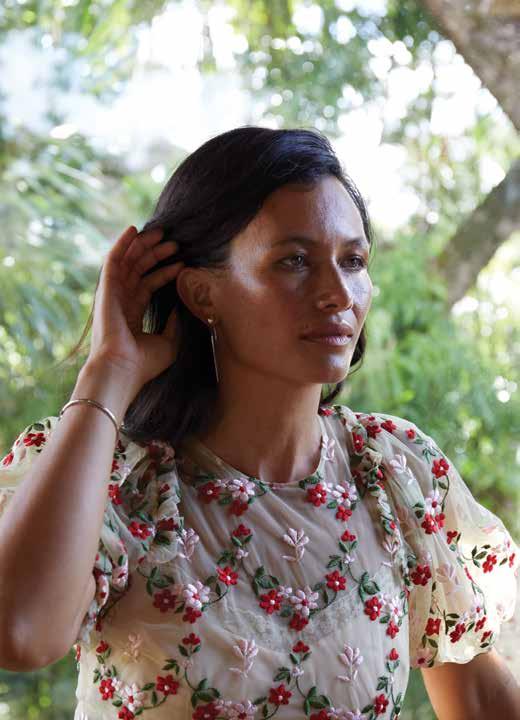 Simone Rocha dress from Sak’s Fifth Avenue; M33M’s Designs earrings from We Are Iconic
Simone Rocha dress from Sak’s Fifth Avenue; M33M’s Designs earrings from We Are Iconic
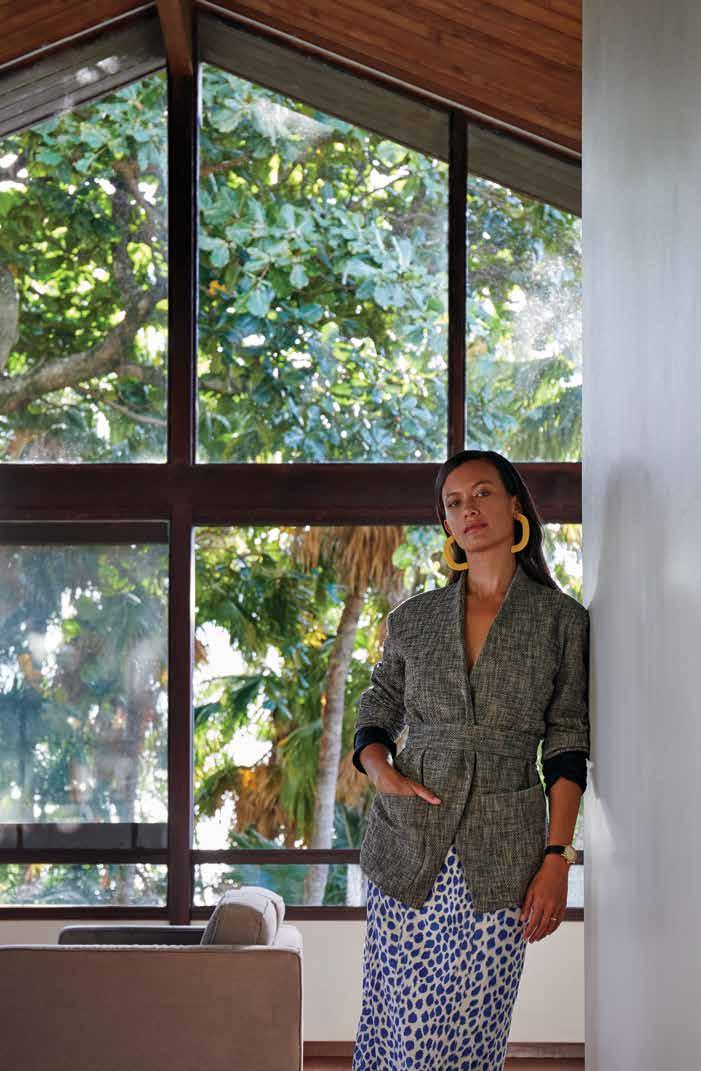

Proenza Schouler top and skirt from Sak’s Fifth Avenue; Chloe shoes; Rachel Comey earrings from We Are Iconic; Tiffany watch, ring, jewelry case, and square bag from Tiffany & Co.
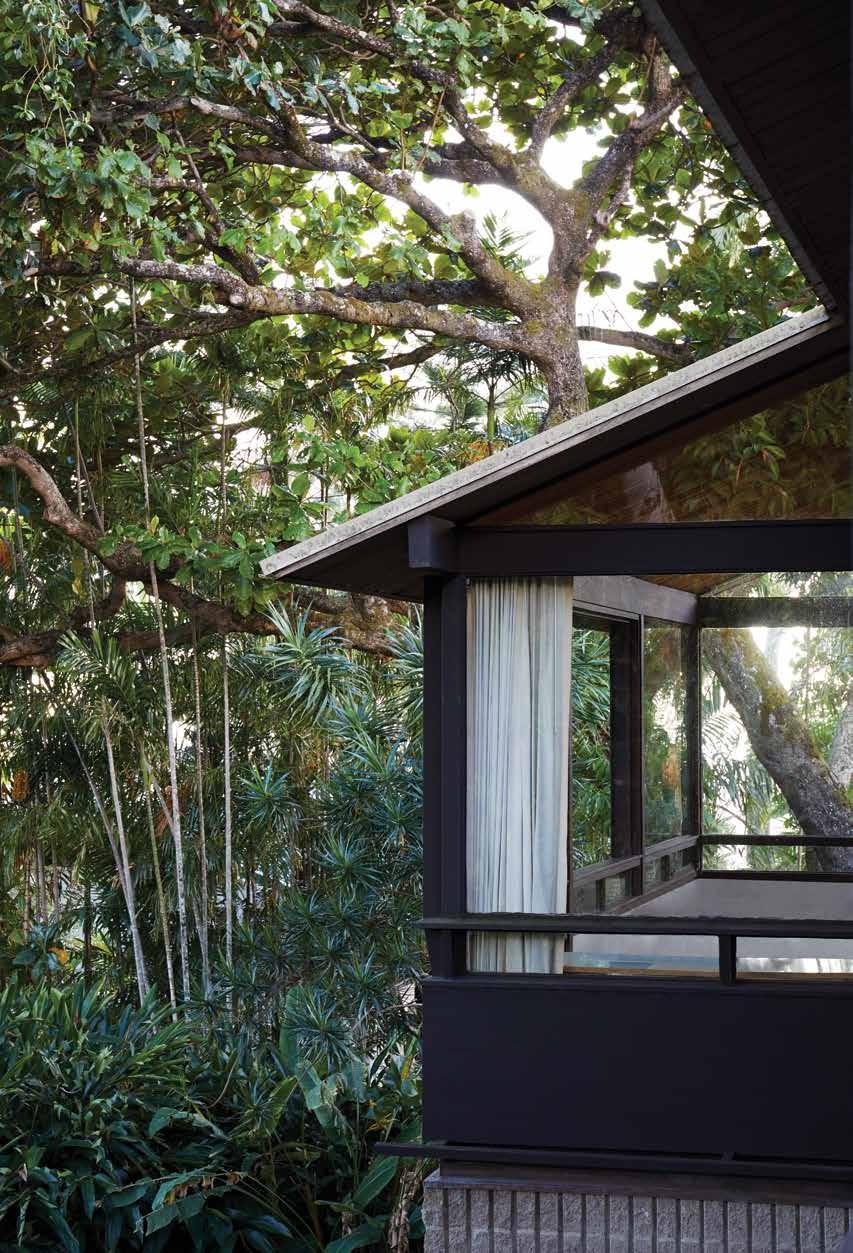

 Top - Helmut Lang top, Brunello Cucinelli jacket and bottom, Tod’s shoes, Off-White bag, all from Sak’s Fifth Avenue; Tiffany earrings and ring from Tiffany & Co.
Top - Helmut Lang top, Brunello Cucinelli jacket and bottom, Tod’s shoes, Off-White bag, all from Sak’s Fifth Avenue; Tiffany earrings and ring from Tiffany & Co.

Travel
ES CA PES
experiences
both
E PALM エスケープ
faraway familiar and
PALM E 129
PALM
Italy in Inverno
インヴェルノ — 冬のイタリア
Text & images by Martha Cheng
文 = マーサ・チェン

130 E ESCAPES Italy PALM
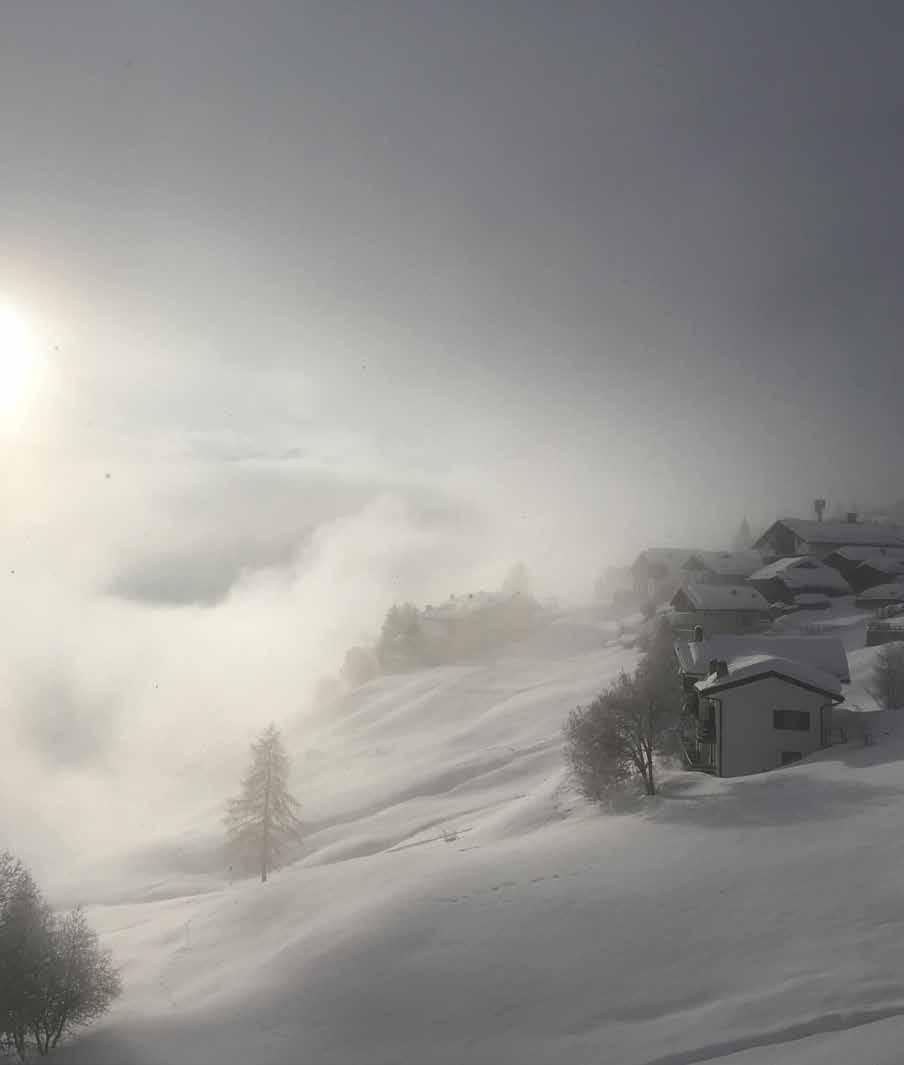
Snow-covered trattorrie, plates of the freshest pasta, and merriment in the Alps abound in this seasonal guide through the country’s famed havens.
雪に囲まれたトラットリア、打ちたてのさまざまなパスタ、アルプスでの冬の冒 険。イタリアの冬にしか出会えない魅力の数々をご紹介します。
이 계절 가이드에는 이탈리아의 유명한 피난처
를 통해 눈 덮인 트라 토리, 가장 신선한 파스
타 접시, 알프스의 즐거움이 가득합니다. 이번
겨울 가이드에서 가장 인기있는 일부 지역의
조용한 코너를 찾으십시오.

In Italy, one of the most visited countries on Earth, it is surprisingly easy to find a quiet corner away from the crowds. In the summer, you can slip out of the famed Cinque Terre and boat over to San Fruttuoso di Camogli, a tiny, clear bay home to a Christ statue sunk in its shallow waters. You can climb in your car and head an hour out of Rome to the hilltop village of Olevano Romano, its stone houses and narrow roads hushed and cool. But in the winter, you needn’t leave any of the popular places to find peace: Even in tourist-burdened Venice, a relative quiet settles like snow. In the past few years, I’ve run to Italy in the winter the way I did to the refuges of my childhood—passing through the curtain of a weeping willow to dream a different life. For in the winter, you can steep yourself in the romance of Venice’s
世界中の旅行者が押し寄せる国イタリアで、人であふれかえっていない静かな一 角を見つけるのは、実は驚くほど簡単だ。夏なら、有名なチンクェテッレの村から ボートに乗って、カモーリのサン・フルットゥオーゾを訪れることができる。透きと おった小さな入り江の浅瀬に沈むキリスト像で知られる場所だ。ローマ周辺なら 1時間ほど車で丘を登ったところに、静かで涼しく、狭い道の両側に石造りの家が 立ち並ぶ丘の上の村、オレーヴァノロマーノがある。でも冬なら、大人気の街も落 ち着いた風情を見せてくれ、観光客でごった返すベネチアでさえ、比較的静かな空 気に包まれる。
この数年、冬になると私はきまってイタリアを訪れている。ちょうど子どもの頃、 しだれ柳の枝をかきわけて隠れ家に通い、自分とは違う人になる空想をめぐらせた ように。冬なら、後ろでわがもの顔に行動する団体客に邪魔されることなく、ベネチ
PALM
132 E ESCAPES Italy
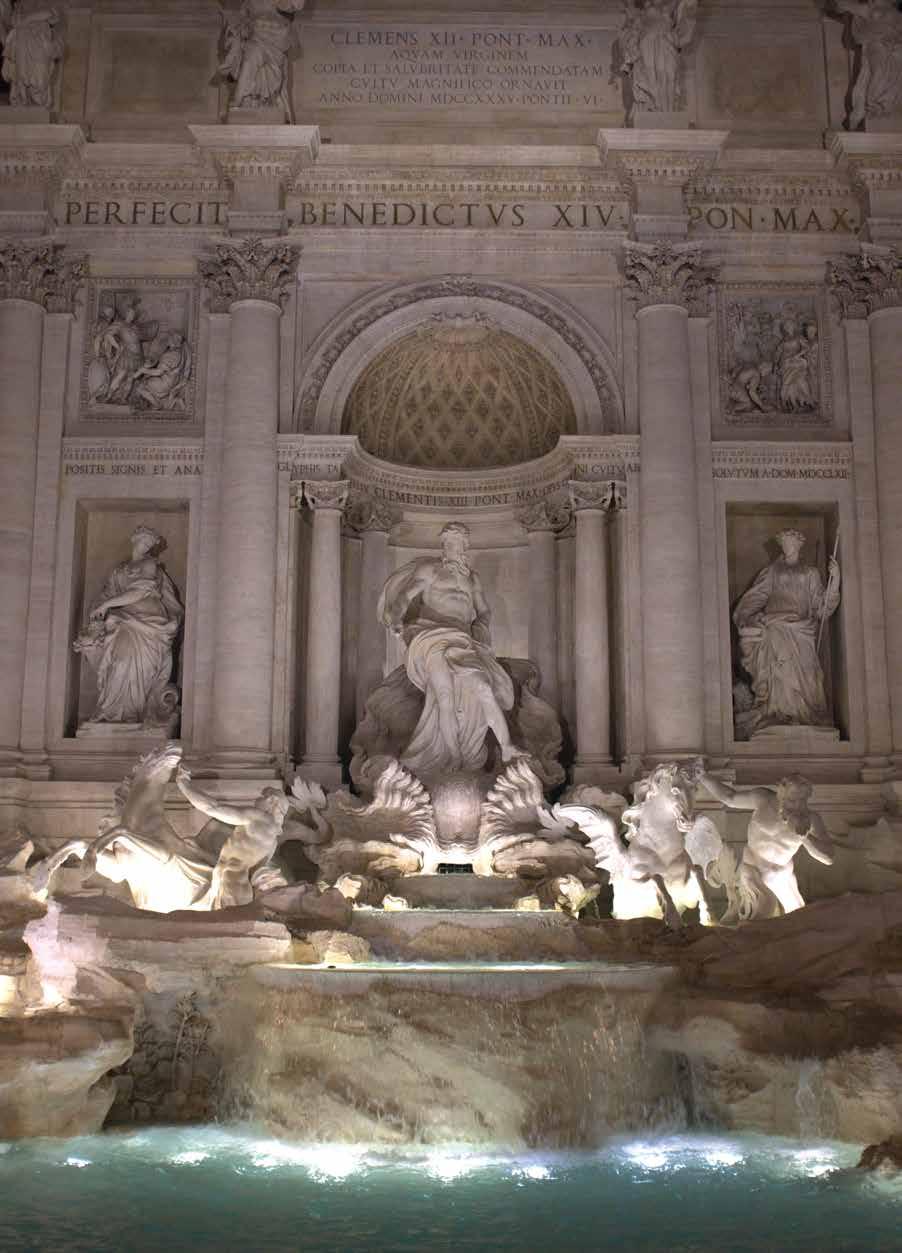
canals without a tourist group stampeding at your back; in Florence you can walk into the Uffizi and directly to David without the hours-long line. I while away time in the heated cafés, pick up paper cones of roasted chestnuts, and shop the markets, marveling at the winter produce: artichokes so tender you can eat them raw, slivered with lemon and olive oil, and puntarelle, with inner stems that I learn to prepare with anchovy and a bit of vinegar. It becomes all too easy to imagine moving into the fantasy.
Last year, I headed to Rome to be in solitude among people. I arrived in time for a rare snowfall, when snowflakes floated through the dome of the Pantheon, and priests threw snowballs outside the Vatican. Icicles formed on Rome’s fountains, some of which are still fed by ancient aqueducts, dripping from the glorious Trevi fountain in the city’s center, the Fontana dell’Acqua Paola on Janiculum Hill overlooking the capital, the whimsical Fountain of Books, the nasoni (literally, “big noses”) that dispense cool and fresh drinking water throughout the neighborhoods. There are more than 2,000 fountains in Rome—more than in any other city—and I hoped to see them all.
But eventually, in a city as social as Rome, I began to feel too alone in the communal joy. All the maritozzi con panna and cacio e pepe are not companion enough; the smooth, cold Bernini sculptures both seduce and unsettle with their longing and violence. I found myself needing deeper connections than those developed in a café. I texted a friend who lives in Turin with her Italian husband and asked what they were doing that weekend. She answered: snowshoeing and mountain food in Aosta. I immediately booked a train ride up north.
The next day, I left behind the mazes and chaos and grand ruins of Rome for orderly Turin, with its wide and elegant avenues. To me, Turin feels more like France, except when aperitivo hour descends and we crowd into bars that, for the price of a spritz, also offer a bottomless buffet of snacks, from salumi to little sandwiches smeared with cheese. You could easily make a meal out of this, but somehow, in Italian logic, it is only supposed to stir our appetite for dinner. We drove up a hill to a trattoria near the Basilica di Superga and continued eating and drinking through plates of fresh pasta, and most amusing to me, fritto misto piemontese—deep-fried artichokes and squash blossoms … and custard and apples and cookies. American state fairs are not the only places where people fry everything sweet and savory in sight.
In the morning, we headed to Aosta, in the Italian Alps. My friend’s husband sped on the highway, taking the curves with the mixture of impatience and relish that Italians have for the road. We arrived at the cable-car station that would take us up into Chamois village, and he pushed my friend out the door to tell the operator to wait for us while he parked. But it was too late. We saw it ascending the mountain. The husband sighed, loudly and irritably. That was the last one of the day? I asked, thinking we had made the hour drive in vain. No, he said, it comes every 20 minutes.
アの運河の歴史に思う存分思いを馳せることができるし、フィレンツェではウフィツィ美 術館やダビデ像のあるアカデミア美術館に入るために何時間も並ばずにすむ。暖房の きいたカフェで休憩したら、紙に包んで売られている焼き栗を手に冬の野菜や果物が並 ぶ市場を見て歩くのが私のお気に入り。アーティチョークはとても柔らかいので、細長く 割き、レモンとオリーブオイルをつけて生で食べられる。それから、プンタレッラ。これは 内側の茎をアンチョビとお酢少々で和える食べ方を教えてもらった…。イタリアのことを 考えはじめると、つい想像力がかき立てられて、空想にふけってしまう。
昨年の冬は、雑踏の中での孤独を楽しむのも一興と、ローマへ向かった。到着すると ローマでは珍しい雪が降っていて、パンテオンのドームの開口部から雪がひらひらと舞 い、バチカンの近くでは聖職者たちが雪玉を投げあっていて、噴水にはつららができて いた。ローマの噴水の中には、今でも古代の水道から水をひいているものがある。あの 壮麗なトレヴィの泉もそうだし、街を一望できるジャニコロの丘にあるアクアパオラの噴 水も、あの風変わりな本の泉も、それからナゾーニもだ。「大きな鼻」という意味のナゾー ニは街のいたる所にあり、冷たくて新鮮な飲み水を市民に提供している。ローマにある 噴水の数は2,000以上。世界のほかのどの都市よりも多い。私はそれを全部、見てみた いと思っている。
しかし、ローマのように人と人との結びつきの強い社交的な街で、私はだんだんと強 く孤独を感じるようになっていた。ひとりで食べるマリトッツォコンパンナやカチョエペ ペの皿は相棒と呼ぶには不十分だったし、冷たく滑らかな肌をしたベルニーニの彫刻 は、その激しさと荒々しさで落ち着かない気持ちにさせた。いつの間にか私は、カフェで 顔見知りになった人と交わす会話以上の、人との深い結びつきを求めていたのだ。イタ リア人男性と結婚してトリノに住んでいる友人にメッセージを送ってその週末の予定を 聞いてみると、アオスタでスノーシューをして、山の幸を楽しむつもり、という返信が来 た。私はその場で、北行きの列車を予約していた。
翌日、私はローマの迷路と混沌と壮大な遺跡をあとにして、優雅な大通りが街をつ らぬく端正なトリノに向けて出発した。トリノはむしろフランスに近い感じがする街だけ れど、アペリティーボの時間だけは別だ。スプリッツの代金を払うだけでいろいろなサラ ミからチーズを塗った小さなサンドイッチまで軽食を好きなだけ食べられるこの時間、 人々はバーに押し寄せる。その気になれば1回分の食事になるほどお腹いっぱいに食 べることもできるけれど、なぜかイタリア人にとって、アペリティーボは夕食に向けて食 欲を刺激するためだけのものらしい。バーを出た私たちは丘の上にあるスペルガ聖堂の 近くのトラットリアにまで車を走らせ、そこでも生パスタなどの料理を平らげ続け、お酒 を飲み続けた。中でも魅力的だったのは、フリットミストピエモンテーゼと呼ばれるフリ ットの盛り合わせ。アーティチョーク、スクワッシュの花、カスタード、リンゴ、クッキーま で、何もかもが揚げられて出てくる。甘いものも塩味のものも手当りしだいになんでも揚 げてしまうのは、アメリカのステートフェアの屋台だけではないのだ。
翌朝、私たちはイタリアンアルプスの街、アオスタへと向かった。友人の旦那様はド ライブ好きなイタリア人らしく、カーブにさしかかるたびにもどかしさ半分、楽しさ半 分を顔に表しながらハンドルをさばき、幹線道路を猛スピードで飛ばしていく。山頂に あるシャモワ村行きのケーブルカーの駅に着くやいなや、彼は友人を急いで車から降 ろした。自分が駐車している間、出発しないで待っていてくれるよう運転手に頼んでく れ、というのだ。でも時すでに遅し。ケーブルカーはもう山を登りはじめていた。彼はい
PALM
134 E ESCAPES Italy
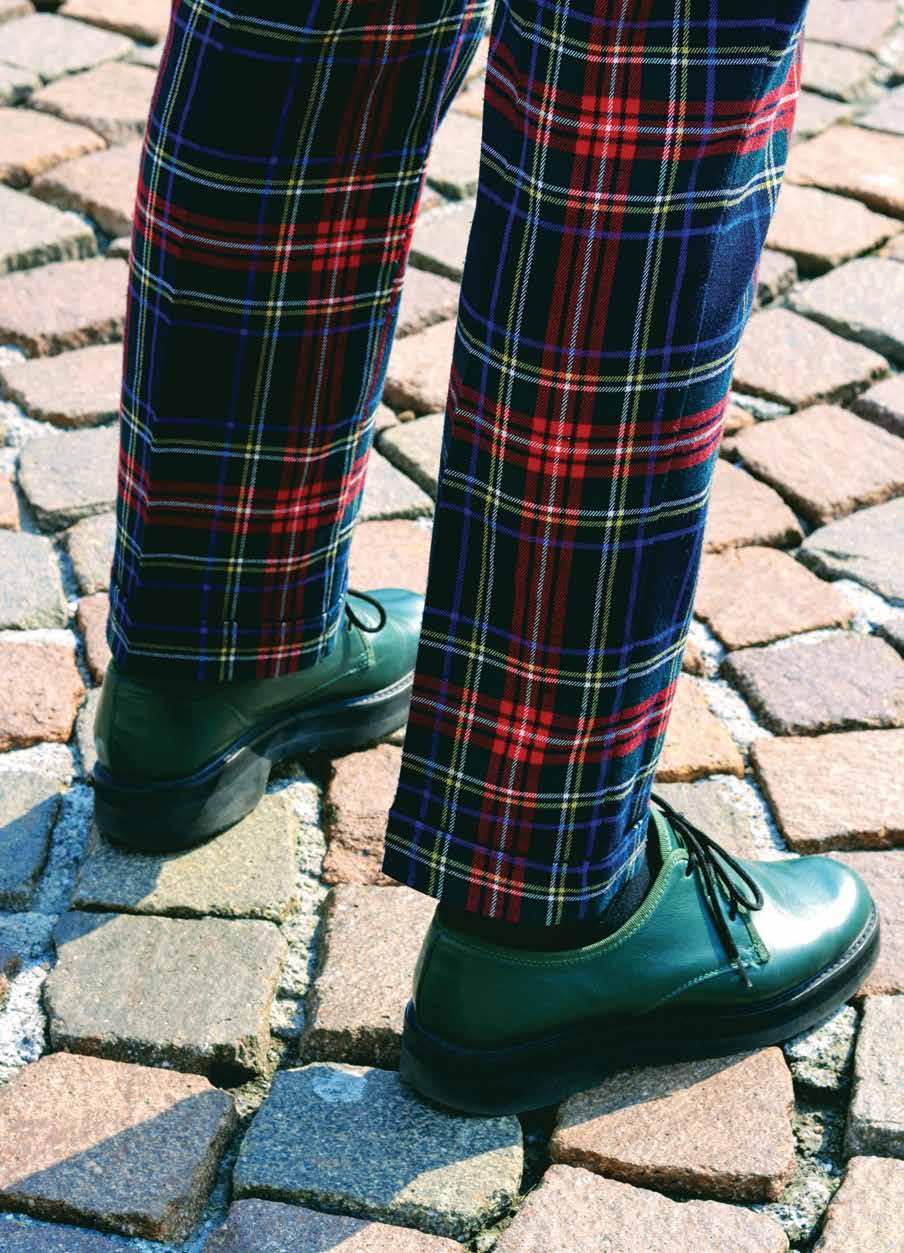




IF YOU GO
ROME
For maritozzi con panna: Roscioli Caffè, Piazza Benedetto Cairoli, 16 For cacio e pepe: Armando al Pantheon, Salita dei Crescenzi, 31
TURIN
For traditional dishes from Piedmont: Ristorante Trattoria Bel Deuit, Via Superga, 58
CHAMOIS
For mountain cuisine: Chez Pierina, Frazione Corgnolaz, 58
ローマ
マリトッツォコンパンナ: Roscioli
Cafe(住所: Piazza Benedetto Cairoli, 16)カチョエペペ: Armando al Pantheon(住所: Salita dei Crescenzi, 31)
トリノ
ピエモンテの伝統料理: Ristorante Trattoria Bel Deuit(住所: Via Superga, 58)
シャモワ
山の幸料理: Chez Pierina(住所: Frazione Corgnolaz, 58)
Twenty minutes was apparently an exasperating length of time between us and our next meal. As soon as we got out of the cable car, we entered a warm lodge to eat once again. At this point, given the six hours of dining the previous night, I suspected that our eating to exercise ratio would be something like 10-to-1. I wasn’t wrong. Over the next two and a half hours, our table was loaded with bottles of wine, wedges of cheese made in the mountains alongside shavings of cured beef and snow-white pork fat, a pot of polenta bubbling with fontina, and venison roasted in the oven with wild berries. I was utterly seduced, drunk not only on the actual food and wine, but also on the idea of it—that in our snowy perch in Italy, it was like we had stepped into the pages of a book, into a merry tableau that existed long before us and would continue long after we left.
I don’t know how we strapped on our snowshoes after that. But we did, and we stepped further into the dream. Snow had buried the bridges, piled on the rooftops, coated the trees—it subdued everything, as if all those objects existed only to lend shape to the formless. If we wandered off the path, we sank to our chests in softness. At one point, as it snowed, it became hard to differentiate between clouds and snowbanks in the distance, until, for a moment, the sun broke through, and it looked as if diamonds were drifting down from a scratch of blue in the sky. I marveled how in just over a day, I had transitioned from being alone in a city to a land with friends and no one else
ら立たしげに大きなため息をついた。「今日の最終だ ったの?」1時間かけてここまで来たのが無駄になっ たのかと思って、私がそう尋ねると、彼は答えた。「い や、20分おきに来るんだがね」
どうやら、次の食事までさらに20分の待ち時間と いうのは、気が遠くなるほどの長さなのらしい。ケーブ ルカーを降りるとすぐに私たちは食卓をめざして暖か いロッジに入った。そのとき、前の晩に夕飯を6時間 も食べ続けていたことを考えると、ひょっとして、食べ ている量と運動量の比率は10対1ぐらいなのでは、と いう考えが浮かんだ。そしてそれは間違いではなかっ た。それからの2時間半、私たちのテーブルには、ワイ ンのボトル、地元の山岳地帯でつくられたチーズ、塩 漬け牛肉と雪のように白い豚のラルド、フォンティー ナチーズがグツグツと音を立てるポレンタ、鹿肉と野 生の木イチゴのオーブンローストが所せましと並ん だ。私はすっかり魅了され、目の前の食べものとワイン にだけではなく、食事そのものに酔ってしまった。雪に とざされたイタリアの山地で、まるで歴史の一コマの 中に足を踏み入れたかのような、私たちよりもはるか 昔から存在し、私たちがいなくなった後も変わらずに ある、陽気な一幅の絵の中に入り込んだような気分だ った。
その後、どんな風にしてスノーシューを装着した のかは覚えていない。でも、たしかにスノーシューを 履いて、さらに夢の中へと入っていったのだ。雪は橋 を完全に埋め、屋根の上にうず高く積もり、木々を覆 っていた。雪がすべての上に君臨していた。まるで、あ らゆるものが形のないものに形を与えるためだけに 存在しているかのように。もしコースから外れていた ら、私たちは柔らかな雪に胸まで埋まっていたことだ ろう。いっとき、降りしきる雪の中でしばらくの間、雲 と遠くの雪だまりの区別がつかなくなっていた。その とき、太陽が一瞬だけ雲の間から顔を出して、小さな 青空のきれはしからダイヤモンドが舞い散っているか のような光景が目の前に広がった。わずか一日前には 都会でひとりきりだったのに、今は友人と一緒に山の 中にいて、そしてまわりにはほかに人の姿もない。私は 不思議な感慨に満たされていた。 around.
PALM
138 E ESCAPES Italy

The Ritz-Carlton Residences, Waikiki Beach 383 Kalaimoku St., Honolulu, HI 8F lobby level 808 729 9729 4 hour complimentary valet parking laviewaikiki.com Modern French. Aloha Spirit. La Vie, a new approach to multi-course modern French dining Dinner daily from 5PM–9PM The Lounge, located adjacent to La Vie, offers a range of craft spirits, select beers, and classic cocktails. Live Piano nightly from 6PM–�PM
Restoring Kure
クレ環礁の自然を復元する
Text & images by Zachary Pezzillo
文と写真 = ザカリー・ペッツィーロ
140 E ESCAPES Kure Atoll PALM

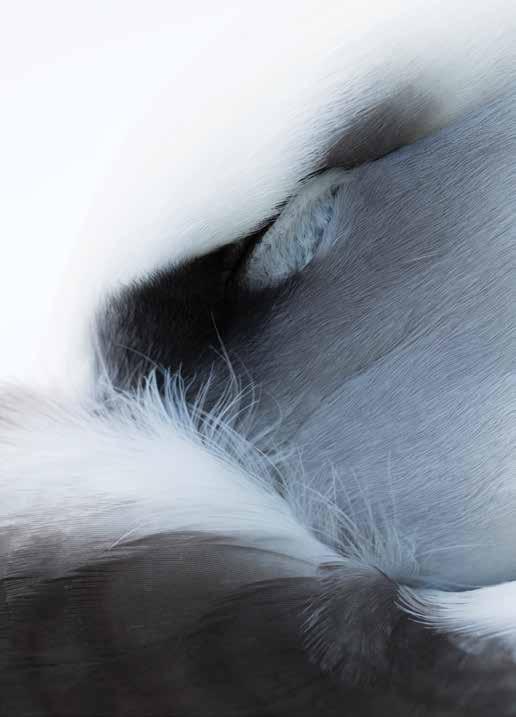
After seven months spent on Kure Atoll, a conservationist reflects on its remote and challenging conditions.
Kクレ環礁で7か月を過ごした自然保護活 動家が、文明から遠く離れた日々を振り 返ります。
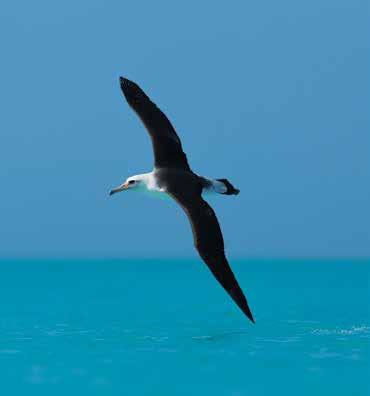
Holaniku 또는 Mokupapapa로도 알려진 Kure Atoll은 하와이 북서부에서 가장 먼 북서쪽입니다. Kure Atoll에서 7 개월을 보낸 후, 보수주의자는 외진 환경과 도전적인 조건을 반영합니다.
ure Atoll, also known as Hōlanikū or Mokupāpapa, is the furthest northwest of the Northwestern Hawaiian Islands and the Papahānaumokuākea Marine National Monument. It is the most northerly atoll in the world, lying roughly 1,400 miles northwest of O‘ahu. The remnant of an ancient volcano, the atoll has a circular reef that is at most six miles in diameter. I am standing on the atoll’s only island, a small, crescent-shaped spit of land totaling a mere third of a square mile in size, ringed by a continuous stretch of brilliant white sand.
Bordering the beaches are dense, tangled shrubs of naupaka, some of which reach more than 10 feet high. In the center is an open, grassy plain dotted with kawelu, a native bunch grass. The island is quite flat, the highest point being roughly 20 feet above sea level. Kure is populated only by the hundreds of thousands of seabirds that come here each year to mate and raise their young, along with Hawaiian monk seals, green sea turtles, and other marine species.
Over the past 200 years or so, humans have left their mark on this avian utopia, bringing with them invasive plants, insects, and diseases from other parts of the world that choked out the native flora, causing the populations of native fauna to plummet. Every day the wildlife here struggle to survive amid the ever-encroaching hands of humankind. Albatross feed their chicks plastic they mistook for food while foraging on the open ocean. Netting and other debris cast aside by fishermen entangle critically
「ホラニク」または「モクパパパ」とも呼ばれ るクレ環礁は、北西ハワイ諸島の西北端、 パパハナウモクアケア・ナショナル・モニュメ ント内でも一番端にある、世界で最も北に 位置する環礁だ。オアフ島からは北西に約 2,250キロメートルの距離。古代火山の名 残の上にできた円形のサンゴ礁で、直径は 9.6キロメートル。環礁にある唯一の島は面 積わずか85ヘクタール程度の三日月形をし た小さな陸地で、真っ白に輝く砂浜にぐるり と囲まれている。
その砂浜をふちどるようにびっしりと生 え、枝をからみあわせているのはナウパカと いう灌木で、中には高さ3メートルを越える ものもある。島の中央の平原には、イネ科の 在来植物であるカヴェルという草が点在し ている。ごく平坦な島で、最高点でも海抜6 メートルほどしかない。ここに棲むのは毎年 繁殖のためにこの島にやって来る数十万羽 の海鳥たち、ハワイモンクアザラシ、アオウミ ガメなどの海洋生物たちだ。
過去約200年間、人間は鳥たちの楽園だ ったこの島に大きな爪あとを残してきた。人 間が世界の他の地域から持ち込んだ外来の 植物や昆虫、病気が在来植物を圧倒したた め、在来動物の数も激減したし、生息環境に 人間の影響が常に忍び込んでくるなかで野 生動物たちは生き残るために苦闘している。 大海原で餌と間違えて巣に持ち帰ったプラ スチック片をアホウドリがヒナに食べさせて しまう。漁師が捨てた網などのゴミが、絶滅
Mōlī (Laysan albatross) are one of the many species of seabirds that populate Kure Atoll.
世界有数のサーフィンで有名な オアフのノースショアにあり、地 元の魅力溢れるハレイワとワイ アルアの街。
142 E ESCAPES Kure Atoll



endangered Hawaiian monk seals. Invasive plants that have naturalized themselves threaten the nesting habitat of the atoll’s native seabirds. As I look over the island from the top of the dune, I try to imagine the pristine paradise it once was, a truly native island where wildlife thrived in perfect balance of give and take.
The State of Hawai‘i Department of Land and Natural Resources’ Division of Forestry and Wildlife established remote field camps on the island 25 years ago. The goal of the division, now supported by the Kure Atoll Conservancy, is to restore Kure Atoll as close to its natural state as possible, allowing its native inhabitants to thrive in a properly functioning ecosystem once again.
Small but dedicated crews of habitat restoration technicians such as myself arrive by ship after weeklong journeys by sea to spend either the winter or summer season living and working on this extremely remote outpost. There is no electricity and communication with the outside world is limited. All food and supplies are brought with crews and rain catchment is relied on for fresh water. Our days here are long and rigorous. We work to eradicate Verbesina encelioides, a tenacious and invasive plant that once covered most of the island’s open areas and made it difficult for albatross and other seabirds to successfully nest and raise their young. Thousands of pounds of trash, mostly plastic and netting, litter the island, swept in with the currents from elsewhere. Knowing it is impossible to remove it all, we focus on collecting fishing lines, nets, and other marine pollution in which birds, seals, and turtles are most likely to get tangled.
We are heartened when we see the results of this collective work, both ours and of the decades of crew before us. Native plants are returning in areas that were once entirely covered in weeds, creating a better habitat for the island’s avian inhabitants and making it possible for future generations of seabirds to exist. When birds and seals become caught in detritus that has made it to our shores, we free them from it and, in doing so, are rewarded by the knowledge that we have saved lives. By restoring and maintaining diversity among this isolated ecosystem, we are helping the much larger and more global ecosystem to function and thrive.
When I first arrived, I was told by members of the departing crew that Kure would change me. It has. Life here is incredibly simple, profoundly uncomplicated, and dictated almost entirely by nature. The absence of the constant thrum of noise associated with the outside world affords a sort of clear-headedness that doesn’t exist elsewhere. The ability to focus becomes intensified and even exhilarating. Learning and adapting to ever-
危惧種であるハワイモンクアザラシの身体に絡まる。外来植物が環 礁に昔から生息していた海鳥たちの営巣地を脅かす。私は砂丘の上 に立って島を見渡しながら、ここが汚れなき楽園だった時の姿を想 像してみる。それは、野生生物たちが持ちつ持たれつの完璧なバラン スで共存する本当の自然の島だったに違いない。
ハワイ州土地天然資源局の森林・野生動物課は、25年前、この島 にリモートフィールドキャンプを設置した。同課の目標はクレ環礁を できるだけ自然に近い状態に復元し、在来生物が適切に機能する生 態系の中で再び繁栄できるようにすることで、今ではクレ・アトール・ コンサーバンシーのサポートも受けている。
少人数だが献身的な生息環境復元技術者たちからなる作業クル ーが冬季と夏季に1週間かけて船でやってきて、この究極の辺境にあ る基地に滞在し、復元作業に従事している。私もその一人として参加 した。この島に電気はなく、外界との通信も限られている。食料も資 材もすべてクルーが持ち込むものに限られ、水は雨水を使う。ここで の日々は長く厳しい。まず、ヴェルベシナ・エンケリオイデスの撲滅作 業がある。この強靭な外来植物は、一時は島の開けた地域をほとん ど覆いつくし、アホウドリをはじめとする海鳥たちの巣作りと子育て を困難にしていた。さらに、他の海域から海流で運ばれ、島に散らば っているプラスチックや漁網などの何トン分ものゴミの除去作業が ある。全部除去するのは無理なので、鳥やアザラシ、カメたちに絡ま る可能性が高い釣り糸や漁網などの海洋ゴミを集中して拾う。
今回の私たちの作業やこれまでの数十年間に参加したクルーに よる作業の成果を見ると、勇気づけられる。一度は完全に雑草に覆 われていた区域にも在来植物が戻りはじめ、鳥たちのためにより適 した生息環境となって、将来の世代が存続できるようになってきた。
海洋ゴミに絡まった鳥やアザラシを見つけ、ゴミを外して自由にして やるときは、命を救えた実感で心が満たされる。この孤立した生態系 の生物多様性を復元し維持することが、この島よりもはるかに大きく グローバルな生態系がうまく機能し繁栄するのを助けることにつな がるのだ。
私が到着したばかりの時、入れ替わりに島を去るクルーのひとり が、クレはあなたを変えるだろう、と言ったが、それは本当だった。こ こでの生活は驚くほど簡素で、深遠なまでに単純で、ほぼ完全に自然 に支配されている。外の世界にいればひっきりなしに聞こえてくる騒 音がないので、他の場所ではありえないほど頭が冴えてくる。爽快な ほどに集中力が高まるのだ。変化し続ける条件と状況を学んでそれ に適応することがほとんど本能的にできるようになってくる。ここで
PALM
146 E ESCAPES Kure Atoll

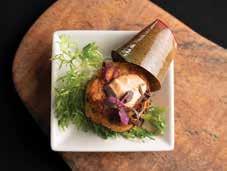


CATERING BY HY’S
A black tie experience, bringing our iconic table side preparation of salads and flambe desserts and our attention to detail to your next special gathering.

A “USDA PRIME BEEF” SPECIALTY HOUSE
A fine-dining tradition in Hawaii for 43 years. Experience the flavorful difference as the only steakhouse in Waikiki to broil over fragrant Hawaiian kiawe wood.
For catering inquiries, email catering@hyshawaii.com.
OPEN DAILY 5PM–10PM 808 922 5555 HYSWAIKIKI.COM 2440 KUHIO AVENUE HONOLULU, HI COMPLIMENTARY FOUR HOUR VALET PARKING

changing conditions and circumstances becomes almost instinctual. Here, we learn to make do with what we have on hand; anything more is considered unnecessary and even frivolous. When the trivial aspects of our lives slip away, we are left with profound appreciation of the importance of family and friends.
I will miss Kure and all the unique and quirky creatures that call it home: the stunningly graceful fairy terns whose tendency to lay their solitary eggs in the most precarious of spots defies gravity and common sense; the wild enthusiasm of the male ‘iwa birds, warbling loudly, their heads thrown back and their bright crimson gular pouches fully inflated while desperately trying to keep from falling off their perches in the naupaka; and finally, the mighty mōlī, whose regal presences reminds us daily of the importance of our work.
I will miss being at the mercy of the rawness and strength of nature’s elements and the extreme isolation that is difficult to find anywhere else. I will miss the moments that define our time here and the camaraderie forged from sharing these experiences. Memories tend to fade with time, but knowing that, in my own small way, I have contributed to preserving this remarkable place is an undeniable honor that will remain with me always.
は、なんでも手元にあるもので間に合わせる術を学ぶ。それ以上 のものは不要で余計なものに見えてくる。生活の中の瑣末な事柄 がどうでもよくなり、家族や友人の大切さが深く感じられるように なる。
私はこれからもずっと、クレ環礁と、ここに棲むユニークで風変 わりな生き物たちを懐かしむことだろう。目が覚めるほど優美で、 たった一つの卵を重力と常識に逆らって最も危なっかしい場所 に産むヒメアジサシ。ナウパカの枝から落ちないよう必死につか まりながら頭を反らせて真紅の喉袋をいっぱいに膨らまし、大音 量でさえずる雄のイヴァ(オオグンカンドリ)の熱烈な求愛。そし て、威厳ある姿で私たちの仕事の大切さを日々思い出させてくれ る雄大なモリ(コアホウドリ)。
荒々しく強大な自然の力の前に立ちすくむしかなかった経験 や、ほかの場所ではめったにない究極の孤立の感覚も、懐かしく 思うだろう。それから、ここで過ごした日々を忘れ得ぬものにした 数々の瞬間と、その体験を共有するなかで培った仲間たちとの絆 も懐かしむだろう。記憶は時の流れとともに薄らいでいくが、それ でも、ささやかながら自分がこの素晴らしい場所の保全に寄与で きたという栄誉を忘れることはないだろう。
PALM
148 E ESCAPES Kure Atoll
An aerial view of Kure Atoll.
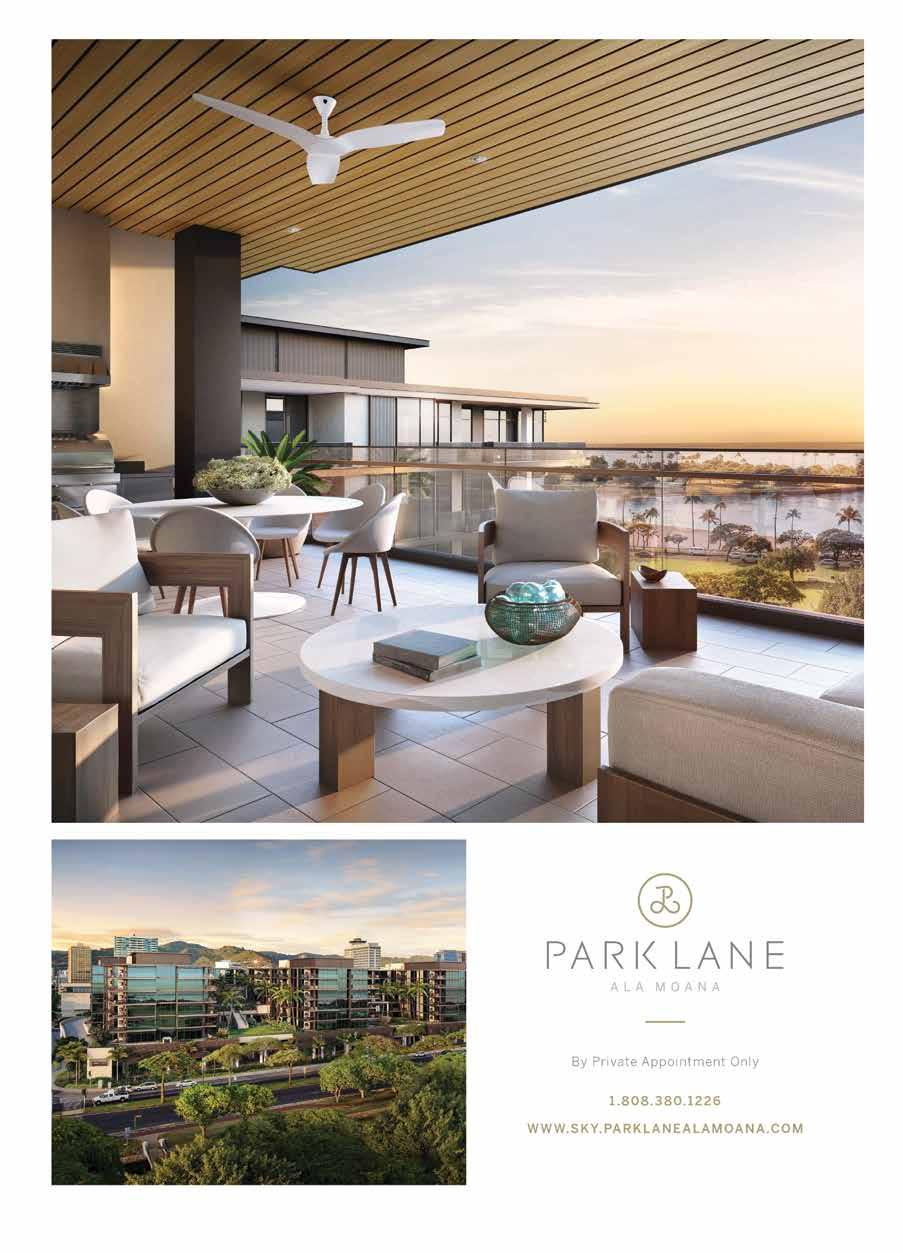



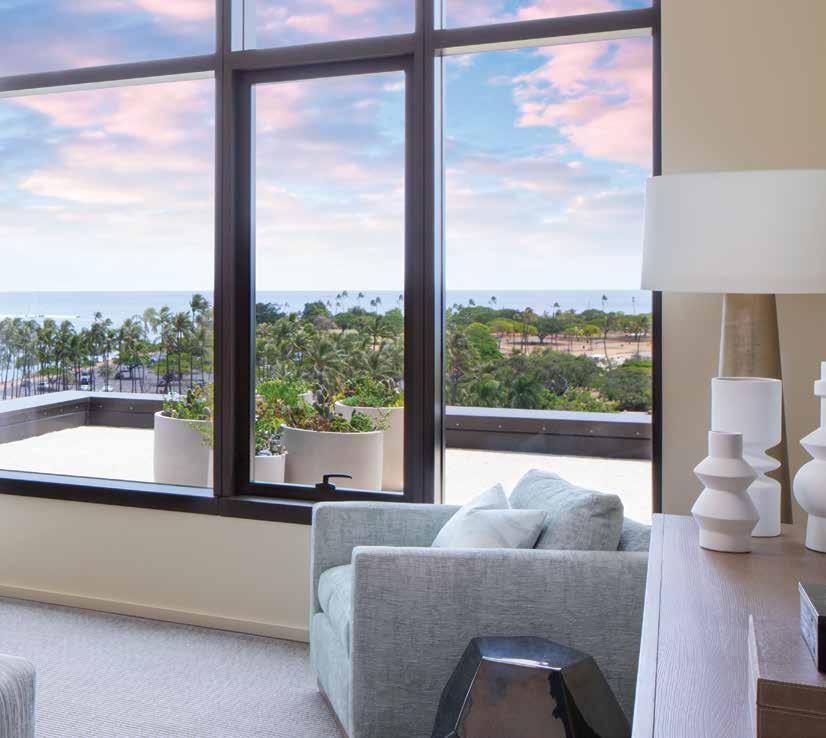
An Exquisite Estate In The Sky
Welcome to the Sky Residences, in the award-winning Park Lane Ala Moana. Experience the comfort, privacy and security of a single-family home and the relaxed refinement of a cosmopolitan oasis, right in the heart of Honolulu.

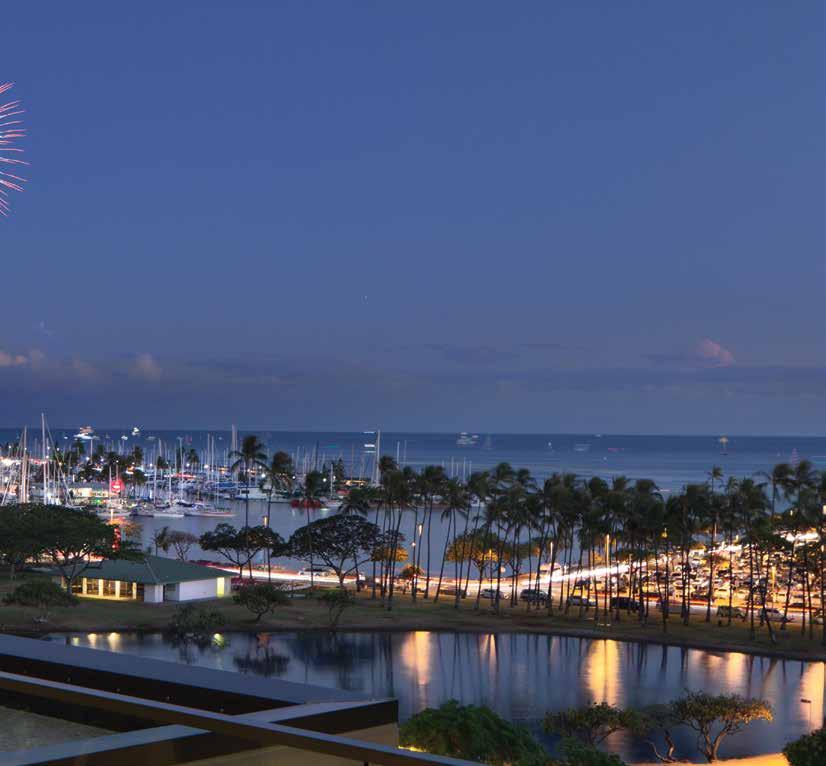


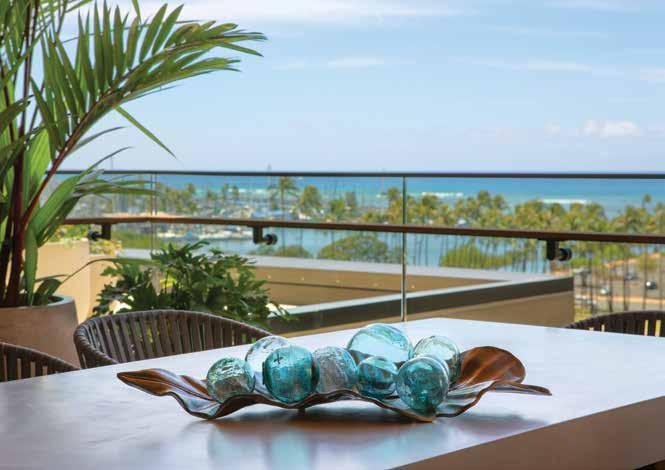

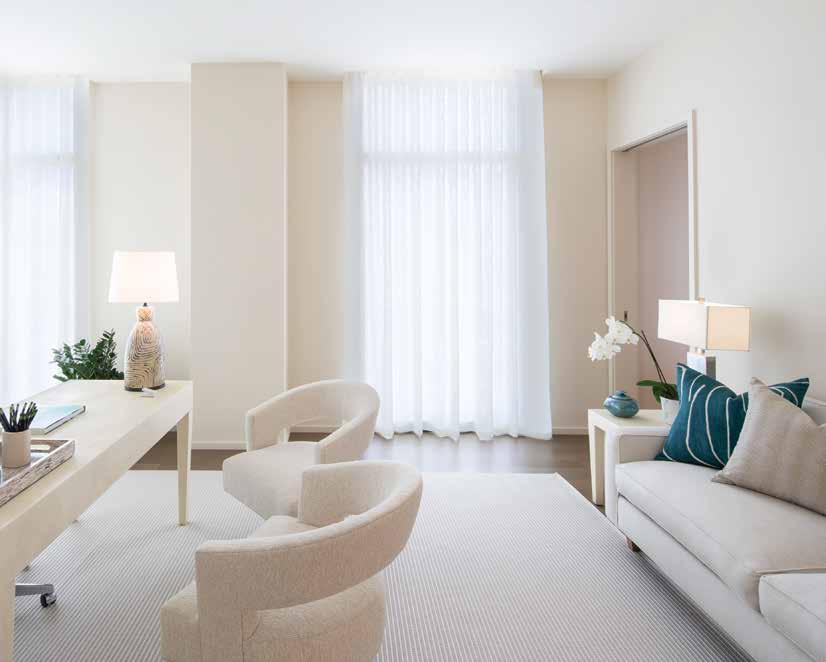



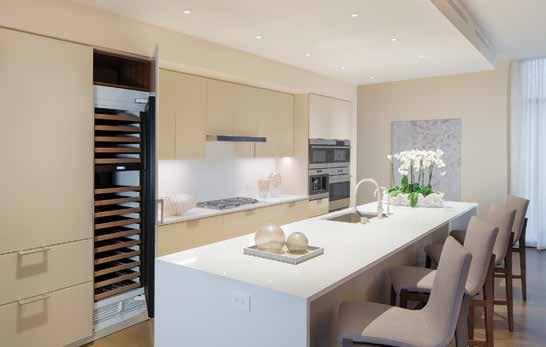
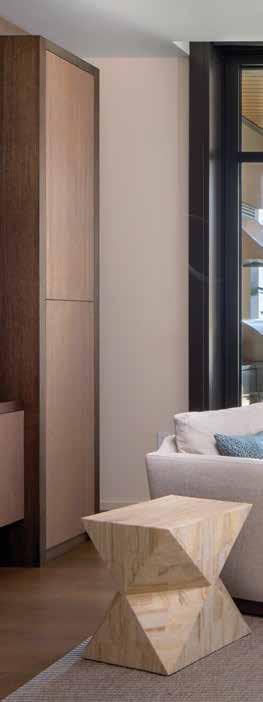



Personalized Service, Elegantly Presented
To Park Your Car or Arrange Transportation
For Daily Needs, Large or Small GLOBAL COMMUNITY
DELIVERY And Acceptance. All Day / Every Day CONCIERGE
SECURE STORAGE
For Beach Gear, Seasonal Items and Everything Else
BEACH SERVICES
Transportation, Setup and Takedown of Beach Gear 24-HOUR SECURITY
For Real Peace — and Peace of Mind
Multilingual Residential Services Team
EXPERT PLANNING
Special-Event Coordination and Barbecue-Cabana Preparation RESIDENCE CARE
Monthly Monitoring and Inspection for Offshore Owners
VALET
PARCEL
Disclaimer: Park Lane Ala Moana (the “Project”) is a proposed project that does not yet exist. It is estimated that the Project will be completed in December of 2017. All figures, facts, information and prices are approximate and subject to change at any time. All renderings, maps, site plans, photos, simulated views, floor plans, graphic images, drawings and all other information depicted in this brochure are illustrative only, and are provided to assist the purchaser in visualizing the residences and the Project and may not be accurately depicted and may be changed at any time. Photos and drawings and other visual depictions of the Project and residences contained in this brochure are artist renderings and should not be relied upon in deciding to purchase a residence. The Developer makes no guarantee, representation or warranty whatsoever that the residences depicted in this brochure will ultimately appear as shown. To the extent permitted by law, the Developer disclaims all liability that may arise out of errors or omissions in the content of this brochure, including any claims for actual or consequential damages. This is not intended to be an offering or solicitation of sale in any jurisdiction where the Project is not registered in accordance with applicable law or where such offering or solicitation would otherwise be prohibited by law. Exclusive Project Broker: Heyer & Associates, LLC. RBO-17416 | Courtesy to qualifying brokers; see project broker for details. 1288 Ala Moana Blvd. Suite 206 | Honolulu, HI 96814. Renderings by Steelblue and Matsma.














 ALA MOANA CENTER ROYAL HAWAIIAN CENTER
ALA MOANA CENTER ROYAL HAWAIIAN CENTER


























































 IGNACE “IGGY” JANG
IGNACE “IGGY” JANG
 ANDREA SNYDER
ANDREA SNYDER
 JoAnn Falletta, Hawai‘i Symphony Orchestra artistic advisor. Image by AJ Feducia.
JoAnn Falletta, Hawai‘i Symphony Orchestra artistic advisor. Image by AJ Feducia.
 PAUL KOSASA
PAUL KOSASA









 In myth, Mokoli‘i Island, also known as Chinaman's Hat, is said to be the tail of a slain lizard.
Image by John Hook.
In myth, Mokoli‘i Island, also known as Chinaman's Hat, is said to be the tail of a slain lizard.
Image by John Hook.
















 Designs by Vanguard Theory.
NALANI SATO
Designs by Vanguard Theory.
NALANI SATO


 AMY RIVO
AMY RIVO







 The split-level ranch style home is a blend of Jean Charlot’s French and Mexican backgrounds.
The split-level ranch style home is a blend of Jean Charlot’s French and Mexican backgrounds.






 Artwork by Jean Charlot
Artwork by Jean Charlot




 Top - Brunello Cucinelli top and bottom from Sak’s Fifth Avenue; Tiffany hoop earrings, link bracelet, and watch from Tiffany & Co.
Top - Brunello Cucinelli top and bottom from Sak’s Fifth Avenue; Tiffany hoop earrings, link bracelet, and watch from Tiffany & Co.
 Proenza Schouler top and skirt, and Tod’s shoes from Sak’s Fifth Avenue; Tiffany link earrings and Elsa Peretti cuff from Tiffany & Co.
Proenza Schouler top and skirt, and Tod’s shoes from Sak’s Fifth Avenue; Tiffany link earrings and Elsa Peretti cuff from Tiffany & Co.


 Rachel Comey jacket, Maryam Nassir Zadeh Gotham skirt, Rachel Comey earrings from We Are Iconic; Tory Burch shoes and watch
Rachel Comey jacket, Maryam Nassir Zadeh Gotham skirt, Rachel Comey earrings from We Are Iconic; Tory Burch shoes and watch

 Simone Rocha dress from Sak’s Fifth Avenue; M33M’s Designs earrings from We Are Iconic
Simone Rocha dress from Sak’s Fifth Avenue; M33M’s Designs earrings from We Are Iconic




 Top - Helmut Lang top, Brunello Cucinelli jacket and bottom, Tod’s shoes, Off-White bag, all from Sak’s Fifth Avenue; Tiffany earrings and ring from Tiffany & Co.
Top - Helmut Lang top, Brunello Cucinelli jacket and bottom, Tod’s shoes, Off-White bag, all from Sak’s Fifth Avenue; Tiffany earrings and ring from Tiffany & Co.











































